- Tours & Experiences
- Tailor-made Trips
- Bahasa Indonesia
We are happy to see you again!

Continue with
Or use email.
No Account? Create one
Create account
Already have an account? Sign in
Quickly Sign up with
I agree to Japan Travel's Terms of Service and Privacy Policy . Terms of--> and acknowledge that Japan Travel's Privacy--> applies to me.-->
Email reset password link
Please check your inbox and click the link we will send to you.
- Transportation
Hiroshima's Meipuru-pu Sightseeing Bus
A convenient and easy way to get around Hiroshima City

Hiroshima is often lauded by travelers for how easy it is to get around. The city is home to an impressive network of streetcars – also known as trams or trolleys depending on where you come from – but they're not the only transportation option available to those visiting the region. The Hiroshima Sightseeing Bus (nicknamed Meipuru-pu) is another convenient option for getting from A to B, and an added bonus is that their routes are covered by the JR Pass if you have one of those.
The sightseeing bus operates several different routes throughout the city, covering many of the area's major tourist attractions. They're conveniently color-coded, and the list of stops for each route can be found in PDF form here (information current as of December 2022). Some of the popular destinations covered along the routes include the Hiroshima Museum of Art, Hiroshima Castle, the Peace Memorial Park and Atomic Bomb Dome, and Namiki-dori, which is one of the city's best shopping streets.
Even if you're visiting the area without a JR Pass, the Meipuru-pu bus fares are very reasonably priced. Single ride tickets are priced at ¥ 220 for adults (classed as anyone 12 years old or above) and ¥ 110 for children aged from 6 to 11 years old. One-day hop on, hop off tickets are also available, and are priced at ¥ 400 for adults and ¥ 200 for children.
For more information on getting to Hiroshima and other transportation options in the city, please refer to our Hiroshima Access Guide here.
Getting there
The Meipuru-pu sightseeing buses depart from and return to Hiroshima Station's shinkansen entrance.
The station is served by numerous lines, including the San'yō Shinkansen, the San'yō Main Line, Geibi Line, Kabe Line, Kure Line, and the Hiroden Main Line.
- Share on Facebook
- Share on Twitter
- Copy link to share
Japan Travel Staff

Information
2番37号 Matsubaracho, Minami Ward, Hiroshima, Japan ( Directions )
chugoku-jrbus.co.jp
Book your trip
Find a nearby hotel, explore nearby.

JR Hiroshima Station
By Chantelle Silva

Hiroshima Free Wi-Fi

Hiroshima Access Guide
By Tom Roseveare

Exploring Hiroshima
By Rey Waters
Top Articles
- Recommended

Two New Demon Slayer Attractions Are Opening at Universal Studios Japan

Cafe Gallery Doka Doka in Onna

Experience the Sansha Taisai Festival!

Anime Museums in Tokyo

A Quaint Ride on the Nagaragawa Railway

Sapporo Beer Opens New Brewery in Tokyo’s Ebisu

A Tale of Two Temples

SpongeBob Cafe “CAFE Secret Recipe” is Opening for a Limited Time in Shibuya

Guide to Golden Week

Haneda Airport Ranked World's Cleanest

Guide to Bringing Medicines Into Japan

Your Name: Real-Life Locations in Tokyo

Sanja Matsuri

Hachiko Statue in Shibuya

Shibuya Crossing

Japanese Urban Legends

Gion Matsuri

Daikoku Car Meet

Iwatayama Monkey Park

Guide to Suica Cards
More from this category.
By Sarah Endarastya

Major Airports in Hokkaido

Cycling Rules in Japan
By Japan Travel

Convenient Bus Travel From Narita..
Leave a comment.
Let us know how we can help.
Help us improve JapanTravel.com
We welcome any suggestions regarding this content. Your feedback is confidential and will be used to help improve this page.
Suggest an edit
https://en.japantravel.com/hiroshima/hiroshima-s-meipuru-pu-sightseeing-bus/69583
Thank you for your support!
Your feedback has been sent.
- Joy in HIROSHIMA
100 Stories
Getting Around Hiroshima: An Easy Transportation Guide

It can be frustrating to find your way around a new city, but Hiroshima doesn’t have to be! This article can be your guide so you can just relax and enjoy this wonderful city.
- 01. What Public Transportation does Hiroshima have to offer?
- 02. How to Pay for Public Transportation:
- 03. Hiroshima’s Major Stations
- 04. 電車 “densha” Trains
- 05. 広電 “Hiroden” Hiroshima Electric Railway (Streetcar)
- 06. バス “Basu” Bus
- Hiroshima City
What Public Transportation does Hiroshima have to offer?
The three most common modes of public transportation for both locals and tourists are trains, streetcars and buses.
Route Maps:

This map, provided by www.hiroden.co.jp , outlines the city’s streetcar routes (the colorful lines) and the train routs that go through the city (checkered grey and white is JR and orange dot is Astram)
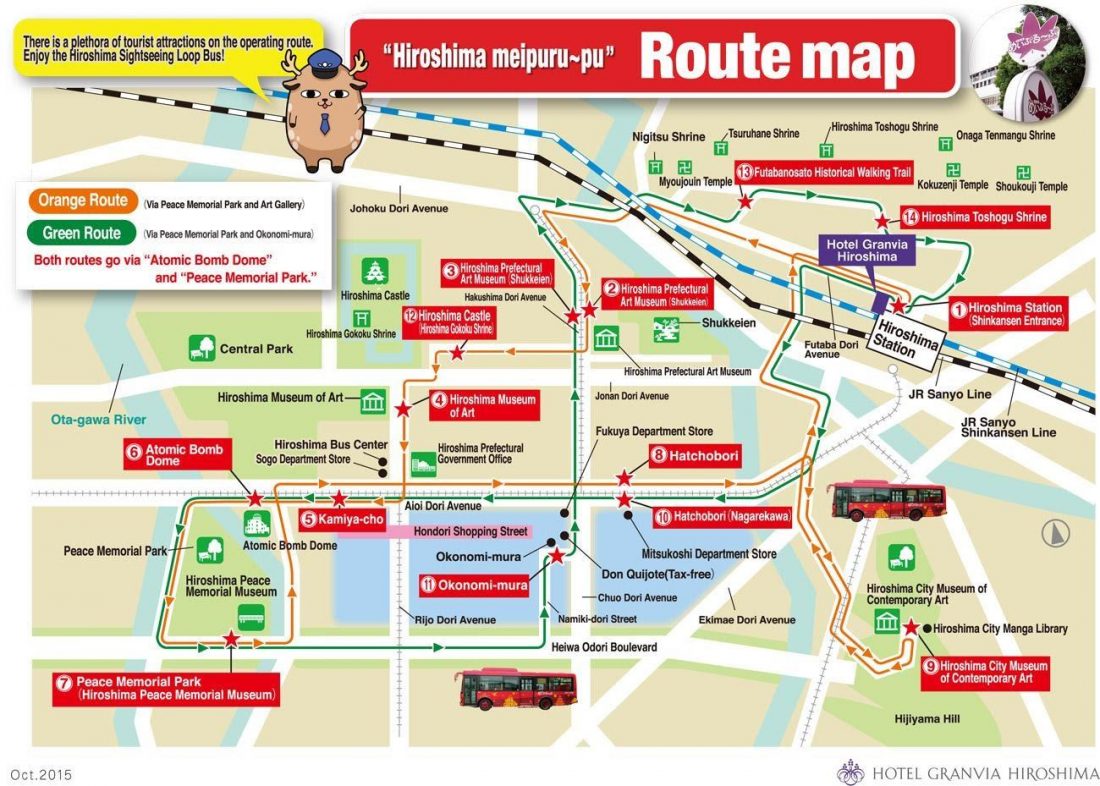
This map, provided by hgh.co.jp, outlines the “Meipuru~pu” bus routes. It does the same loops all day, every day, stopping at many of Hiroshima’s famous sights, passengers can get on and off at any stop. *Note the Meipuru~pu is not the usual city bus, so the fare and stops are different.
How to Pay for Public Transportation:
- Cash (not recommended if you plan to travel around a lot)
- IC cards (ex. ICOCA, Manaca, Suika, Paspy)
- Day passes (not recommended if you plan to be in the city for more than a day or two and plan to use more than one type of transportation BUT recommended if you are short on time) *Note: ask staff at Information Centers ex. in Hiroshima Station or the Bus Center, for more information.
What are IC cards and how to use them?
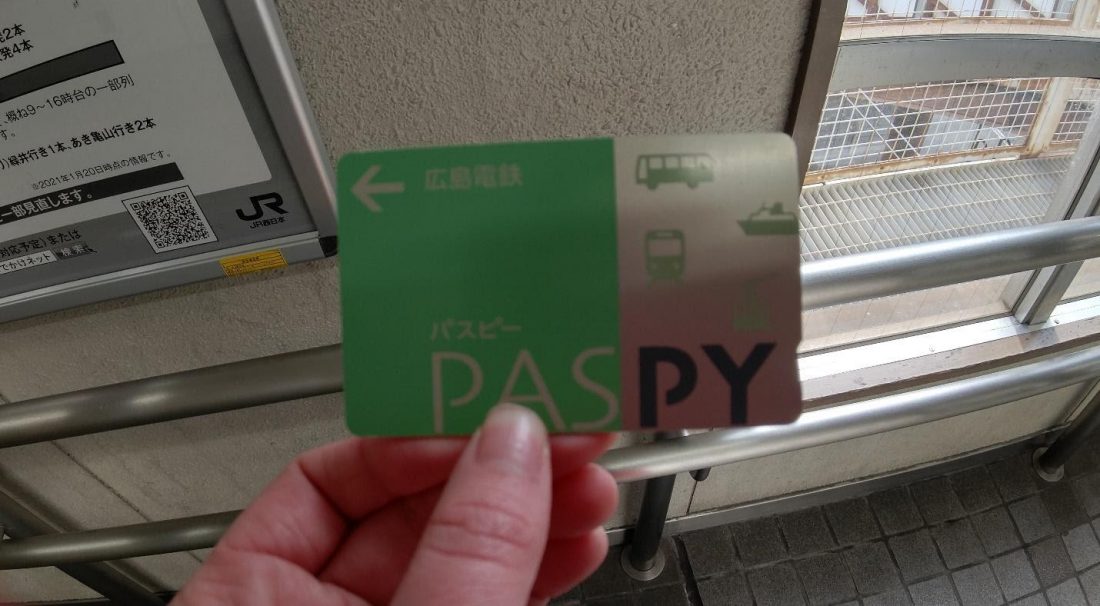
Hiroshima’s “ICOCA” IC card. Good for JR trains, streetcars, buses, rental bicycles and the Hatsukaichi Ferry to Miyajima (can also be used on JR trains throughout most of Japan).
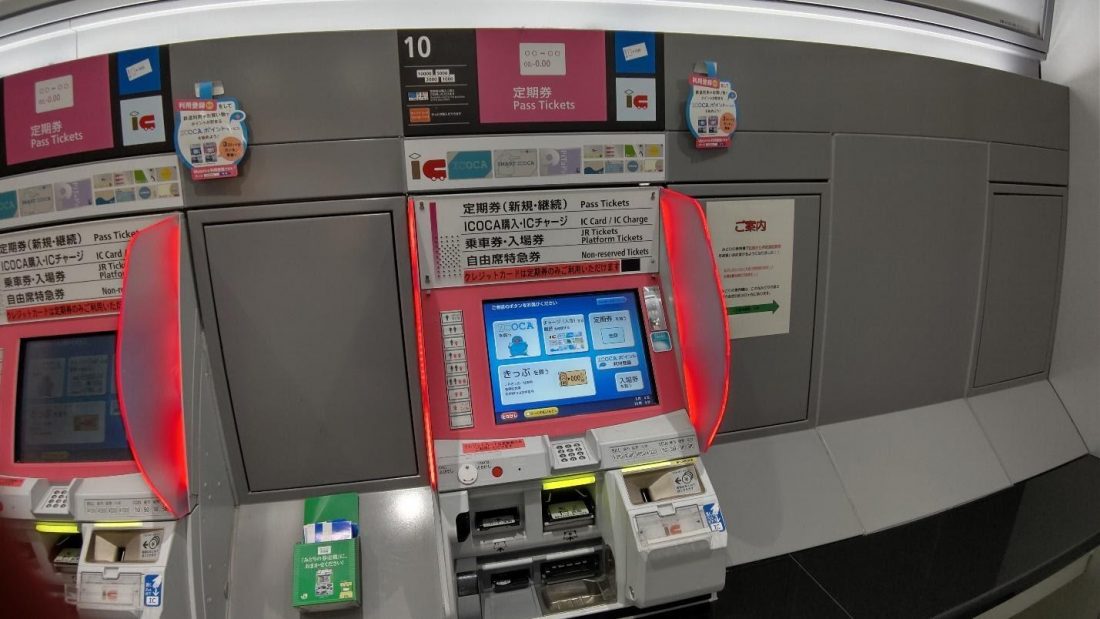
ICOCA cards are available for purchase at this machine, outside the JR ticket gates at Shininokuchi Station. Most major stations have these machines (with English instructions)
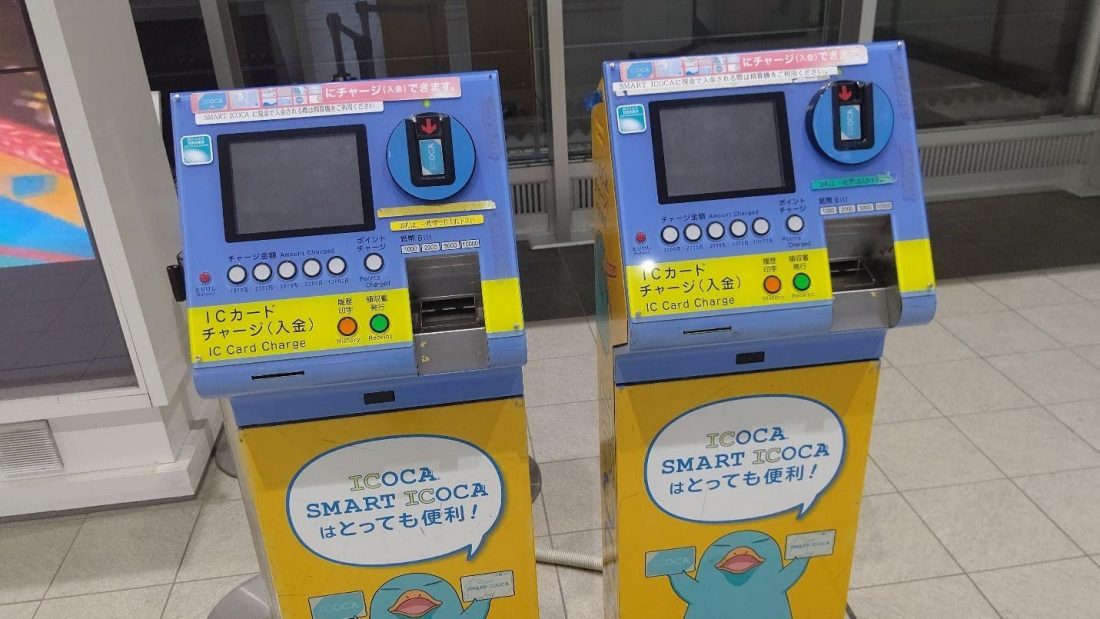
Charging machines for ICOCA by the JR ticket gates at Hiroshima Station (they always have English instructions)
Hiroshima’s Major Stations
There are several major stations in the city that provide different services.
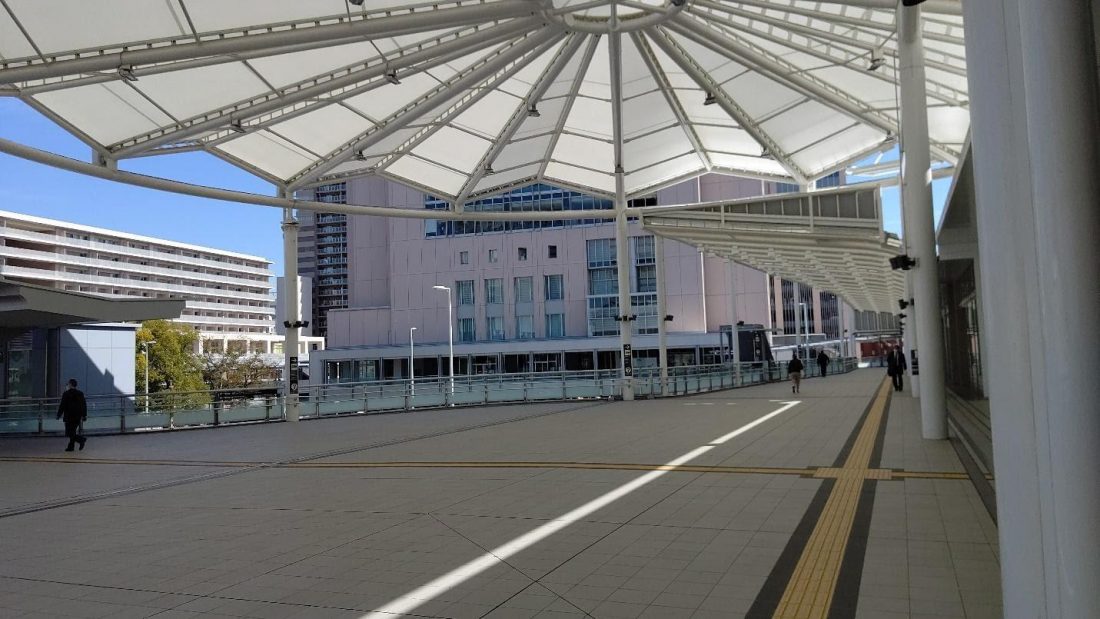
Walking path, second floor, North Entrance of Hiroshima Station
Many of Hiroshima’s visitors first arrive at Hiroshima Station because it has bullet trains, cross-country buses, and Hiroshima Airport buses. You can get almost anywhere in the city from this station because it has JR trains, city buses and streetcars.
Outside the North Entrance of Hiroshima Station there are:
- Cross-country bus terminals
- A Hiroshima Airport bus stop
- A Meipuru~pu bus stop
- Taxi pickups and drop offs
- Public parking
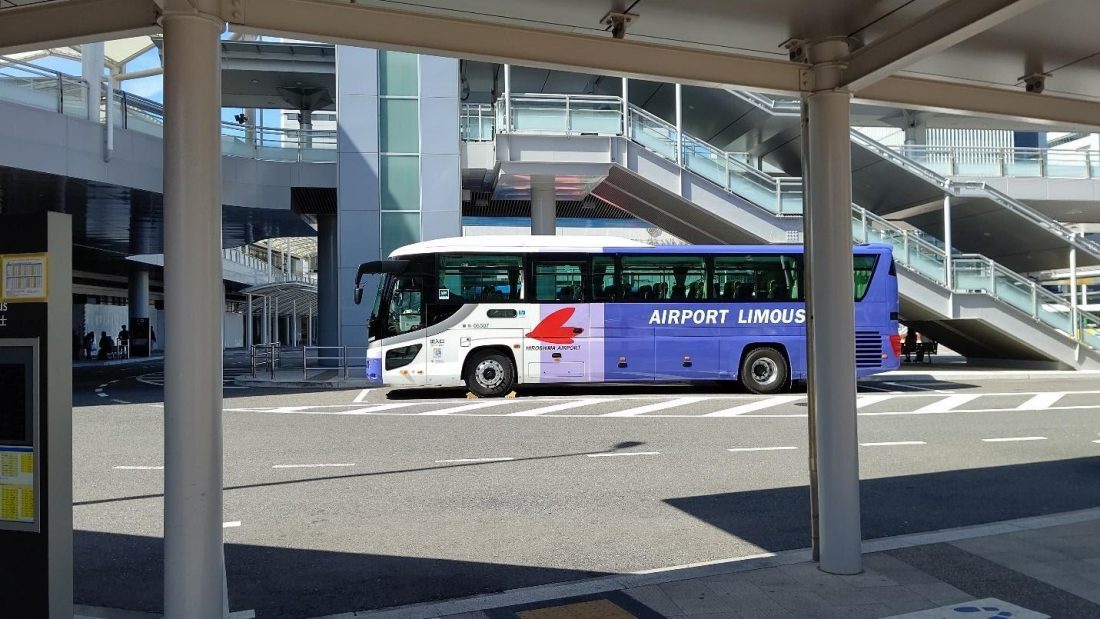
Ground floor bus terminals, outside the North entrance of Hiroshima Station
Outside the South Entrance of Hiroshima Station there are:
- City bus terminals
- Streetcar platforms
-Number 1 to Hiroshima Port (goes west through downtown but NOT as far as the Peace Memorial Park before heading south)
-Number 2 to Miyajima Guchi (goes west through downtown stopping at the north entrance of the Peace Memorial Park before continuing all the way to Miyajima Guchi)
-Number 5 to Hiroshima Port (goes straight south from Hiroshima Station past Hijiyama Park)
-Number 6 to Eba (goes west through downtown stopping at the north entrance of the Peace Memorial Park before going south)
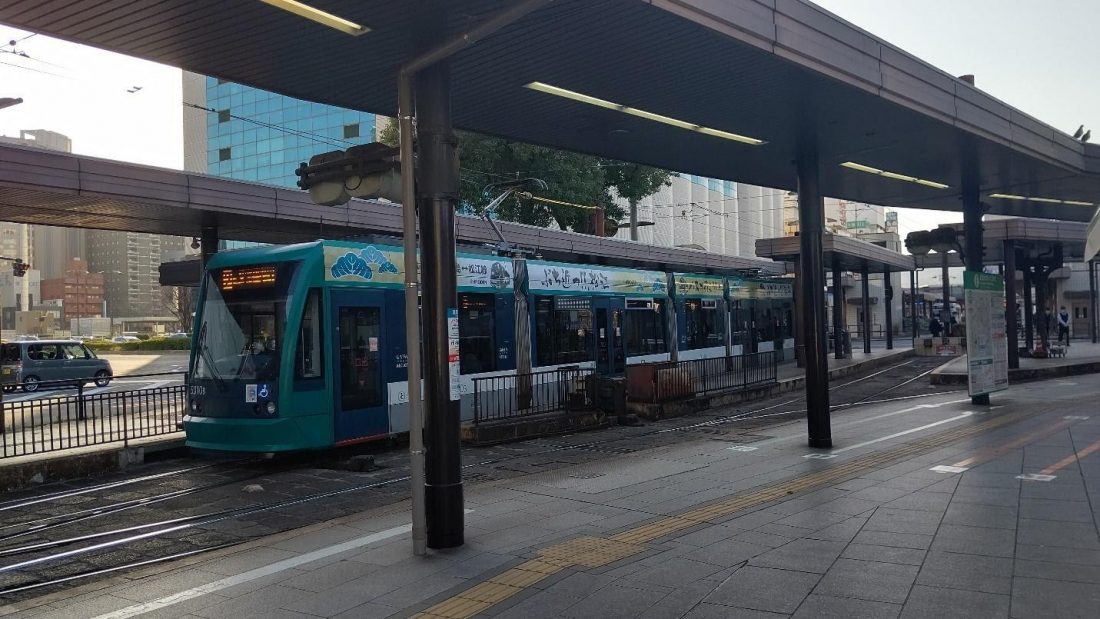
Ground floor streetcar terminals, outside the South entrance of Hiroshima Station
2 nd Floor, inside Hiroshima Station
- Information Center for Hiroshima city
- Bullet Train ticket counter and gates
- JR train ticket counter and gates
-Sanyo Line (goes east to west across the city)
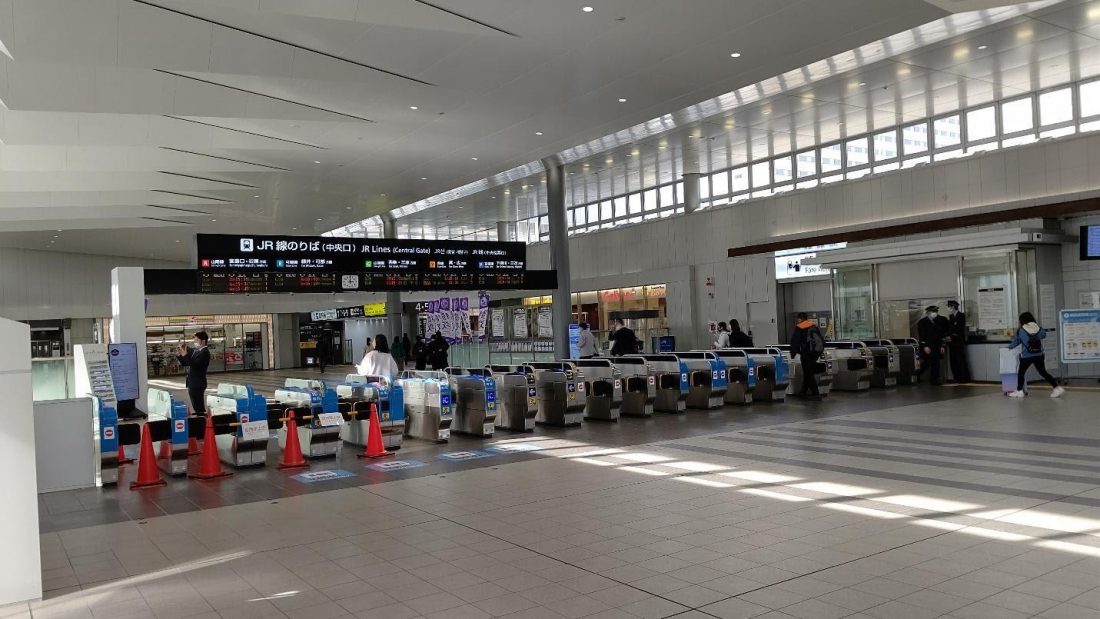
2 nd floor JR ticket gates, inside Hiroshima Station
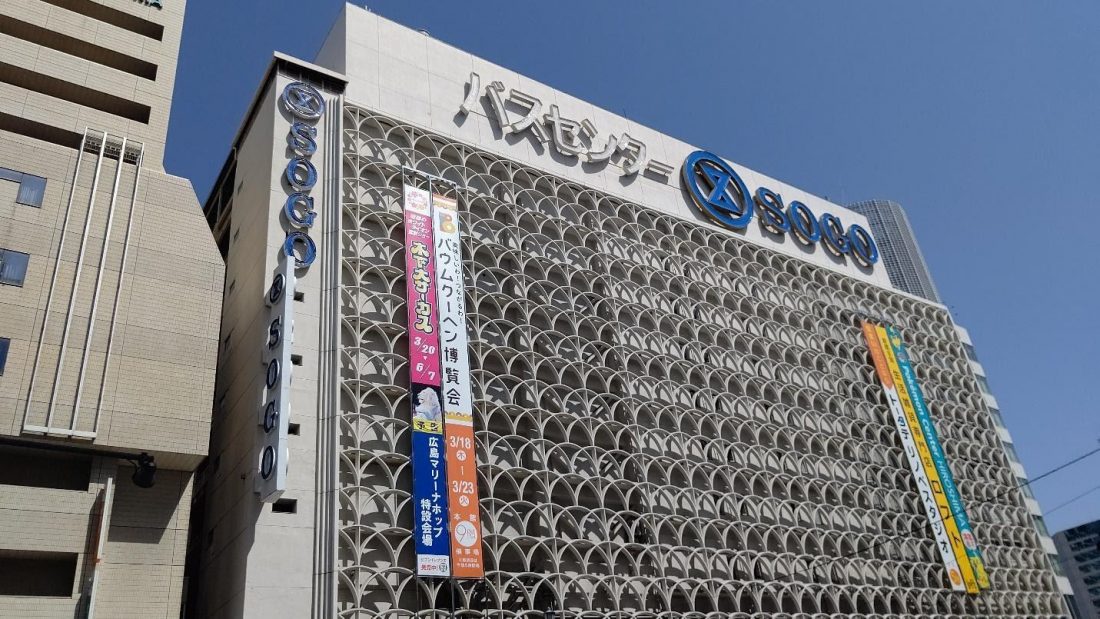
Hiroshima Bus Center and the SOGO Department Store
The Hiroshima Bus Center is on the 3 rd floor of a huge department store called SOGO. This is also a common place for newcomers to arrive in the city because it has cross-country and Hiroshima Airport buses. You can get to a lot of places in the city from the Bus Center because it has city and Meipuru~pu buses.
The Bus Center is a large transportation hub for the city, so they have an information center and ticket counters.
Other Major Stations in the City:
- 新白島駅 “shinhakushima eki” Shinhakushima Station
-JR Sanyo Line (east to west through the city)
-Number 9 streetcar (to Hachobori)
-Astramline (train system, separate from JR, that goes north to south across the city)
-City bus terminals
- 横川駅 “yokogawa eki” Yokogawa Station
-JR Kabe Line (north away from the city)
-Number 7 streetcar (to Hiroden Honsha Mae)
-Number 8 streetcar (to Eba)
- 西広島駅 “nishi Hiroshima eki” Nishi Hiroshima Station
-Number 3 streetcar (to Hiroshima Port)
電車 “densha” Trains
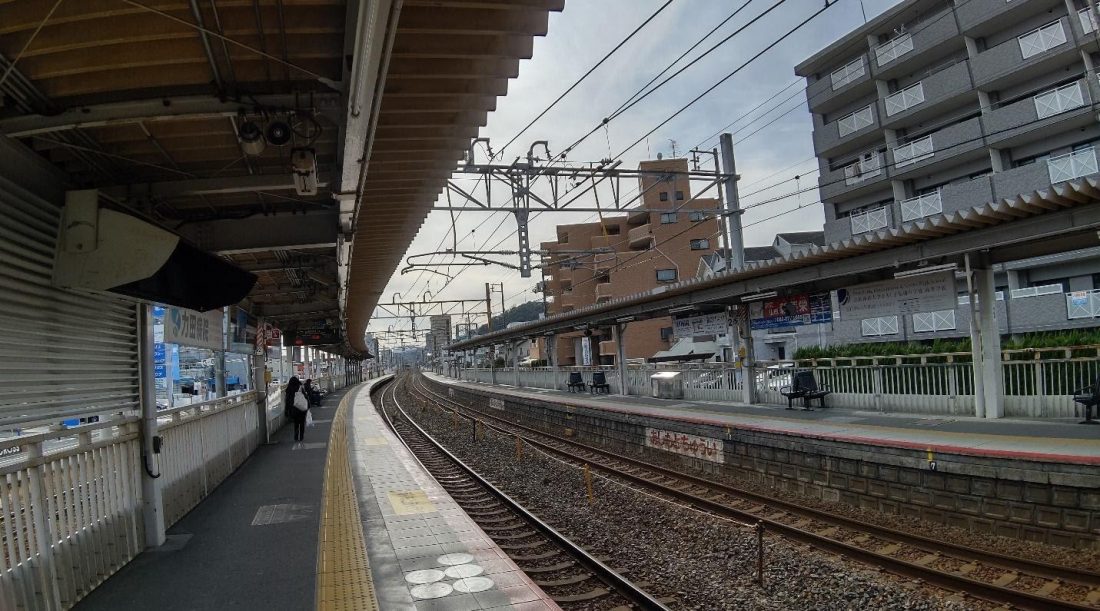
Hiroshima has two types of trains, the Japanese Railway (JR) system and the Astram line system. The JR system is government run and stretches across the whole country while the Astram line system is privately owned and local. Depending on your travel plans, you may prefer one to the other because they don’t go to the same places.
The trains are fast, affordable and reliable but they have limits to where they can go. I recommend taking them to neighboring cities like Kure, Onomichi and Hatsukaichi (where the island of Miyajima is). Other modes of transportation are usually the better option for within the city.
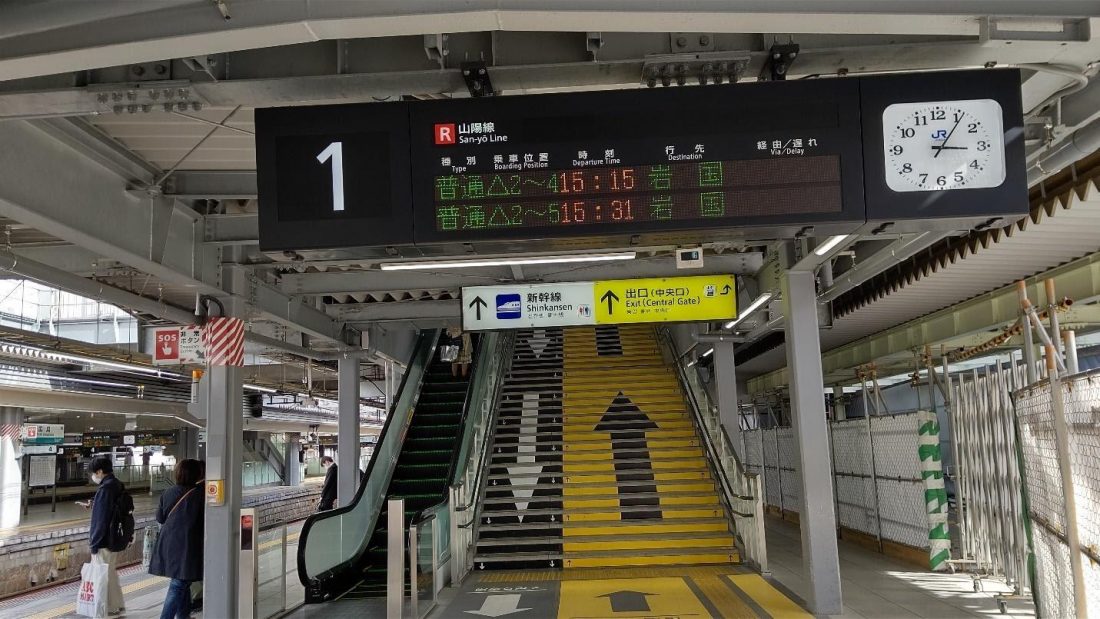
Platform #1, in Hiroshima Station, for the JR Sanyo Line bound for Iwakuni (stops at Miyajima Guchi)
Both JR and Astram function similarly so the following directions apply to both systems.
- Go through the ticket gates to get onto the platforms. *Note that there are always train staff around in case you have any questions but be aware that they may only know basic English.
- Past the ticket gates, refer to the signs that flash information between Japanese and English about the arrival time, destination name, platform number and other information about the coming trains. *Note that you may have to go over or under the tracks to get to another platform depending on which direction your train is going.
- Ride the train to your destination. *Note that trains are usually on time and come and go very quickly and if it is a “local” train it will stop at every stop but if it is an “express” train it will skip stops, make sure it won’t skip yours.
- At your destination, walk through the ticket gates to get out of the station by sticking the ticket in the slot or placing your IC card on the touch pad.
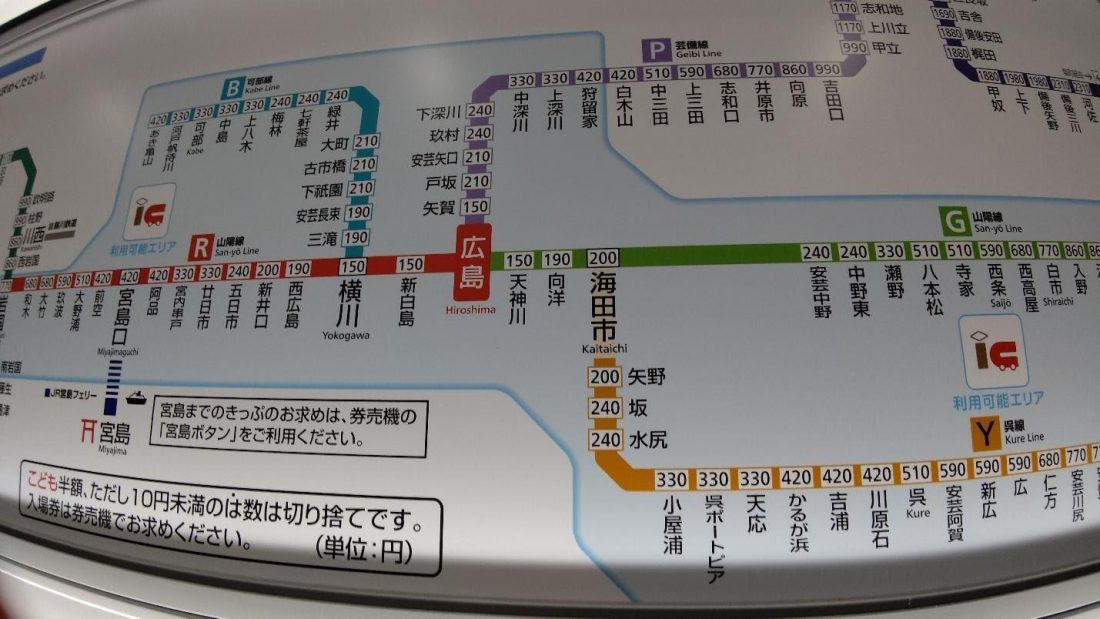
JR map above the ticket machines at Hiroshima Station. *Note the numbers by the destination names, those are the ticket prices when you’re coming from Hiroshima Station.
Buy a ticket at the machines outside the ticket gates. You have to match the destination name on the map above the machines with the ticket price on the screen. These machines accept both bills and coins and will give you change if you don’t have the exact amount. Instructions in English are available. Once you have your ticket, you can stick it in the slot of the ticket gate and walk through. *Note: DO NOT forget to take your ticket back as you walk through, you will need it again at your destination.
IC Card (*Note: JR doesn’t accept Paspy and Astram doesn’t accept ICOCA):
To pay with an IC card, place your card on the touch pad attached to the ticket gate and walk through (when your card is low on funds, the ticket gate will beep at you).
広電 “Hiroden” Hiroshima Electric Railway (Streetcar)
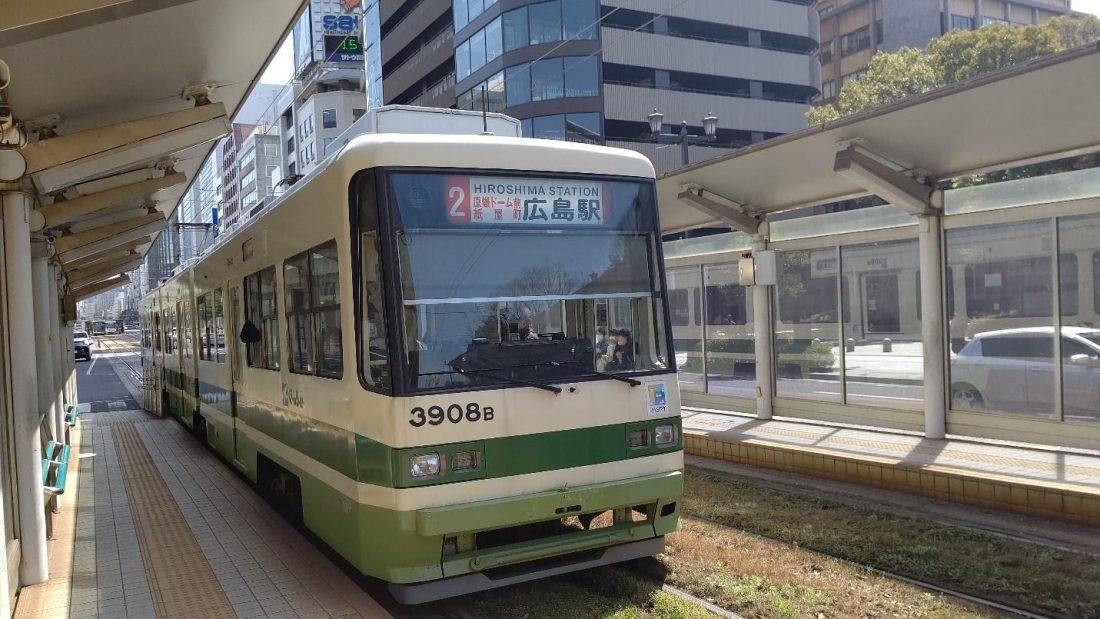
A Hiroden bound for Hiroshima Station, leaving from Genbaku domu mae
The official, English, name for Hiroshima’s streetcar system is the “Hiroshima Electric Railway” and the Japanese word for streetcar is 老麵電車 “roumen densha”, but locals refer to them as “Hiroden”.
Hiroden are a little slow, but they go all over the city, there is usually room for large bags, and they are one of the cheapest transportation options. I recommend using them to get around downtown (ex. the Peace Memorial Park and the Hondori shopping area). The Hiroden are also the most straightforward way to get to Hiroshima Port.
Navigating the Hiroden:
Most Hiroden “stations” are just small stops with a platform (usually unmanned). There will be a timetable and a list of the Hiroden routes that stop there.
- When the Hiroden arrives, step on, but avoid stepping in the doors with the driver or the ticketing staff.
- As you step on, there will be a touch pad for you to place your IC card. *Note: if you’re not paying with an IC card, you don’t have to do anything at this time.
- At your destination, leave the Hiroden through the driver’s door or the ticketing staff’s door.
- When you leave the Hiroden, place your IC card on the touchpad again. If you’re paying with coins, drop the coins into the slot provided. *Note: you will not get change back if you give too much.
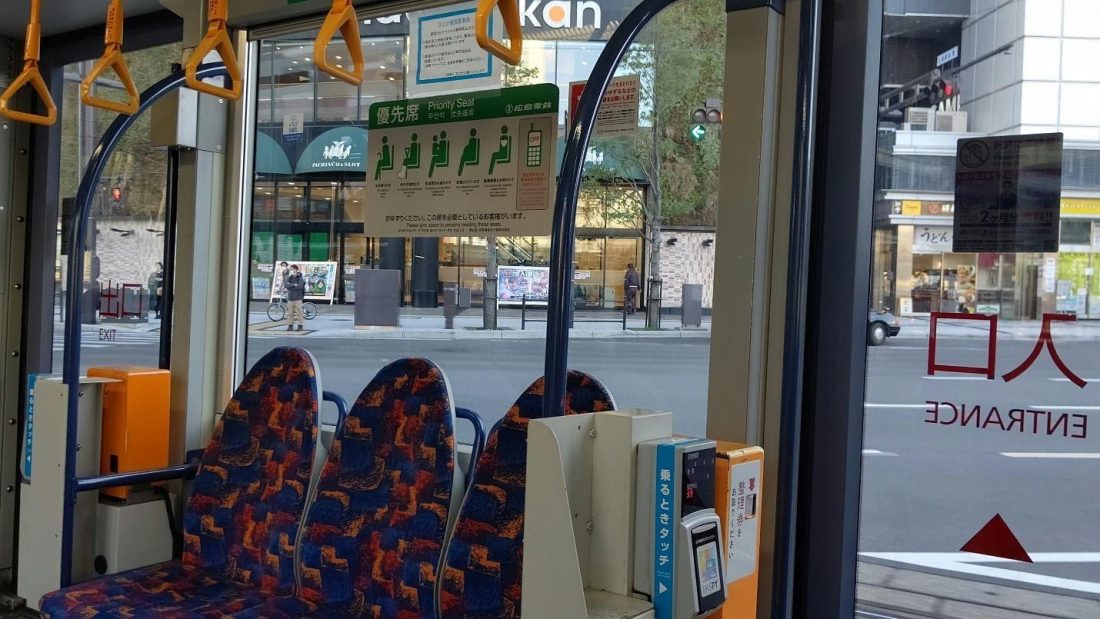
Inside the Number 2 Hiroden leaving from Hiroshima Station. *Note the IC card touch pad by the door.
Paying with Coins vs. an IC Card:
If you pay with coins on the Hiroden, you always pay as you get off. There is no “ticket” for the Hiroden so you can just walk on. You can figure out how much you owe by referring to the price charts inside the Hiroden, you just need to know the name of the stations you are getting on and off at. If you’re confused, you can ask the ticketing staff. However, the flat fare for an adult within the city is ¥ 190. When you get off, you have to pay in exact change. If you don’t have exact change, there are change making machines on the Hiroden. *Note: try to get your change ready before your destination so you don’t hold up the Hiroden.
IC Cards (*Note: Hiroden accept both Paspy and ICOCA but you can’t charge ICOCA here)
If you pay with an IC card, place your card on the touchpad as you get on and as you get off the Hiroden. When your card is low on funds, the touch pad will announce, “chajishite kudasai!” (please charge!). There are charging machines on the Hiroden. *Note: the charging machines on the Hiroden only accept ¥ 1,000 bills.
バス “Basu” Bus
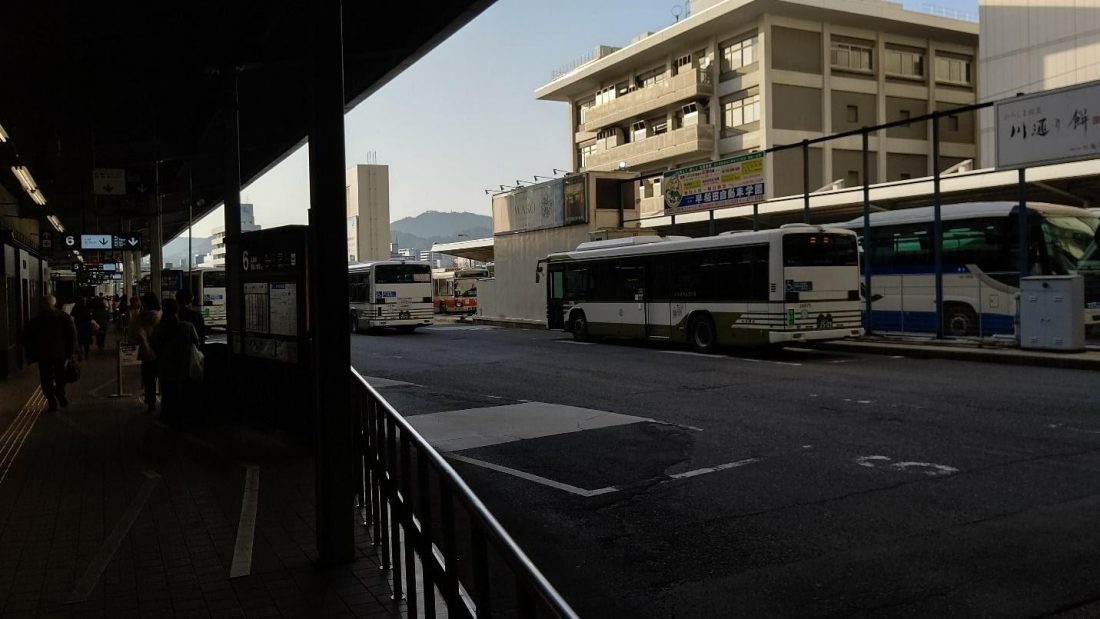
Buses lined up to leave Hiroshima Bus Center Hiroshima city has a lot of buses. They are arguably the most complex mode of transportation in the city, especially from a visitor’s perspective, and there isn’t a lot of extra room for luggage, but they go to the largest variety of places.
Most buses eventually stop at a major station, like Hiroshima Station, the Hiroshima Bus Center, or Yokogawa Station, and then proceed along their route, stopping at small, designated stops.
Buses are really handy for getting to the more remote places. I recommend using a bus to get to places like The Outlets Shopping Center, the Aquarium and the Botanical Gardens.
The Meipuru~pu routes are a separate system from the city bus routes but they are convenient if you are short on time and want a straightforward way to see all of the famous sights in the center of town (ex. the Peace Memorial Park, Hijiyama Park, Hiroshima Castle).
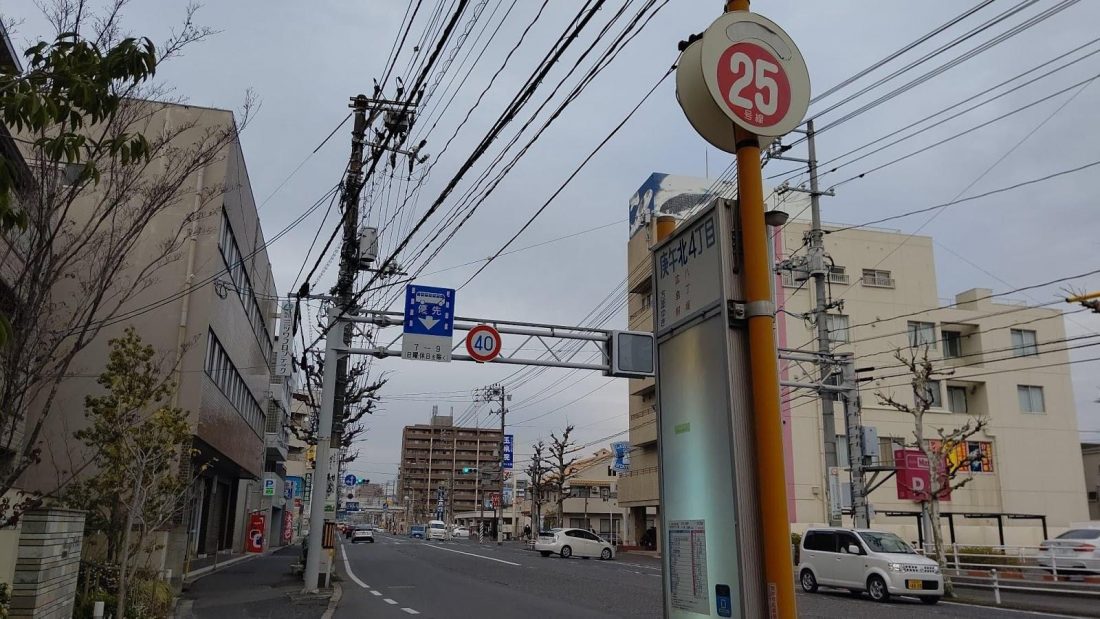
A bus stop in Nishi-Ku for the number 25 bus.
Bus terminals at major stations will have large signs indicating the destination name and platform number for the buses. However, out in the city, most bus stops are just a marker on the side of the road. These markers will have timetables and a list of the bus routes that stop there. *Note that there could be several bus stops close to each other but they belong to different bus routes, make sure you’re standing by the right one.
- When your bus arrives, make sure you’re standing close to the marker so the bus driver knows you wish to take the bus (buses don’t stop if no one appears to be at the marker).
- Avoid getting on the bus through the driver’s door, and take a ticket if you plan to pay with coins or place your IC card on the touchpad.
- There is a screen at the front of the bus that shows which stop is coming up next (in both English and Japanese), there will also be an announcement (but often not in English).
- When you know your destination is the next stop, press a button within reach that says 止まれ “tomare” stop. *Note the bus will not stop if no one presses the “stop” button.
- At your destination, get off at the driver’s door, place your IC card on the touchpad again or drop your coins in the slot. *Note you will not get change back if you give too much.
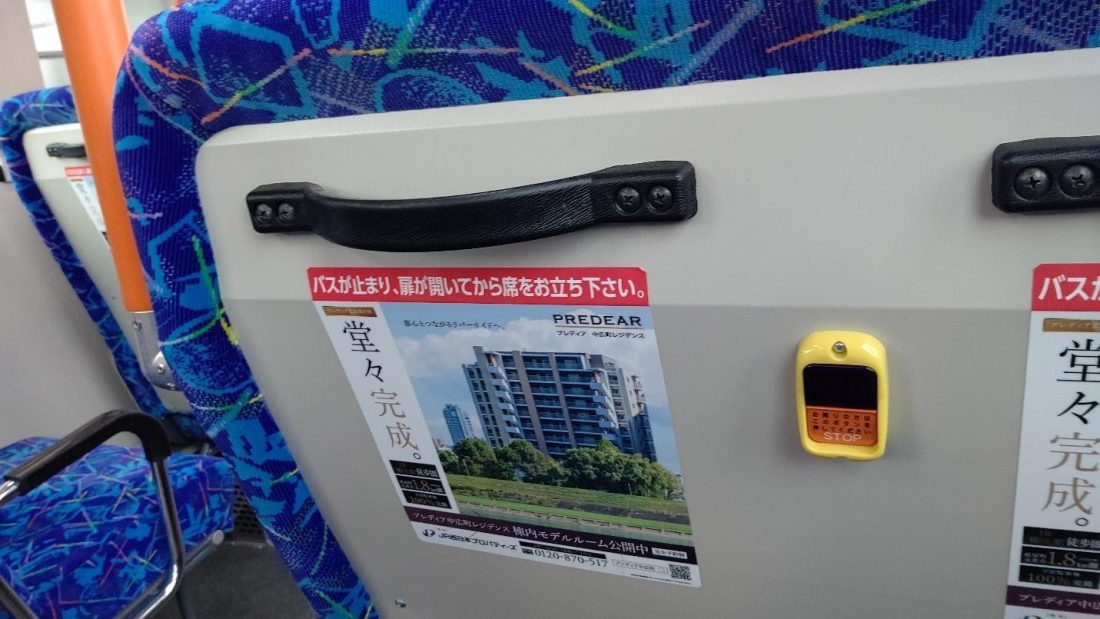
“stop” button on the back of a seat on a city bus.
Paying with coins vs. an IC Card
If you pay with coins on the bus, you always pay as you get off. The “ticket” you take is so you can keep track of where you got on the bus. You can figure out how much you owe by matching your ticket with the prices on the screen in front of the bus. The price of a bus trip is always affordable but they vary so you have to pay attention. If you don’t have exact change, there are change making machines on the bus. *Note: try to get your change ready before your destination so you don’t hold up the bus.
IC Cards (*Note: buses accept both Paspy and ICOCA but you can’t charge ICOCA here):
If you pay with an IC card, place your card on the touchpad as you get on and as you get off the bus. When your card is low on funds, the touch pad will announce, “chajishite kudasai!” (please charge!). There are charging machines on the bus by the driver. *Note: the charging machines on the bus only accept ¥ 1,000 bills.
Suggestions and Other Important Points:
- Stay behind the yellow line on the platform until the train/streetcar comes to a complete stop (you will get yelled at by staff if you don’t)
- Step aside to let disembarking passengers off before you step on
- Speak quietly when you’re on the train/streetcar/bus
- No eating on any public transportation unless you are in a seat on a train specifically
- If you have large bags or luggage, keep it in front of you, especially during busy times (it’s easy for people to trip on or get smacked by big bags in tight corners)
- The worst of rush hour is weekdays between 7am-9am and between 5pm-7pm, I recommend avoiding these times if you have large bags (or if you don’t like crowds)
- Major station names always have English but some of the smaller stations don’t, if you need to go to smaller stations, knowing what the station name looks like in Japanese is a good idea
- Trains stop running between 11pm-12am and don’t start running again until between 5am-6am. Streetcars and buses stop running between 10pm-11pm and don’t start running again until between 5am-6am.
Other Modes of Transportation
You might come across a few other ways to get around as you explore the city. Let’s briefly go over them so you know what’s right for you.
Transportation on the Water:
Hiroshima boarders the 瀬戸内海 “seto naikai” the Seto Inland Sea, and the city itself has a lot of rivers. This makes for a fair amount of boat travel options.

The little port on the Motoyasu River by the Peace Memorial Park. These boats go to Miyajima and Hiroshima Station.
There is a port for river boats on the Motoyasu River by the Peace Memorial Park and on the Enko River by Hiroshima Station. The boats that go between these two ports double as transportation and a sightseeing tour because English speaking guides talk about the city as you cruise up and down the rivers. The port on the Motoyasu River also has a boat that goes all the way to Miyajima and back. I recommend this if you are short on time and wanting to leave from and/or come back to the Peace Memorial Park area. It is the fastest and most straightforward way to get between the city’s two most famous landmarks (the A-Bomb Dome in the Peace Memorial Park and Itsukushima Shrine’s gate in Miyajima). You pay for your boat tickets beforehand, either at the port’s ticket counter or online.
Here is a link to check out more:
https://www.hiroshima-water-taxi.com/english/
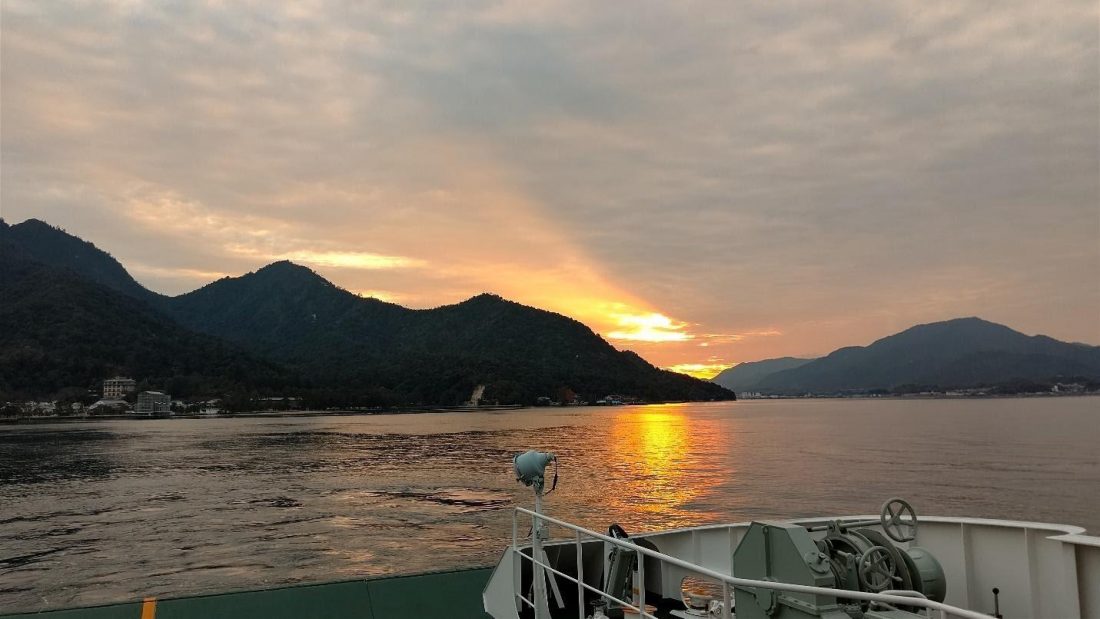
View from the Ferry leaving Miyajima Island for the Ferry Port in Hatsukaichi. The mountains in the foreground are part of Miyajima island.
Hiroshima Port is the city’s largest port and it has a wide variety of boats that go to Miyajima, all over the Seto Inland Sea and beyond. If you are interested in exploring more of this part of Japan, Hiroshima Port is a good place to go.
There is a smaller port by Hiroshima’s Aquarium called Marina Hop Mariho. It is possible to get boats from here to Miyajima as well.
The most common way for both locals and tourists to get to Miyajima is to take the JR or the Hiroden to Miyajima Guchi in Hatsukaichi city and then taking the ferry to the island. The ferry port is only a 5-to-10-minute walk from both the JR and Hiroden stations.
How you get to Miyajima depends on where you are in the city and how you want to get there. Leaving from Hiroshima Port or Marina Hop is going to be more expensive but the boats from these places usually include a meal and entertainment/a tour of the Seto Inland Sea during your journey. Leaving from the port in Hatsukaichi is much cheaper and you can use an IC card but there is no food or entertainment, it’s just a ride.
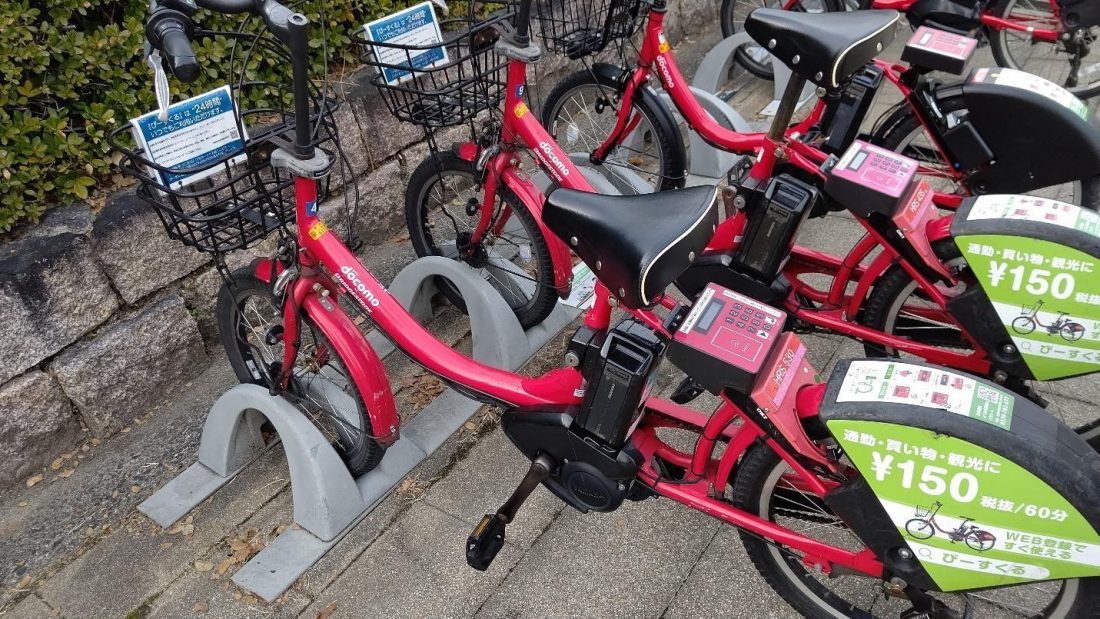
A Rental Bicycle port by Hiroshima Castle.
If you like exploring places via a bicycle, this might be a good choice for you. There are rental bicycle ports all over downtown and a few off the beaten path. They are easy to spot because they are bright red, and they are electric, making them very easy to peddle. The idea is “bicycle sharing”, so you take a bike, use it, and return it to a port when you’re done.
The local Rental Bicycle company is called ぴーすくる “Pi-sukuru” and they have “ticket counters” all over the city where you can get more information.
If you are only going to be in town for a couple days and you’re interested in this, I recommend going to one of the ticket counters and signing up for day passes in person. If you’re going to be here a while, you should become a member because it’s cheaper in the long run. However, it can be kind of a pain to set up, but once you are it’s really easy. You become a member online with your phone number, email, and credit/debit card info and they send you a passcode. With that passcode, you can enter it on the bike’s keypad every time you want to rent a bike, or you can use it to register your IC card and then use that every time you rent a bike.
Here is a link to the Pi-sukuru’s website:
https://docomo-cycle.jp/hiroshima/en/
Hiroshima Transport
- Published on : 09/09/2017
- by : Japan Experience
- Add to favorites
Hiroshima Station
Hiroshima trams.
- Astram Line
Hiroshima Buses
Maple sky tour bus, visit hiroshima tourist pass, hiroshima travel 広島交通.
Hiroshima , the prefectural capital of Hiroshima Prefecture, is one of Japan's most visited cities.
Tourists are drawn by Hiroshima Peace Park , Hiroshima Castle , Hiroshima's many fine museums along with the sacred island of Miyajima , with its iconic torii gate standing in the sea.
Find information on getting to and around Hiroshima by public transport.
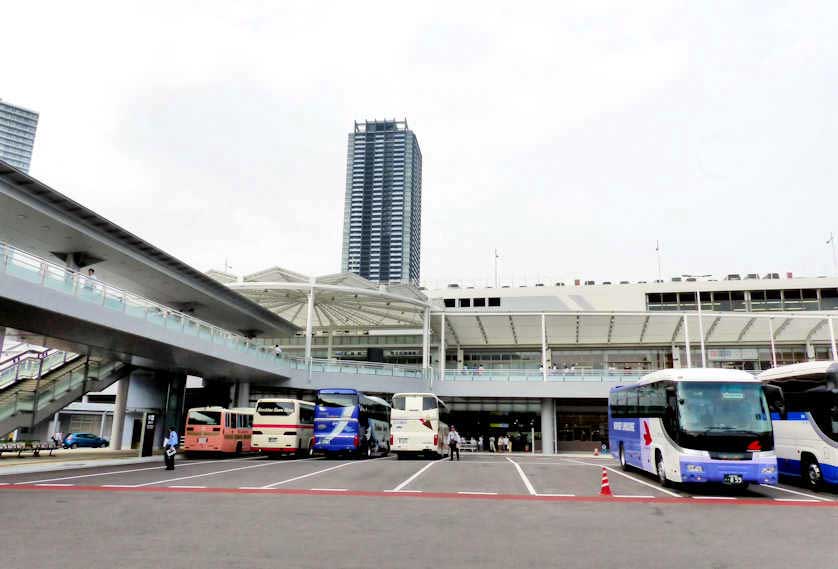
The recently remodelled and refurbished Shinkansen Exit (north side) of Hiroshima Station
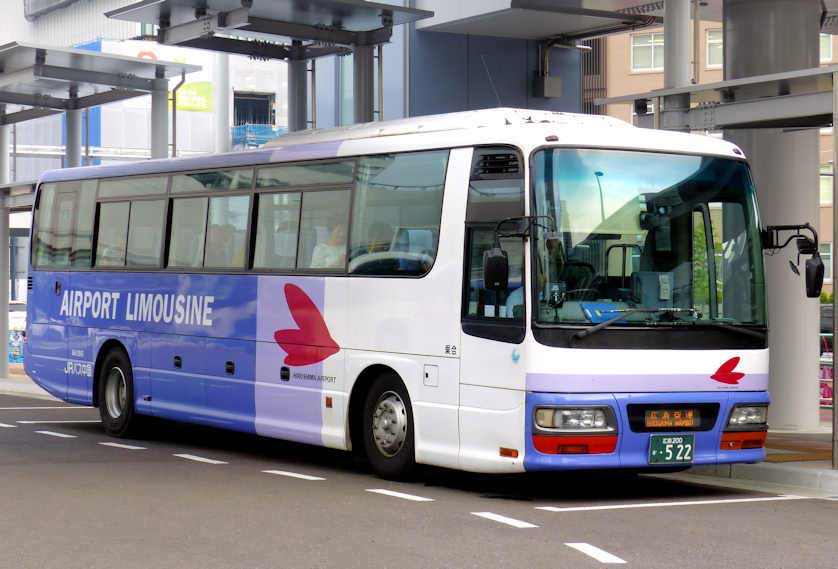
Airport Limousine from Hiroshima Station to Hiroshima Airport
Hiroshima Station is the main point of access for arriving in the city, with shinkansen trains coming from Tokyo , Yokohama , Nagoya , Kyoto , Osaka , Shin-Kobe and Okayama Station in Okayama to the east and Fukuoka and Yamaguchi to the west.
As well as taxis and a few local buses all the inter city highway buses and Airport Limousine buses start from Hiroshima Station before making a stop at Hiroshima Bus Center in the Sogo Department Store, north east of Hiroshima Peace Memorial Park. A new ticket office for the Airport Limousine can be found in front of the station and there are ticket vending machines when the office is closed.
There are also long-distance buses to Tokyo ( Tokyo Station , Shinjuku Bus Station ), Yokohama, Universal Studios Japan (USJ), Fukuoka, Okayama, Kurashiki, Kobe, Kochi, Kyoto Station , Osaka, Nagoya Station , Nagasaki (with a change in Fukuoka), Matsue, Hamada, Imabari, Takamatsu, Tabuse, Yanai, Izumo , Tokushima, Yuda Onsen and Yonago.
There is free internet access within Hiroshima Station including in the smoking room.
Hotels are clustered close to both the North and South exits of Hiroshima Station: places to choose from include the Hiroshima Garden Palace, the 90-room APA Hotel Hiroshima Ekimae, the Hiroshima Intelligent Hotel, Hotel Granvia Hiroshima, the 238-room Sheraton Hiroshima Hotel, the 250-room Hotel New Hiroden and Business Hotel Yorishiro.
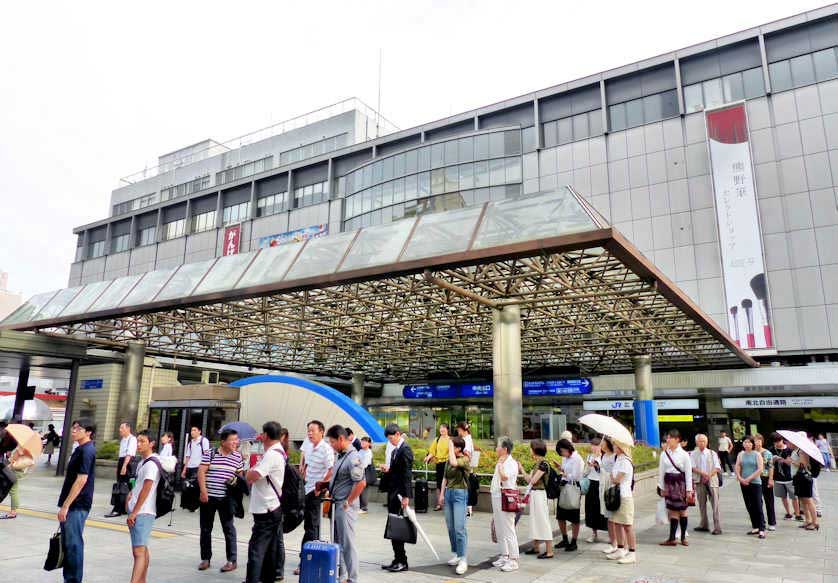
Main Entrance (south) of Hiroshima JR Station. Taxis, buses, and the main terminus of the tram system are found here
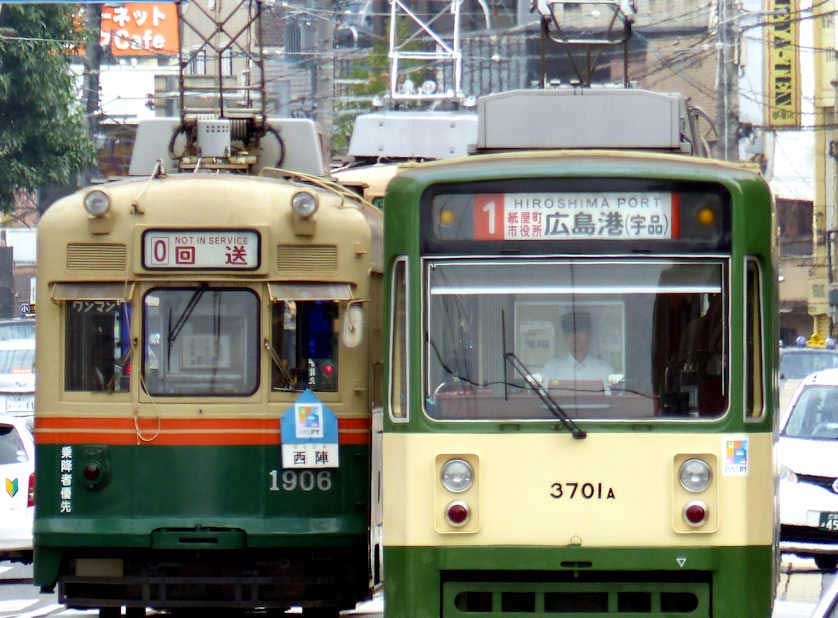
Hiroshima trams are operated by Hiroden
The Hiroshima Electric Railway or Hiroden runs the trams (streetcars) in Hiroshima city and Hiroshima Prefecture, the longest and most used streetcar network in Japan.
There are six tram lines in central Hiroshima and over 270 trams from all over Japan as well as some from Europe, which makes a ride on Hiroshima's trams a popular tourist activity and a must-do while in the city. The Green Mover Max tram that runs on the network is the first tram wholly built in Japan. Hiroshima's trams were imported from overseas beforehand. Two antique streetcars that survived the 1945 atomic bombing of the city still run on the network.
The eight numbers for the trams are:
# 1 (Orange) runs from Hiroshima Station to Hiroshima Port # 2 (Red) runs from Hiroshima Station to Miyajima-guchi # 3 (Blue) runs from Nishi-Hiroshima Station to Hiroshima Port # 5 (Green) runs from Hiroshima Station to Hiroshima Port # 6 (Yellow) runs from Hiroshima Station to Eba # 7 (Dark Green) runs from Yokogawa Station to Hiroden honsha-mae # 8 (Pink) runs from Yokogawa Station to Eba # 7 (Gray) runs from Hachobori to Hakushima
PASPY is the local IC card valid on all local transport. The flat fare on the tram within Hiroshima city limits is 180 yen and 280 yen to Miyajima.
www.hiroden.co.jp
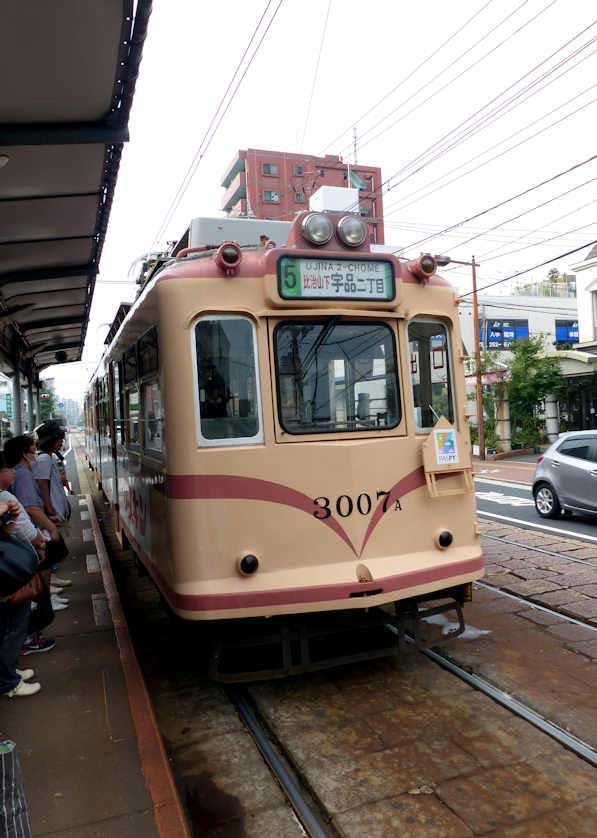
Hiroden trams in Hiroshima
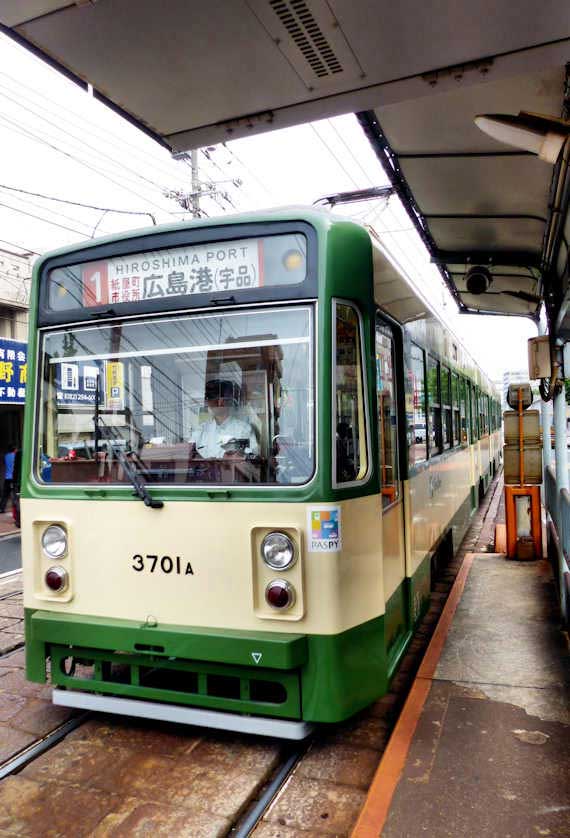
Hiroden tram to Hiroshima Port
The Astram Line (アストラムライン) is a rubber-tired transport system that runs 18km from Hondori Station in downtown Hiroshima to Koiki-koen-mae Station near to the Big Arch Stadium. The Astram Line was built to bring visitors to the Big Arch - the venue for the 1994 Asian Games.
The Astram is useful for getting to the Hiroshima City Transportation Museum - a fun museum located close to Chorakuji Station on the Astram Line in Asaminami-ku.
The Astram Line connects with the Hiroden at Hondori and Kencho-mae stations, the JR Kabe and Sanyo lines at Shin-Hakushima Station and the Kabe Line again at Omachi Station.
The present fare to Koiki-koen-mae Station from Hondori is 480 yen.
www.astramline.co.jp
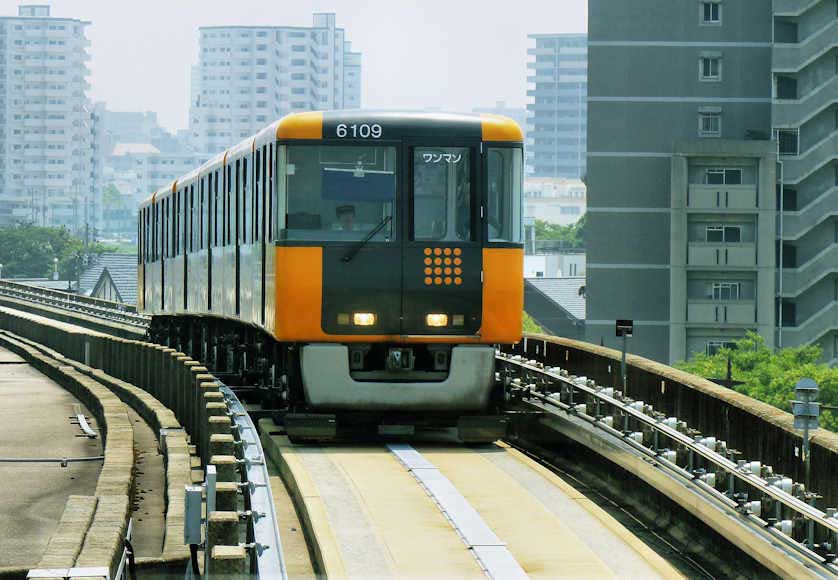
Astram, Hiroshima
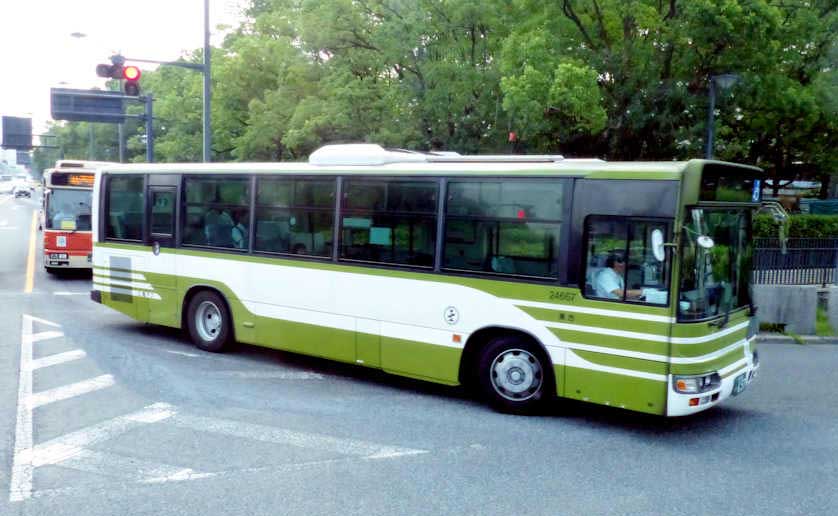
Hiroden Bus. The biggest local bus company in Hiroshima is Hiroden who also operate the tram system and run inter-city express buses. Their buses have olive green and white livery
Hiroshima city buses are operated by two companies: Hiroden and Hiroshima Bus Company (Hiroko).
Hiroden is the biggest local bus company in Hiroshima and also operate the tram system and a number of inter-city express buses. Hiroden buses have an olive green and white livery.
Hiroshima Bus Company ( www.hirobus.co.jp ) buses have a red and white livery.
Local city buses radiate out from both Hiroshima Station and Hiroshima Bus Center.
Enter the bus through the middle door and exit via the front door. The name of the next stop and the fares are displayed on a monitor at the front of the bus. Press the bell before you get off at your desired stop. There is a change machine next to the driver for 1000 yen notes and 500 yen, 100 yen and 50 yen coins. The fare to Hondori from Hiroshima Station is 160 yen and 220 yen to Hiroshima Peace Park.
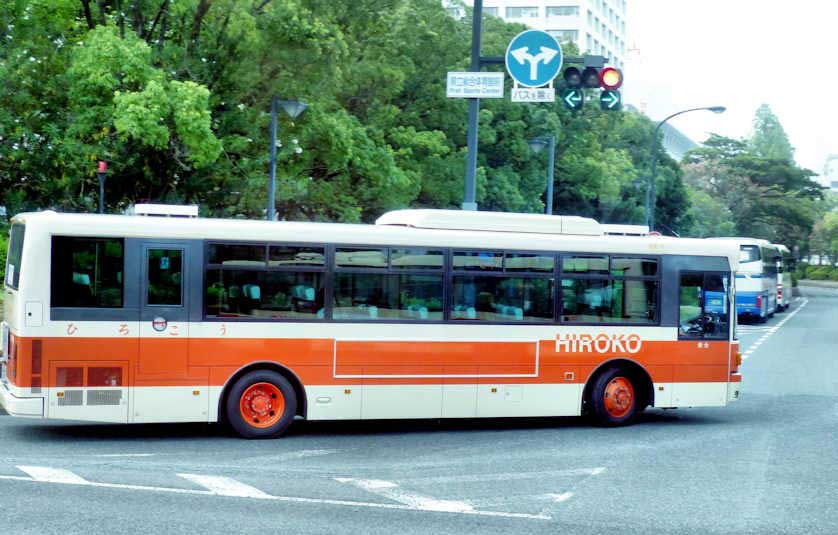
Hiroshima Bus Company (Hiroko) with their red and white livery are also a big local bus company
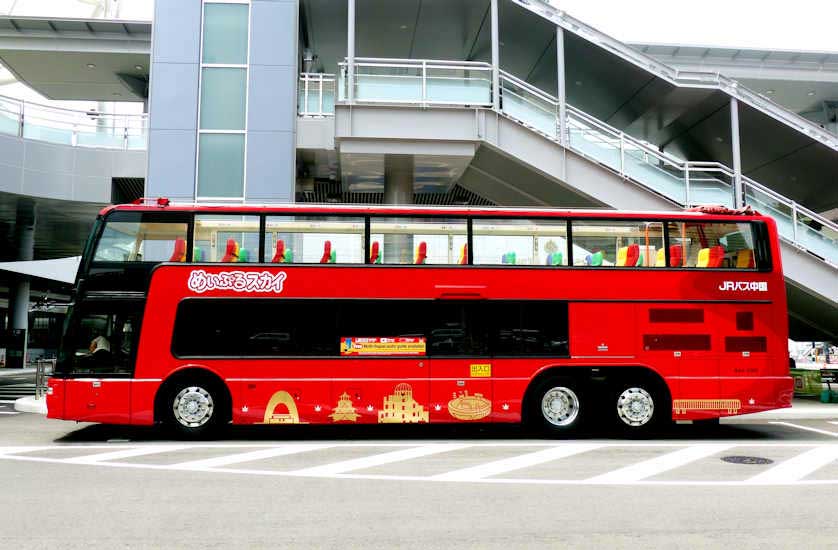
The Maple Sky open double-decker tour bus takes 90 minutes to visit most of the major tourist attractions in Hiroshima, including Hiroshima Castle, the Atomic Bomb Dome, Peace Park, Mazda Stadium and includes views of the outlying islands and the sea.
The cost of the Maple Sky bus is 2,000 yen for adults and 1,000 yen for kids under 12. A free audio guide in either English, Chinese or Korean is available. For the same price a second course includes a walking tour of the Peace Park and misses the sea views, but takes two hours.
The Maple Sky Tour Bus runs throughout the year on Fridays, Saturdays, Sundays, National Holidays , Golden Week and through the summer vacation. The bus departs from the Shinkansen gate on the north side of Hiroshima Station at 10.10am. An afternoon departure at 1.10pm does not operate in winter, and an evening departure at 7.10pm operates only in the summer. In the winter a special evening service operates to view Hiroshima Dreamination, the city's illumination event.
www.chugoku-jrbus.co.jp/teikan/meipurusky
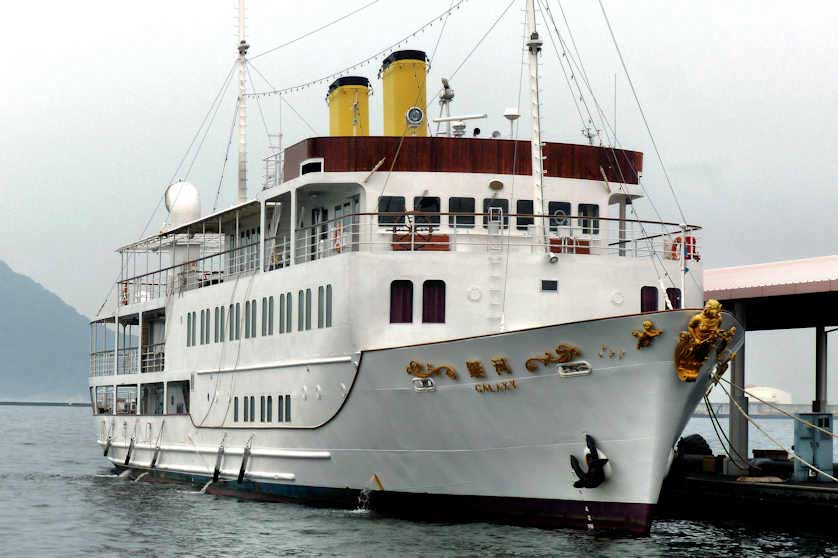
Galaxy, the dining cruise boat
There are ferry connections from Hiroshima Port (Ujina Port) to various outlying islands in the Inland Sea and Shikoku.
These include boats to Miyajima, Innoshima , Okunoshima and Etajima for the Old Japan Imperial Naval Academy .
Boats to Miyajima for Itsukushima Shrine cost 180 yen from Miyajimaguchi Port with either JR Miyajima Ferry or Miyajima Matsudai Kisen.
Boats to Etajima cost 1,060 yen from Hiroshima Port; ferries to Innoshima are 620 yen from Mihara Port and Okunoshima is 310 yen from Tadanoumi Port in Takehara .
Hiroshima - Matsuyama Tourist Port in Matsuyama with Ishizaki Kisen ( www.ishizakikisen.co.jp ) and Setonaikai Kisen ( setonaikaikisen.co.jp ) in 2 hours, 40 minutes by car ferry or 1 hour, 8 minutes by direct high speed boat.
More information including full timetable and fares for Hiroshima-Kure-Matsuyama ferries.
There are lunch and dinner cruises in the Inland Sea offered by Hiroshima Bay Cruise Ginga (Galaxy) - Tel: 082 253 1212.
Taxis ranks can be found at Hiroshima Station and Hiroshima Peace Park. Flag fall ranges between 580 yen-640 yen. Taxi companies operating in Hiroshima include:
Hiroshima Kintetsu Taxis: 082 253 2235 Hiroshima Taxis: 082 292 2121 Hiroshima Daiichi Kotsu: 082 278 5511 Tsubame Kotsu: 082 221 1955
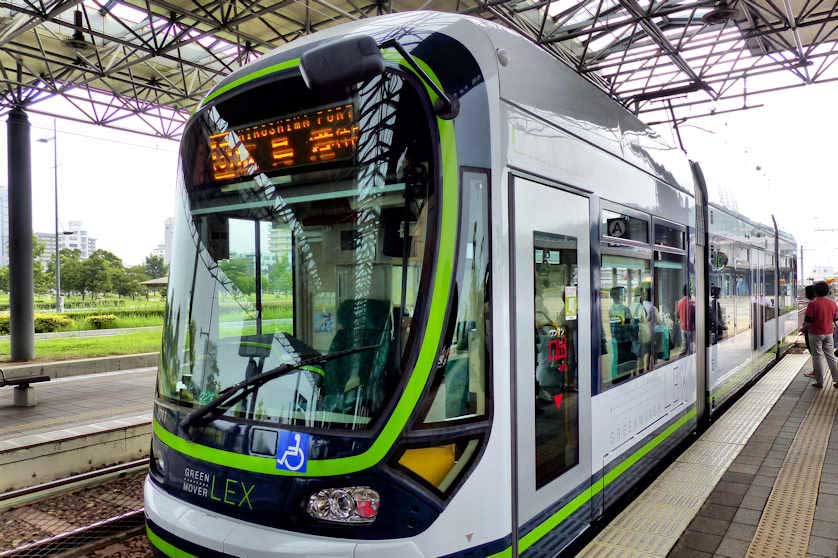
Green Mover Hiroshima tram to Hiroshima Port
The various Visit Hiroshima Tourist Passes offers foreign visitors to Hiroshima unlimited travel on Hiroshima's transport systems for a limited period.
There are four passes available: the Small Area Pass, covering Hiroshima city and Miyajima (1,000 yen for 3 days), the Small Area with Airport Limousine Bus Pass (4,000 yen for 5 days), the Wide Area Pass which covers all of Hiroshima Prefecture (3,000 yen for 3 days) and the Wide Area with Airport Limousine Bus Pass (6,000 yen for 5 days).
Guide Books on Japan
Hiroshima transport: read a guide to transport in Hiroshima including Hiroden trams, city buses, the Astram Line, ferries and taxis.
Latest Articles
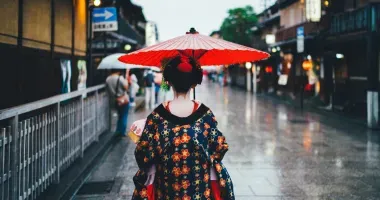
What to do during the rainy season?
Japan, with its well-defined seasons, has a special period called tsuyu or rainy season , which generally runs from early June to mid-July

Japanese giant salamander: The fascinating endemic amphibian of Japan
The Japanese giant salamander (Andrias japonicus) is an incredible amphibian species endemic to Japan.

The sika deer : A fascinating species native to East Asia
The sika deer (Cervus nippon) is a captivating species native to much of East Asia, including Japan, Taiwan, eastern China, Korea, and parts of Russia.
All the themes of the city

Japanese Food and Drink

Books on Japan

Japanese Movies

Japanese Language

Japanese History

Understanding Japan

Before you Travel
Please select your country on the list below:
- Switzerland
- United Kingdom
- Other countries
Copyright 2014 Chugoku JR Bus Company. All rights reserved
Japan Bus Lines - Highway bus, night bus in Japan

- JBL Bus search
- Airport bus line
- Method of Payment
- Changing or Cancelling your Booking
- Cancellation Policy
- Luggage and Pets
- About Boarding and Arrival Locations
- Bus Etiquette
- JBL Membership
- JBL Membership Terms
- JBL Terms of Membership Cancellation
- Japan Airport Transportation
- Japan Bus Tourism Information
- Non member booking

A round-trip pass to travel around Hiroshima area for 1 day, 2 days and 3 days

A round-trip pass to travel around Hiroshima area for 3 days and 5 days
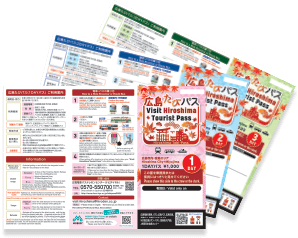
About Visit Hiroshima Tourist Pass
A round-trip pass to use a route bus, Hiroshima Electric Railway Streetcar on all lines, and Ferry (Miyajima sea lane) for 1 day, 2 days and 3 days.
- Area route map
- Pick up spots
- Product outline
- Coupon book

Hiroshima Peace Memorial Museum
Nearest station: Heiwa kinen koen (Peace memorial park)

Atomic Bomb Dome
Nearest station: Genbakudome-mae (Atomic Bomb Dome)

Shukkei-en Garden
Nearest station: Hakushima

Hiroshima Castle
Nearest station: Kencho-mae

Mitaki Temple
Nearest station: Mitaki Kanon
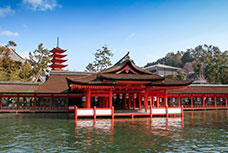
Itsukushima Shrine
Nearest station: Miyajima Ferry Terminal

Mount Misen

Miyajima / Daishoin
Sales Period: From March 10, 2020

Non-Japanese tourists who have purchased the Visit Hiroshima Tourist Pass will receive a discount coupon book valid for local tourist facilities. Please show your passport when receiving the Visit Hiroshima Tourist Pass.
Miyajima ropeway, Hiroshima Peace Memorial Museum, Hiroshima Castle, Shukkeien, Yamato Museum, Iwakuni Castle etc.
*Please note that there are facilities which are currently closed temporarily in order to prevent the spread of COVID-19 (Novel coronavirus) infection.
Purchase the Pass
- Travel Trade
- Meetings & Events
- Netherlands
- Select Language 简体中文 繁體中文(香港) 繁體中文(臺灣) India (English) Bahasa Indonesia 한국어 ภาษาไทย Tiếng Việt Singapore (English) Philippines (English) Malaysia (English) Australia/New Zealand (English) Français Deutsch Italiano Español United Kingdom (English) Nordic countries(English) Canada (English) Canada (Français) United States (English) Mexico (español) Português العربية Japan(日本語) Global (English)
- India (English)
- Bahasa Indonesia
- Singapore (English)
- Philippines (English)
- Malaysia (English)
- Australia/New Zealand (English)
- United Kingdom (English)
- Nordic countries(English)
- Canada (English)
- Canada (Français)
- United States (English)
- Mexico (español)
- Global (English)
- Fujiyoshida
- Shimonoseki
- Ishigaki Island
- Miyako Island
- Kerama Island
- Tokyo Island
- Koka & Shigaraki
- Hida Takayama
- Ginza, Nihonbashi
- Beppu & Yufuin (Onsen)
- Ginzan Onsen
- Nagasaki Islands

- Kumano Kodo
- Shikoku Karst
- Amami Oshima
- Hachimantai
- Omihachiman
- Aizuwakamatsu

- Diving in Japan
- Skiing in Japan
- Seasonal Flowers in Japan
- Sustainable Outdoors
- Off the Beaten Track in Japan
- Scenic Spots
- World Heritage
- Home Stays & Farm Stays

- Japanese Gardens
- Japanese Crafts
- Temple Stays
- Heritage Stays
- Festivals and Events
- Theater in Japan
- Japanese Tea Ceremony
- Cultural Experiences in Japan
- Culture in Japan

- Local Cuisine Eastern Japan
- Local Cuisine Western Japan
- Local Street Food
- Japan's Local Ekiben
- Japanese Whisky
- Vegetarian and Vegan Guide
- Sushi in Japan Guide
- Japanese Sake Breweries

- Art Museums
- Architecture
- Performing Arts
- Art Festivals
- Japanese Anime and Comics
- Japanese Ceramics
- Local Crafts

- Scenic Night Views
- Natural Wonders
- Theme Parks
- Samurai & Ninja
- Iconic Architecture

- Wellness Travel in Japan
- Japanese Ryokan Guide
- A Guide to Stargazing in Japan
- Relaxation in Japan
- Forest Bathing (Shinrin-yoku)

- Experiences in Japan
- Enjoy my Japan
- National Parks
- Japan's Local Treasures
- Japan Heritage
- Snow Like No Other
- Wonder Around Japan

- Visa Information
- Getting to Japan
- Airport Access
- COVID-19: Practical Information for Traveling to Japan
- Anime Tourism
- Countryside Stays
- Accessible Tourism
- Hokkaido Great Outdoors
- Scenic World Heritage in Tohoku
- Shikoku’s Nature and Traditions
- Southern Kyushu by Rail
- Tour Operator Search

- Traveling by Rail
- How to Travel by Train and Bus
- JR Rail Passes
- Scenic Railways
- Renting a Car
- Sustainable Travel in Japan
- Travel Brochures
- Useful Apps
- Online Reservation Sites
- Eco-friendly Accommodation
- Luxury Accommodations
- Traveling With a Disability
- Hands-free Travel
- How to Book a Certified Tour Guide
- Volunteer Guides
- Tourist Information Center

- Japanese Manners
- Spring in Japan
- Summer in Japan
- Autumn in Japan
- Winter in Japan
- Cherry Blossom Forecast
- Autumn Leaves Forecast

- Japan Visitor Hotline
- Travel Insurance in Japan
- Japan Safe Travel Information
- Accessibility in Japan
- Vegetarian Guide
- Muslim Travelers
- Safety Tips

- Browse All Inspiration
- Japan Fan Newsletter
- Food & Drink
- Life in Japan
- Japan in the UK/IRE

My Favorites
${v.desc | trunc(25)}
Planning a Trip to Japan?
Share your travel photos with us by hashtagging your images with #visitjapanjp
What to Do and See In and Around Hiroshima: Our Complete Guide
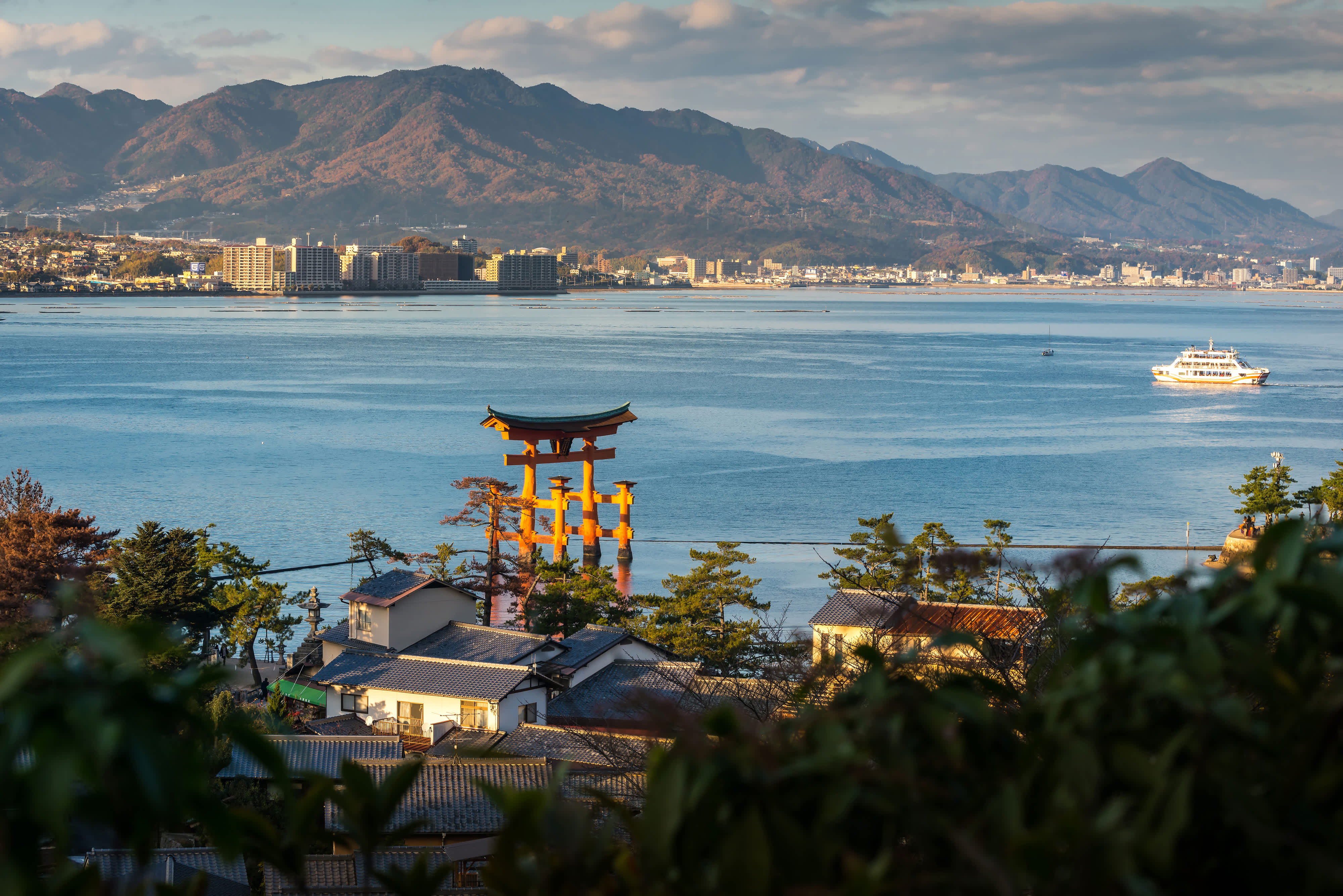
Hiroshima, a symbol of resistance and rebirth, deserves to be at the top of your bucket list of places to visit in Japan. The City of Peace, which just welcomed the latest G7 Summit, is a must-see destination in Japan's south. With a rich historic past that extends well beyond the tragic 1945 events, a vibrant city life, wonderful local cuisine, and gorgeous surroundings as it lies by the blue waters of Hiroshima Bay, let’s take a look at everything Hiroshima has to offer!
The best sights to see in Hiroshima
Shukkei-en garden.
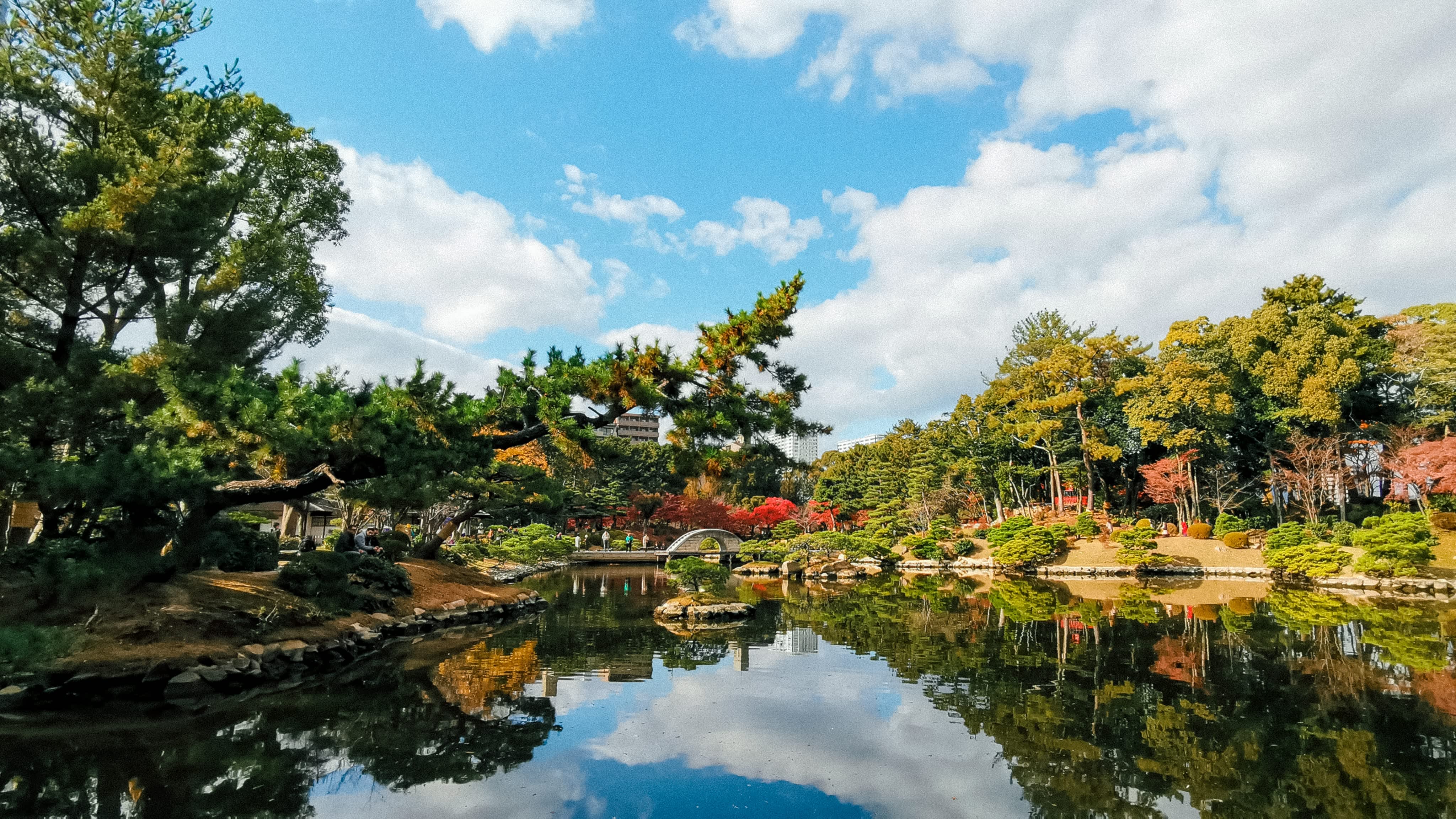
A serene and calm invitation to contemplation, the Shukkei-en Garden is a perfect example of what a Japanese garden should be; an escape from the city, a charming place to walk around or sit and relax, and lose track of time for a few hours!
This historic landmark was built in 1620 by the first feudal lord of the Hiroshima domain, Nagaakira Asano, as a garden for his villa. Shukkei-en is an enjoyable visit throughout the year, but it reveals its true beauty during fall, as its maple trees turn red, and lights give the park a whole new depth at night. Beautifully designed around lovely paths, trimmed trees and koï fish ponds (make sure you buy some fish food at the entrance, and watch the koi carps dance in a blur of colours as you feed them!), the Shukkei-en Garden is a must-see in Hiroshima.
Hiroshima Peace Memorial Park & Atomic Bomb Dome
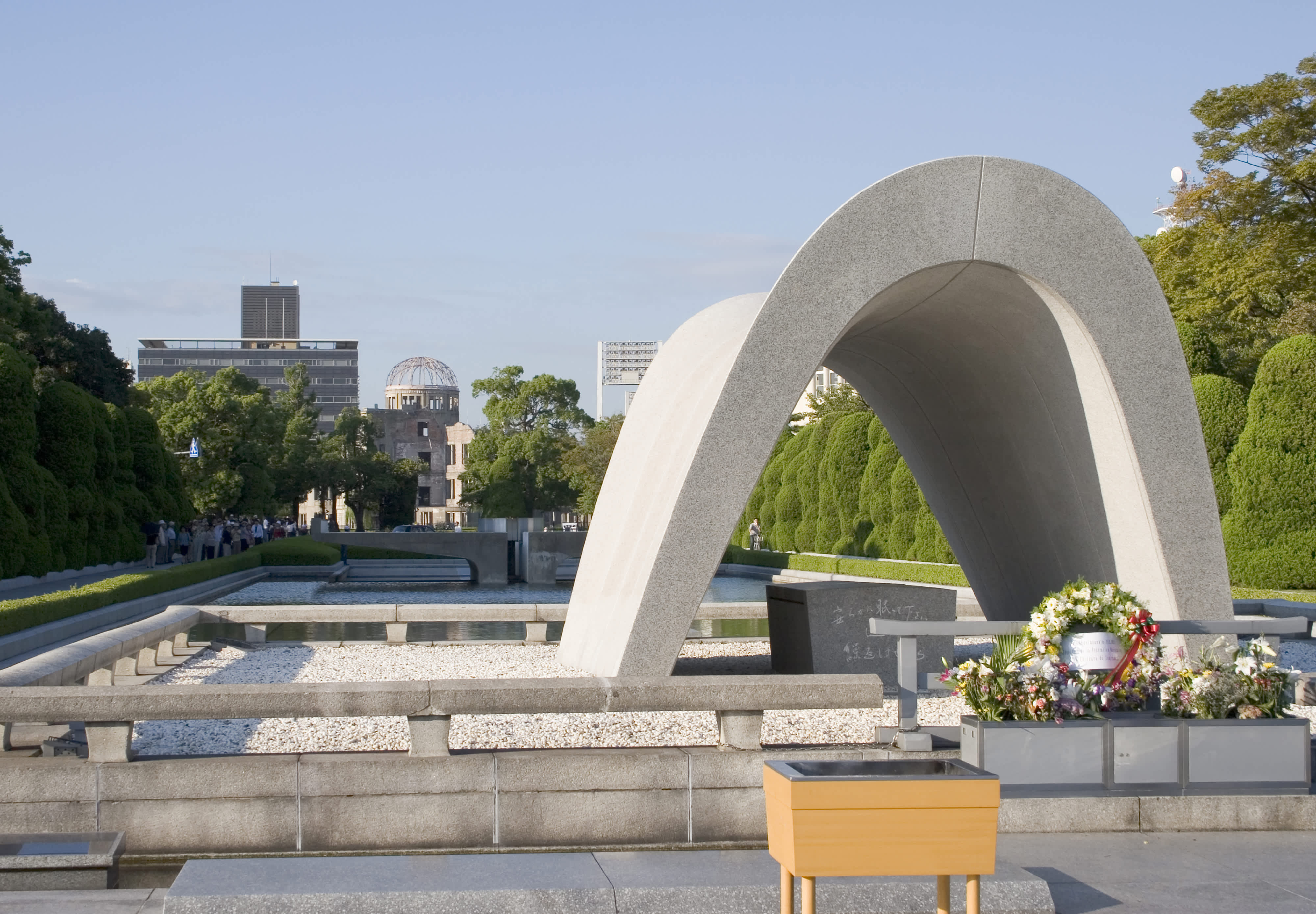
The Hiroshima Peace Memorial Park was founded in 1954 at the site of an open field that was initially created by the atomic bombing of 1945. The park itself consists of stark white architecture laced with bright greenery and foliage. At the centre of the park, an arc shaped monument is the main site for the annual Peace Memorial Ceremony, often attended by major G7 leaders. Visitors can also go and see a number of museums on the park grounds, such as the Children’s Peace Museum and the historic Rest House that dates back to the day of the bombing.
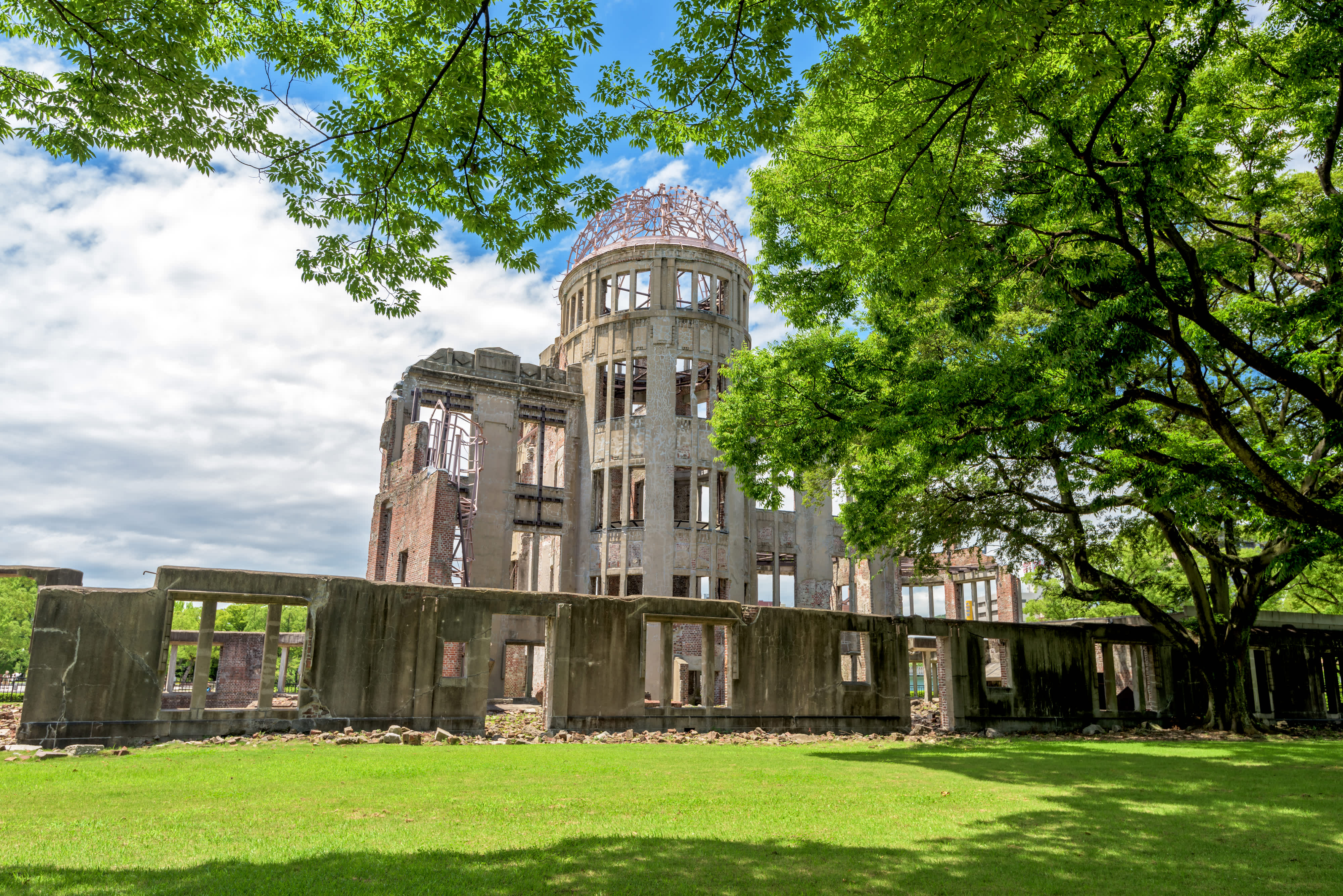
Within the park, you will also find the A-Bomb Dome that has been preserved as in 1945, looking as though frozen in time. This dome was the building closest to the epicentre of the detonation that maintained its structure, though the initial damage it suffered still remains. The tattered silhouette starkly contrasts the pristine aesthetic of other parts of the park, serving as a physical representation of the city’s past defined by destruction and future by progress.
Mitaki-Dera Temple
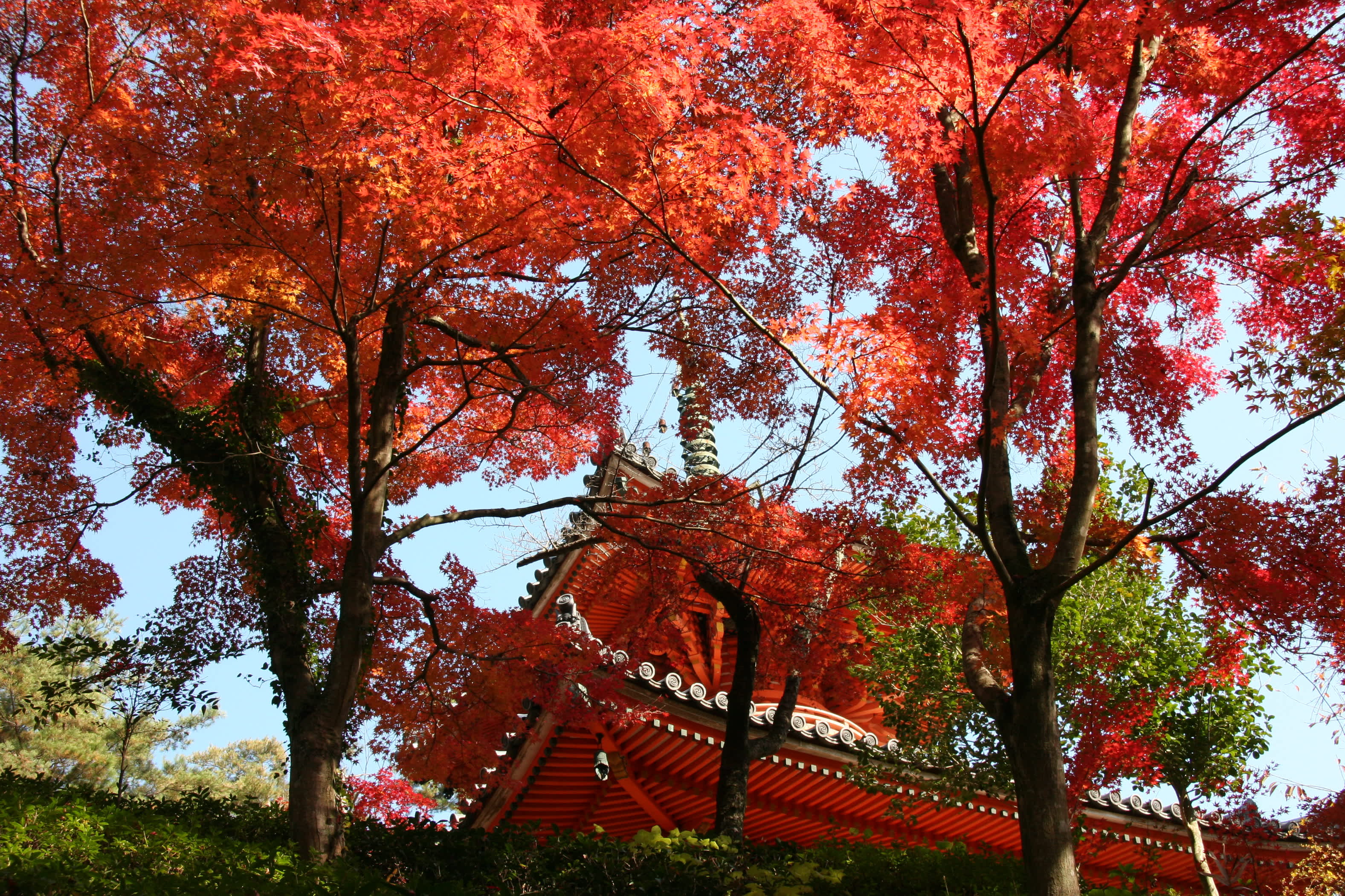
Not exactly an unknown spot as it is an appreciated location to enjoy the sakura (cherry blossoms in spring) and the momiji (red maple leaves in autumn) celebrations, the Mitaki-Dera Temple is still an understated hidden gem in Hiroshima. Located on the slopes of Mount Mitaki, a short train ride away from the city centre - don’t forget your Japan Rail Pass -, this Buddhist temple dates back to 809 and is a truly breathtaking experience.
An almost mystical atmosphere envelops the area and invites you to become one with nature as you stroll between statues, deep vegetation and quaint rivers, pagodas. Both a quiet hike near the city and a powerful dive into the region’s spiritual background, Mitaki-Dera is a sensory journey to another realm, one where the sounds of the wind rustling the leaves, the water rushing through the rocks and nature will carry you, if you let them.
Hiroshima Castle
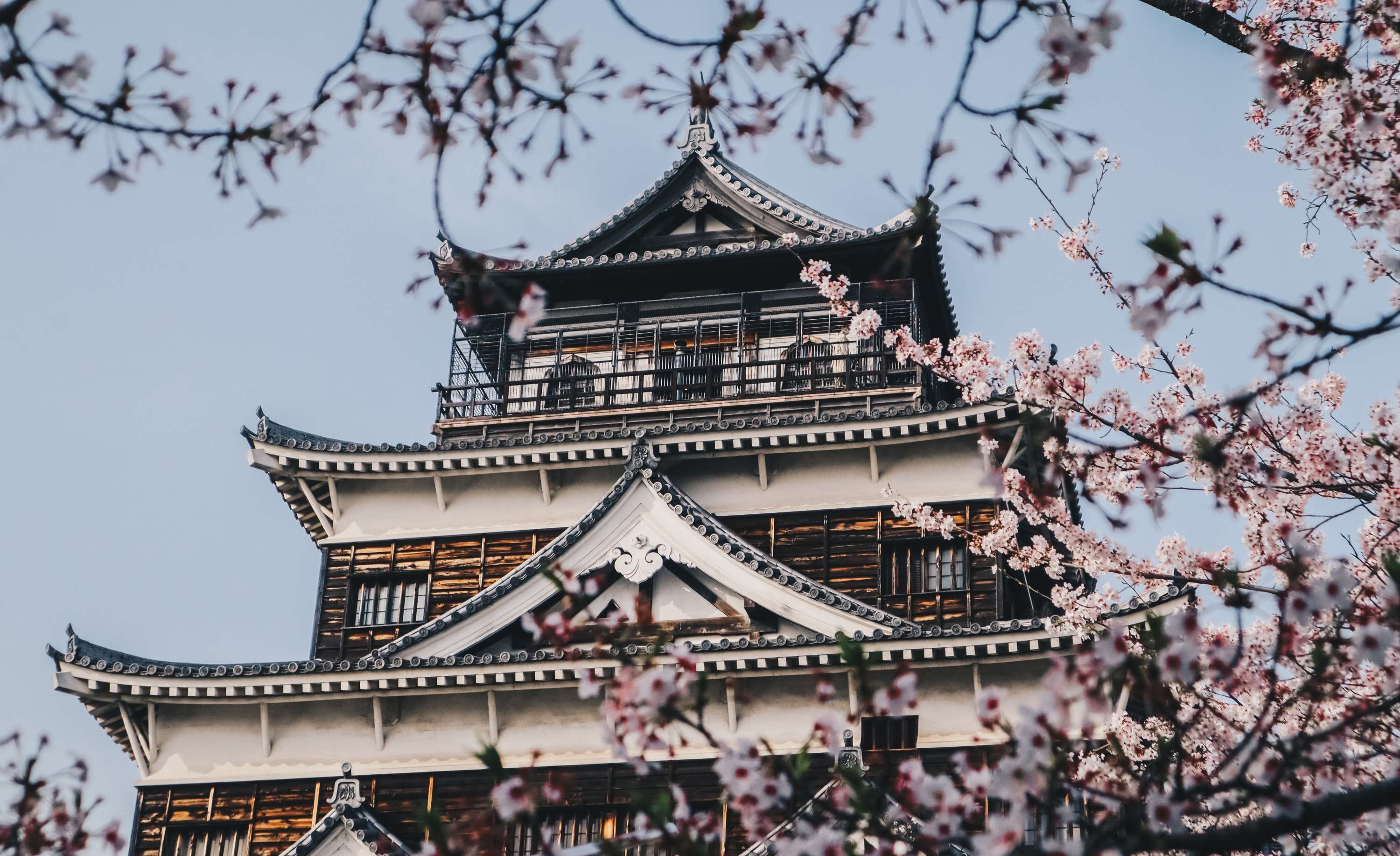
While the castle you will see today only dates back to 1958 - the original one having been lost to the atomic bombing of 1945 - Hiroshima Castle is still a historic visit to add to your to-do list in Hiroshima. Also known as “Carp Castle”, the landmark now serves as a museum retracing not only the history of the city and its famed castle, but also castles in Japan in general. Exhibits about the fascinating reconstruction efforts also take place at Hiroshima Castle, such as the recent restoration of the castle’s line of defense with original techniques dating back to its original making in 1589. From the top floor, you will be able to enjoy a stunning panoramic view of Hiroshima, at the heart of its city centre, steps away from the Peace Memorial Park.
Ride on the old-time Hiroden vintage trolleys
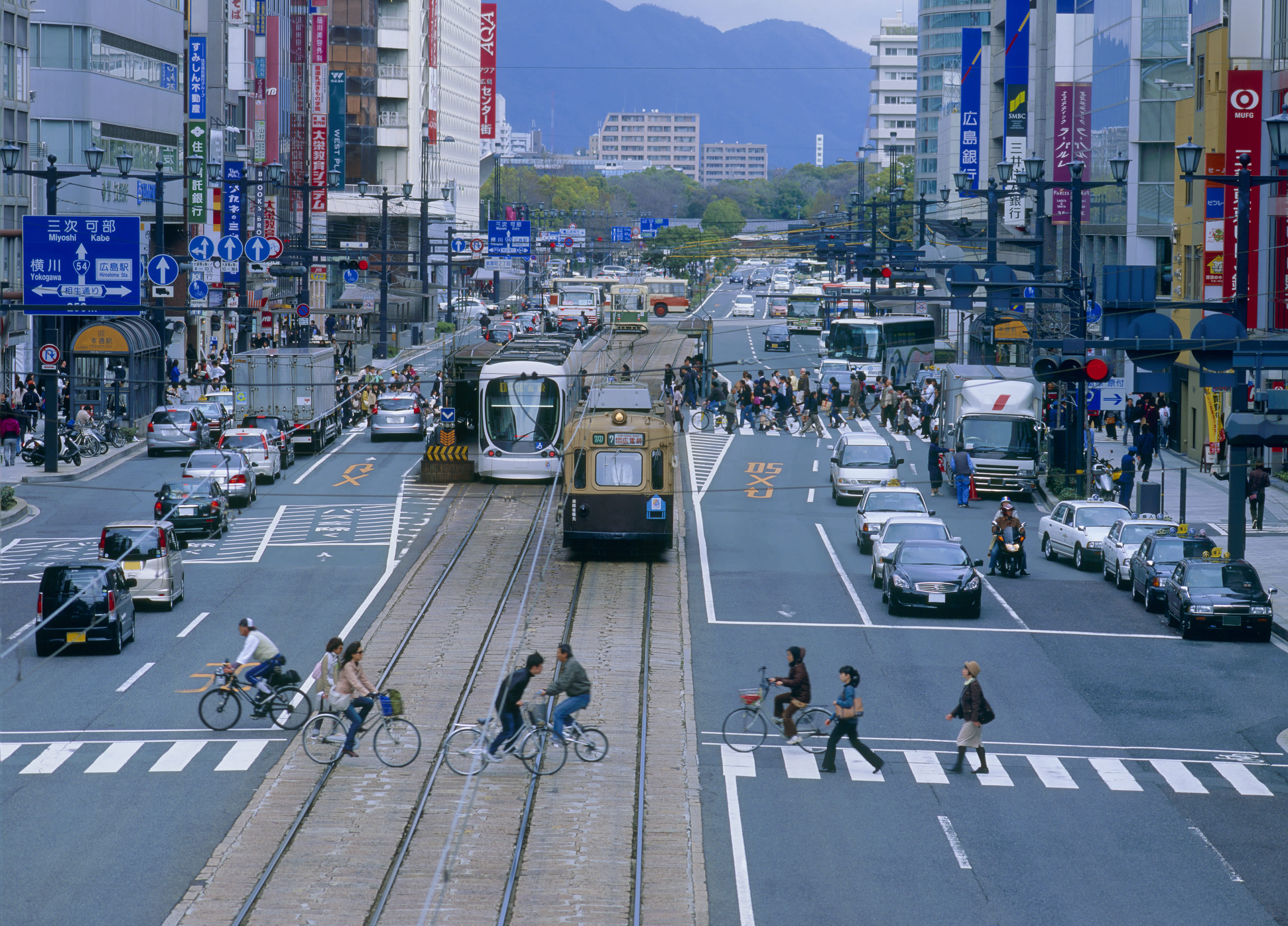
The remnants of yesteryear exist in Hiroshima in many ways, especially embodied through the old-time Hiroden Vintage Trolley cars that run through the streets. These trolley cars do more than simply looking the part for the vintage aesthetic, with their wooden-frames and lacquer paint. Many of these trolley cars were issued prior to the dropping of the bomb, and many of them still exist today and are still in operation, servicing the city as an iconic form of public transportation. The presence of these trolley cars at the time of the bombing has led to them being dubbed hibaku densha (被爆電車), meaning atomic bomb cable cars. These trolley cars are an essential piece of Hiroshima history, as well as a practical way to explore what the rest of the city has to offer! The Hiroden trolley network is usable with your Suica prepaid card too.
A dive into Hiroshima’s rich food culture
Wood egg museum.
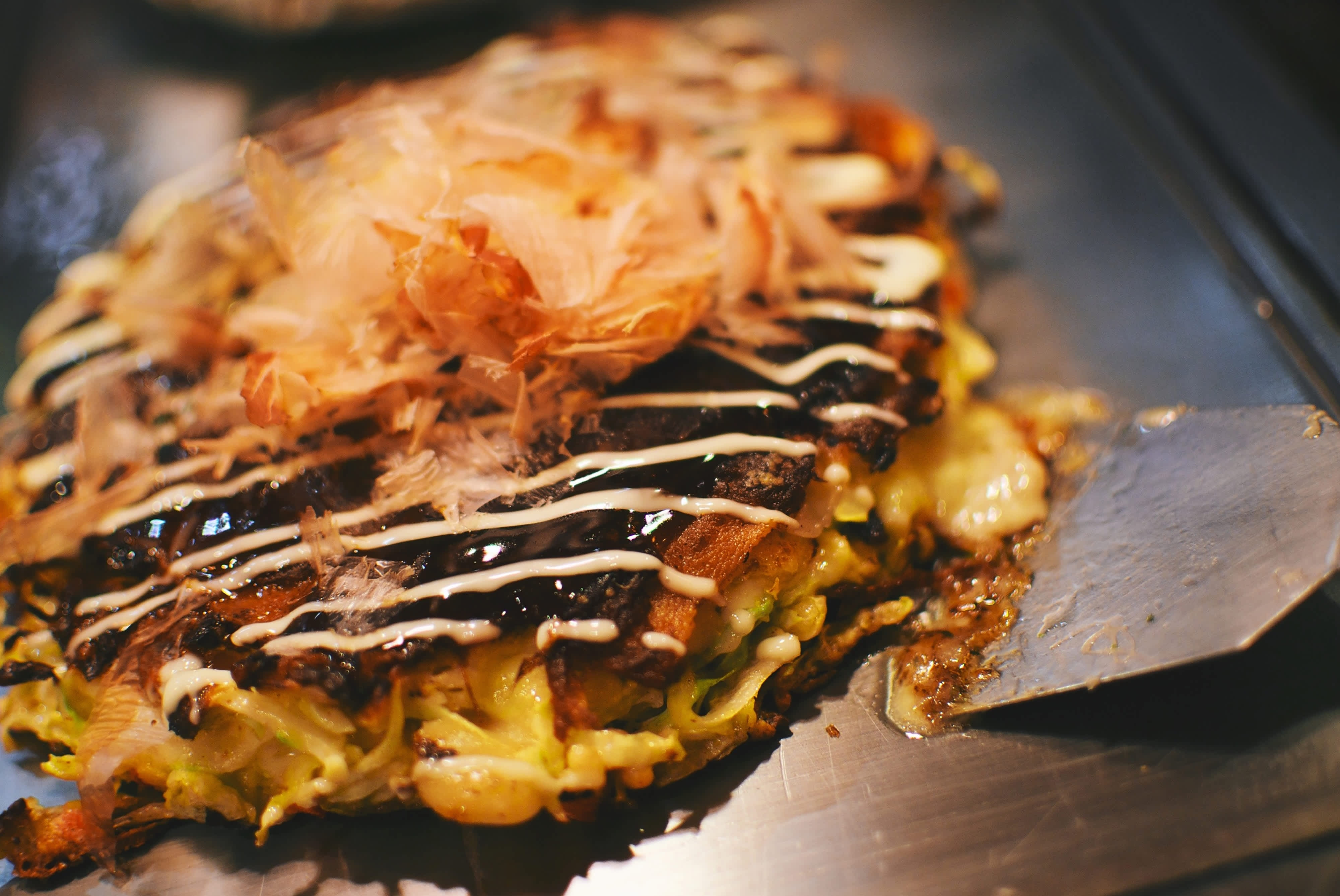
If there is any type of cuisine that symbolises Hiroshima as a whole, it is okonomiyaki (お好み焼き). Literally translating to “cooked as you like,” the possibilities with okonomiyaki are nearly endless. Okonomiyaki is a savory batter made with cabbage, flour, and egg that is cooked on a flat-top grill and mixed with a number of ingredients like meat, seafood, vegetables, and even more surprising elements like mochi. After grilling, it is often topped with a variety of sauces and shaved bonito flakes. Okonomiyaki is also heavily associated with Osaka, but Hiroshima-style okonomiyaki is distinct in its addition of grilled soba noodles and more layered construction, where individual components are cooked and then put together at the end.
People can indulge in this regional specialty in a very unique way at the Hiroshima Wood Egg Okonomiyaki Museum. As the name implies, the museum is constructed largely of wood and in an ovoid shape. Here, visitors can engage in all things Okonomiyaki. On the second floor, there is a museum documenting the city’s history with the dish, such as its connection to post-war Hiroshima that optimized the dish to work with the lack of food resources at the time. There are even a number of different cooking studios at the museum that cater to people of all ages and skill levels.
Okonomimura
Sure, we’re not revealing anything ground-breaking by advising you to go to the Okonomimura, as this place is a culinary institution in Hiroshima and can get quite crowded. But if okonomiyaki is the heart and soul of Hiroshima’s gastronomy, then Okonomimura is where it physically resides. This vibrant, bustling building is a temple dedicated to okonomiyaki, and boasts three - yes, three - full floors of food stalls, all serving some sort of variation of this iconic local dish.
As you walk in, you’re immediately enveloped in a sensory overload of delicious-smelling okonomiyaki being cooked right before your eyes, sizzling on the open grill, oozing with succulent toppings. The hardest part is to choose where to sit down and get a real taste of what Hiroshima’s renowned street food is all about. Fortunately, there’s no way to make the wrong choice : every single okonomiyaki stall in Okonomimura is la crème de la crème.
Yagenbori Hassho
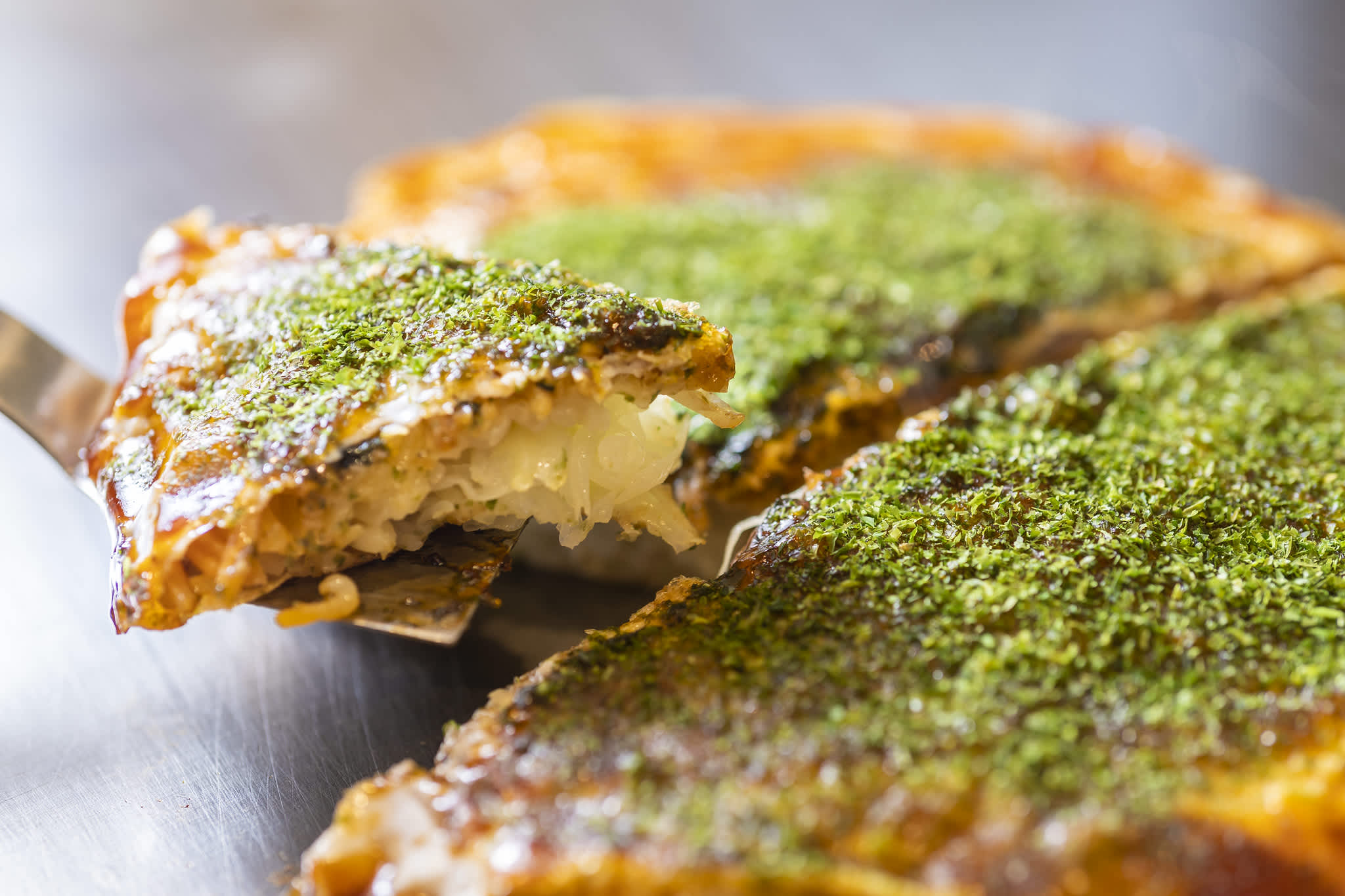
While you wait for this Hiroshima food classic to land on your plate, don’t forget to also get a taste of another staple of the city’s rich cuisine : oysters. Creamy, fresh oysters get thrown on the grill and sizzle for a bit, and serve as a perfect appetizer. Though Yagenbori Hassho is really specialised in okonomiyakis, don’t overlook the rest of their menu, including some fine teppanyaki recipes.
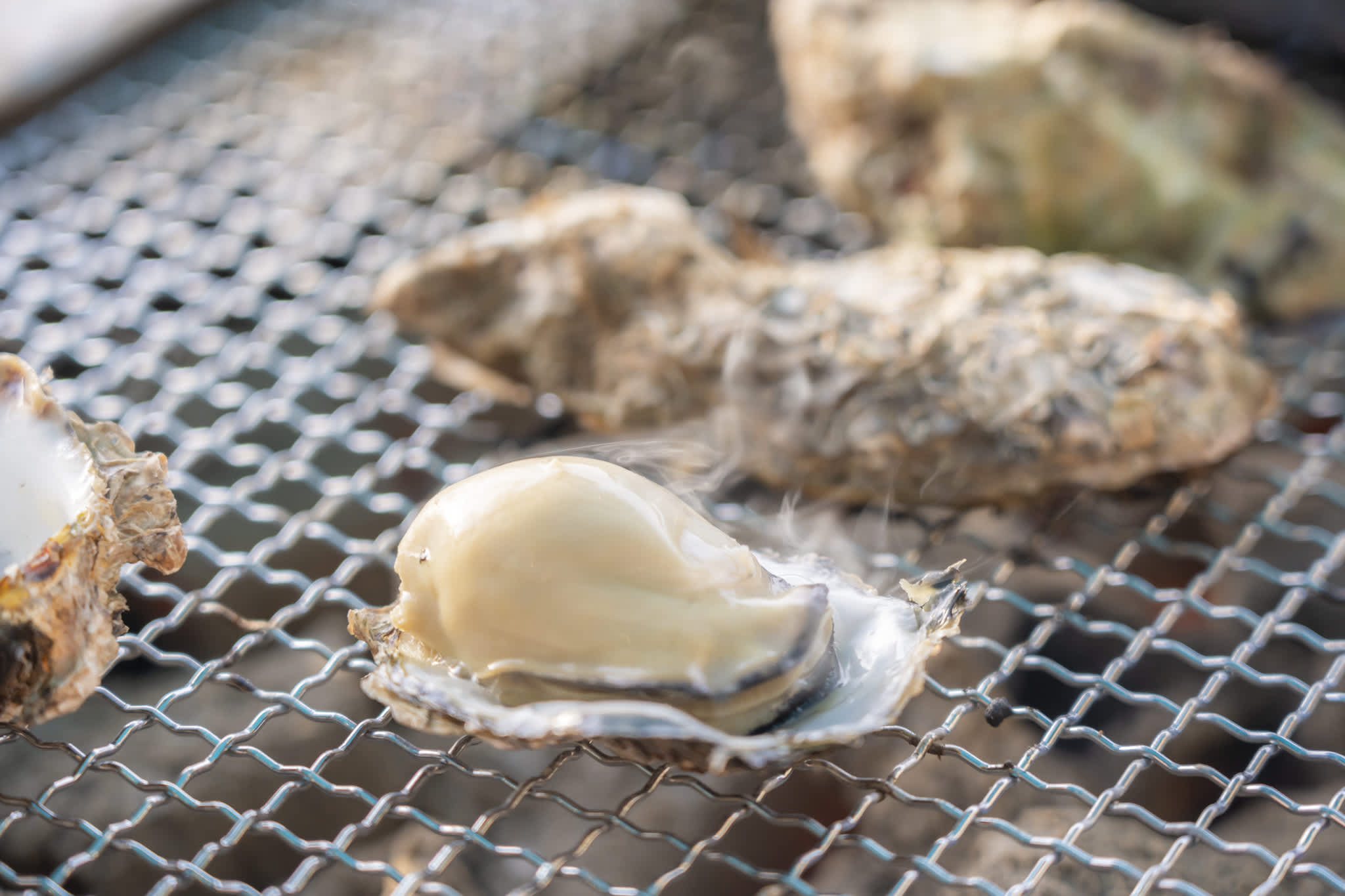
Ekohiiki, in the Otemachi neighborhood, is Hiroshima cuisine through-and-through, the locally cultivated oysters being the establishment’s main claim to fame.
Hiroshima is actually Japan’s largest oyster production region, largely defined by their large size and rich brininess. Oysters at Ekohiiki come in a variety of preparations, including raw, steamed and served with Japanese citrus fruits, breaded and fried, and also grilled with butter!
Anago (Conger Sea Eel) is also a prominent part of the Hiroshima culinary sector, often sourced from the waters around Miyajima. The anago offerings at Ekohiiki are also delicious and diverse, served kabayaki style, grilled and glazed with a sweet and savory sauce, tempura fried, or in a simple sashimi.
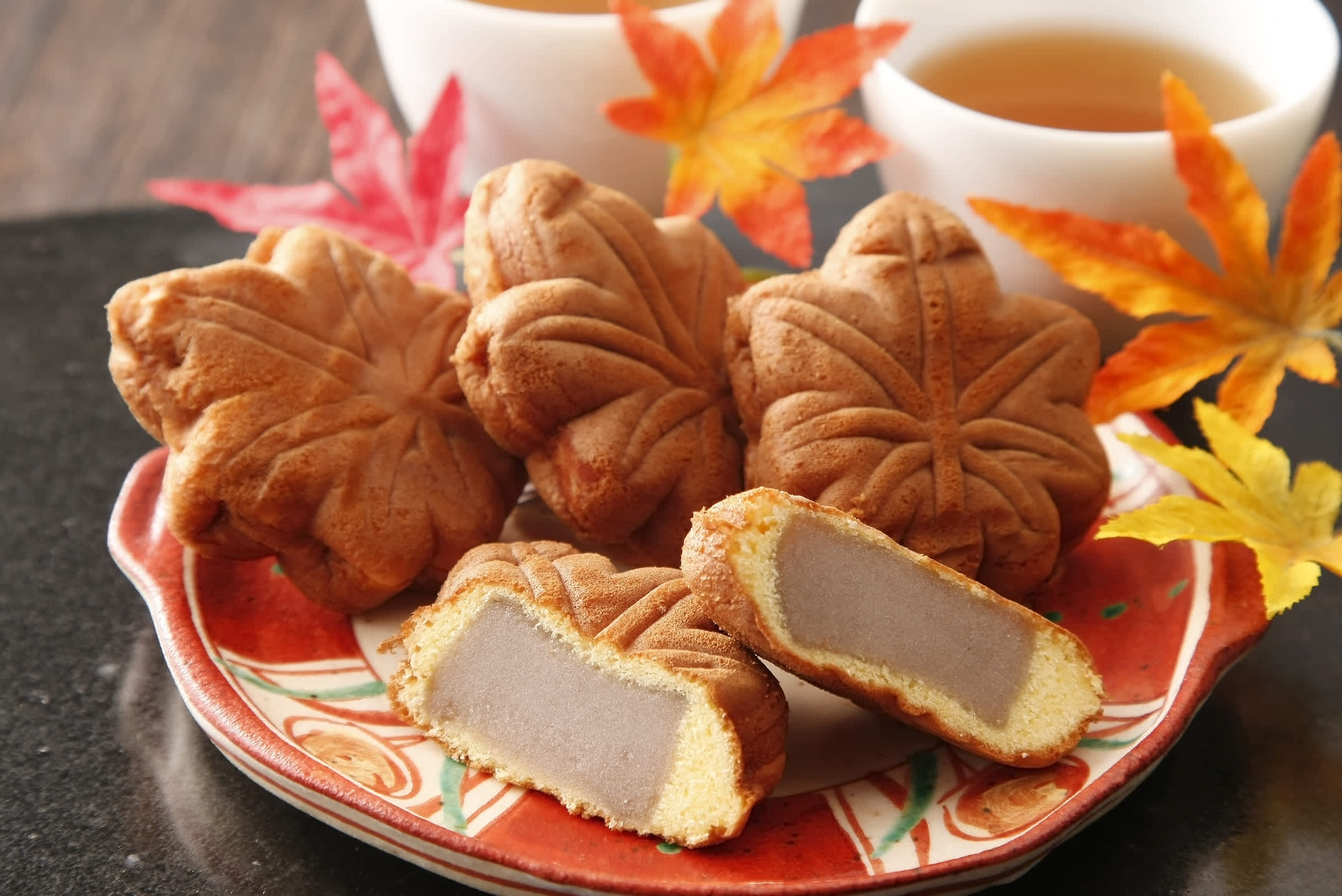
Located right next to another food staple of Mijayima, Kakiya and its renowned seafood menu including local oyster recipes, Momijido is the perfect place to try out regional sweet snacks enjoyed by the people of Hiroshima. This small corner serves a delicious fried version of the traditional momiji manju - a maple leaf shaped sweet pastry.
The original recipe remains, a soft cake with a filling inside, usually red bean (azuki) paste. However, at this little Mijayima (a ferry available with the Japan Rail Pass will take you there from Hiroshma) shop, momiji manju is coated with batter, and fried ! The result is a mouth-watering twist of an already succulent sweet, and is called age-momiji. The fried outside contrasts perfectly with the warm and soft inside of the momiji manju, and adds a new depth to this famous pastry. A great way to rediscover - or get a tasty introduction to - this Japanese culinary staple.
Scenic spots in the Hiroshima Bay
Itsukushima shrine/mijayima island.
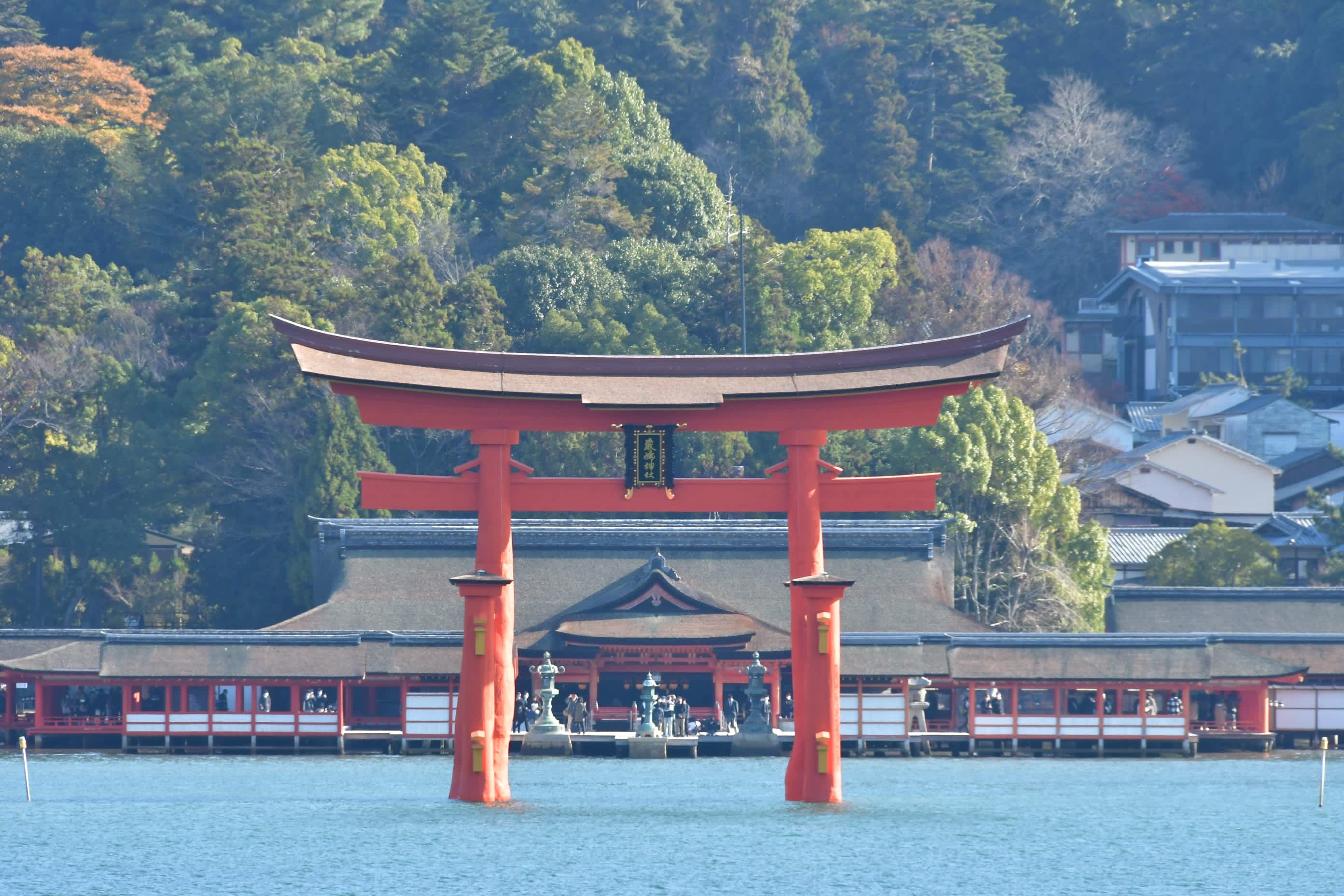
Very few scenes are as heavily associated with Japan as the torii gate at Itsukushima Shrine. The shrine is named after the island itself, though colloquially, this island is known as “miyajima,” literally translating to “shrine island,” indicating how strongly the shrine’s presence is connected to Itsukushima.
The shrine is said to have been initially built in 593 AD and has undergone a number of changes over the centuries. In 1996, it was declared a UNESCO World Heritage Site. The highlight of this shrine is its torii gate, which seems as though it’s floating during high tide. This scene is especially beautiful during sunset, when the golden hour lighting illuminates the surroundings. The shrine's main buildings are also constructed on the water. Access to the main shrine and the treasure hall inside cost 500 yen for an adult combined ticket and 150 yen for children. To get to the shrine people can ride a ferry out which is actually accessible via the Japan Rail Pass.
Haigamine Observatory
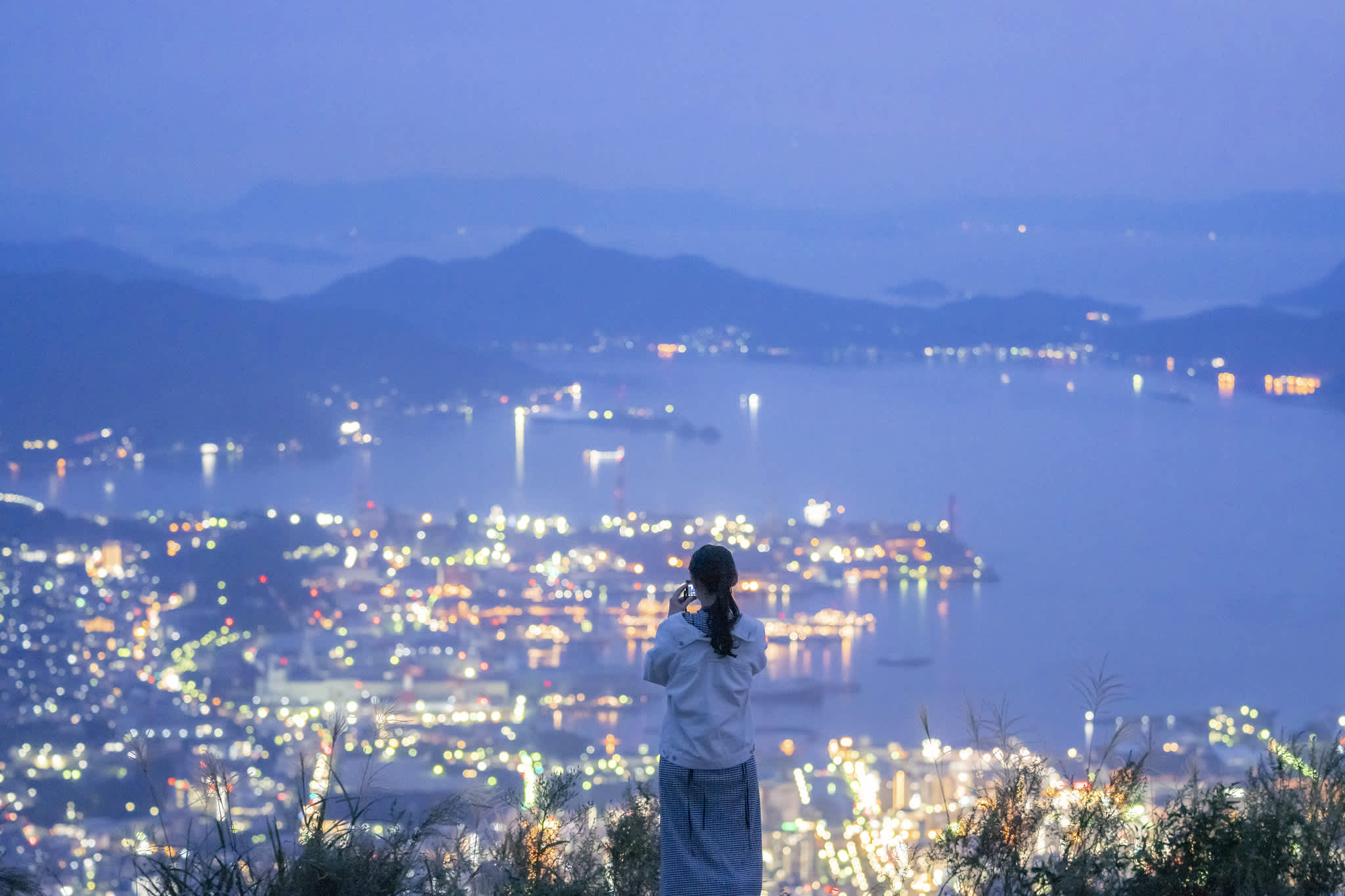
Often described as one of Japan’s top 100 views, the panorama that is visible from Haigamine Observatory is breathtaking. Culminating at over 700 meters above ground, the mountaintop offers a unique look over the city of Kure, near Hiroshima, as well as the inland sea and the islands of Hiroshima Bay. The drive up to the observatory is a bit treacherous for inexperienced drivers, so we recommend taking the 1h30 walk up there. It’s easily accessible from the Japan Rail Kure station with the Japan Rail Pass.
The best time to visit is either in the morning, to enjoy the sunrise and see how far the weather conditions allow you to see, or at night, where the view from Mount Haigamine takes a whole new depth. Listed in the top 3 night views of Japan, the panorama over Kure when the sun sets is something to see at least once in your lifetime. The city lights stretch all the way to the Hiroshima Bay, where it meets the seemingly infinite dark waters blending with the night sky horizon, only interrupted by the lit up coastlines of the Seto Inland Sea islands.
Onomichi/Senkoji Temple
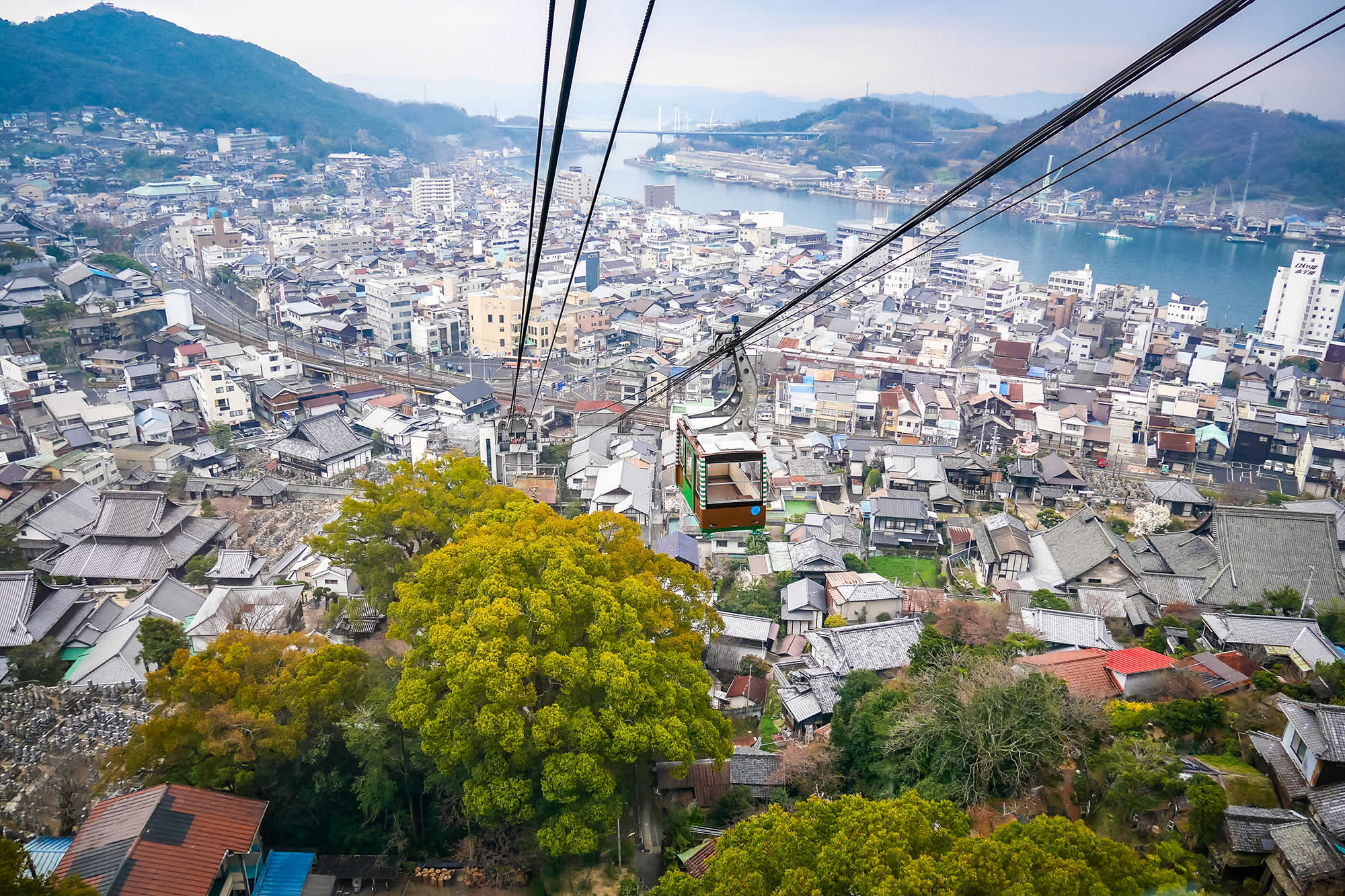
In Eastern Hiroshima Prefecture is Onomichi City, about a one-hour Shinkansen ride from the prefecture’s capital city - included with your Japan Rail Pass. Here, one can find a number of attractions that are built throughout the area’s hilly geography. Senkoji Temple is located on the hillside of Daihozan. This elevated position gives visitors to the temple a clear view of Onomichi Port and the city beside it.
Heading up to the temple can be as much of a treat as the temple itself, as it is accessible via cable car that takes travellers from the base of the hill up to the hillside. For those looking to get in their steps in for the day however, a series of stairs lead up to the temple.
To wind down in Onomichi, visitors can go to Karasawa Ice Cream Shop, whichthat sells traditional Japanese Monaka, a frozen treat consisting of ice cream inside of rice cake shells that resembles an ice cream sandwich.
Tomonoura port
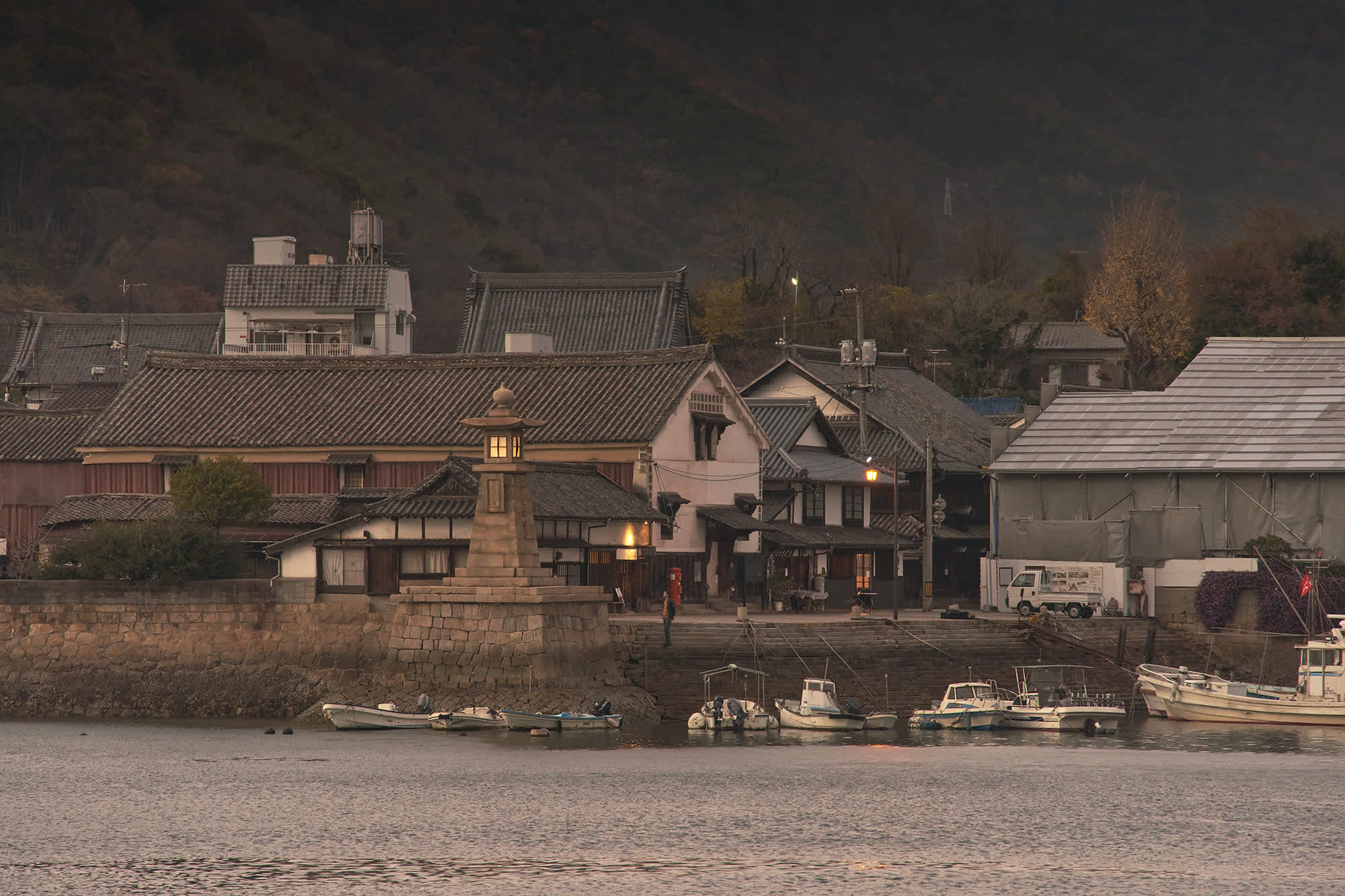
Studio Ghibli movies aficionados will most likely have a sense of déjà vu when seeing the picture above. Tomonoura’s cute and authentic port looks like a perfect backdrop to the story of Ponyo on a cliff by the sea, and this is no coincidence. Indeed, the quaint little seaside town was the inspiration for Hayao Miyazaki’s 2005 film ! Part of the Setonaikai National Park and overlooking the Seto Inland Sea, Tomonoura is easily one of the most scenic spots around Hiroshima Bay.
Almost a picture-perfect depiction of old-fashioned Japan, wandering the streets of this bucolic village will feel like time travelling. Old wooden houses, local cafés and historic temples and shrines surround a tranquil inlet port, vintage lighthouse included. The Joya-to lighthouse has been guiding ships around the port since 1859! A trip to the past and into the mind of Miyazaki, just a short Shinkansen ride away from Hiroshima station, stopping at Fukuyama JR station with the Japan Rail Pass and then taking a bus to the seaside village.
Shimanami Kaido Scenic Route
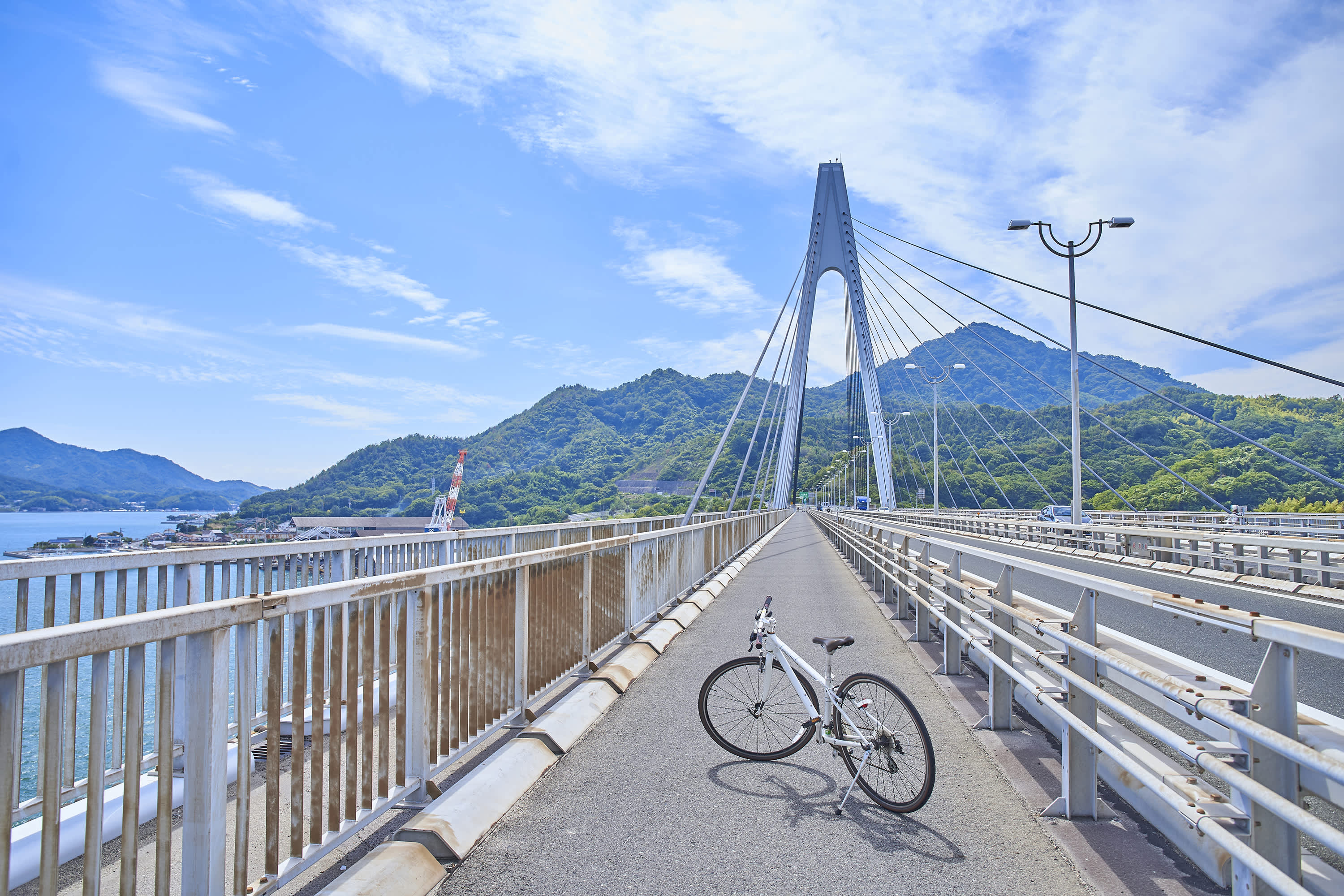
Often dubbed the “Cyclist Sanctuary,” the Shimanami Kaido Cycling Scenic Route is world-renowned by professional and hobbyist cyclists alike. This cycling route exists on both Honshu Island and Shikoku Island, spanning from Onomichi in Hiroshima to Imabari in Ehime Prefecture. The route crosses islands throughout the Seto Inland Sea, letting cyclists enjoy the beautiful view of the coast and smell of the fresh sea air.
The cycling route is appropriate for cyclists of all experience levels and is indicated with a sky-blue line throughout to guide cyclists. There are 150 different cyclist oases to rest at and a number of different facilities to provide repairs and assistance. For those who cannot bring their own bikes from abroad, there are rentals available!
Day trips from Hiroshima
Sandankyo gorge.
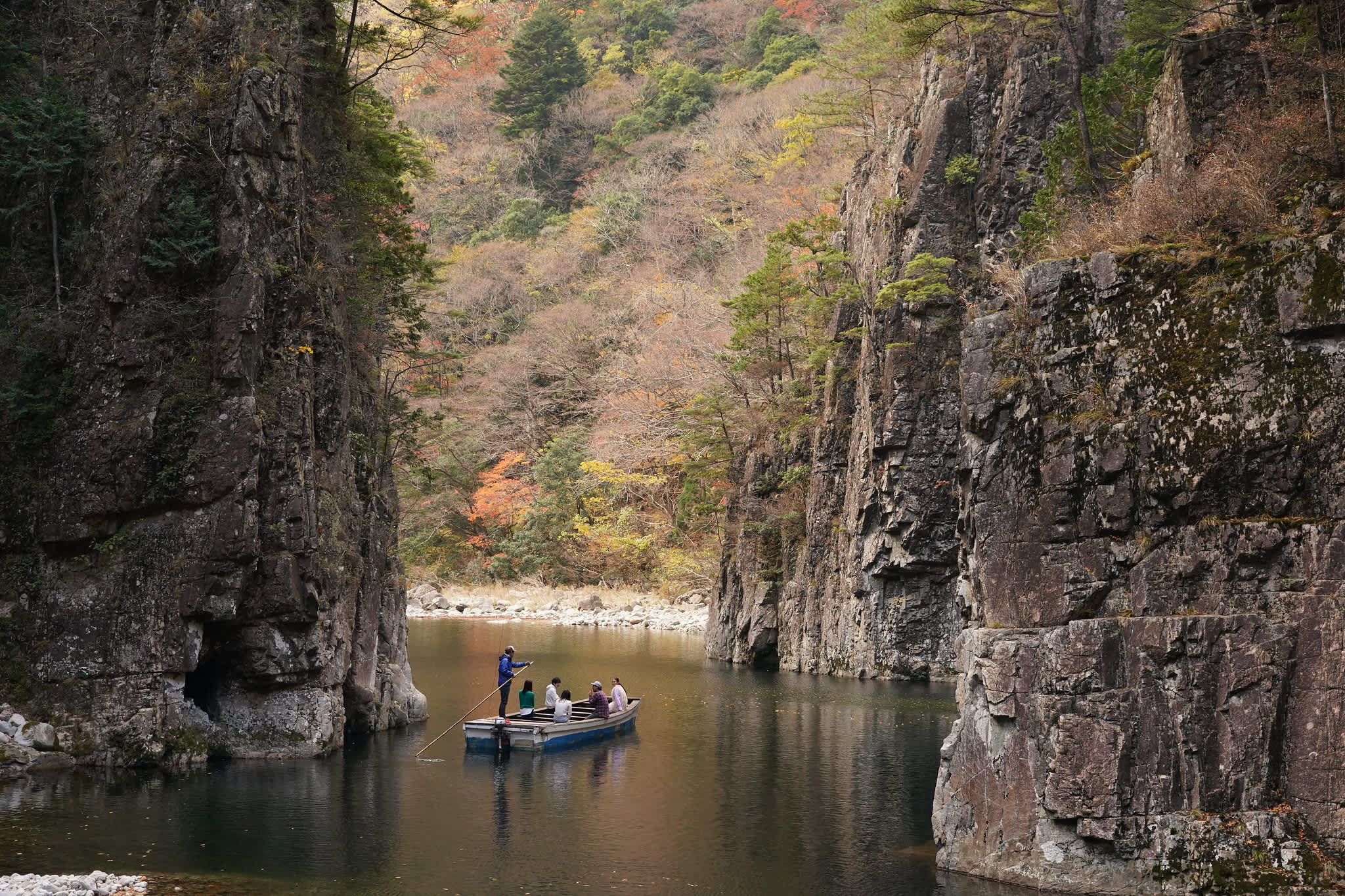
If you like waterfalls, forests and crystal clear waters, then Sandankyo Gorge is the place for you. Just an express bus hop away, the best of what the Japanese countryside has to offer is yours to experience. Several hiking paths - from 30 minutes up to 4 hours - will get you around this truly splendid wonder of nature through cliffs, elevated walkways, hanging bridges, ravines, rushing streams. And for those of you who are feeling adventurous and want to relish in Sandankyo Gorge’s breathtaking beauty from the water, kayaks are available for rent at the entrance of the Sandan Valley.
As you find yourself deeper into the park, a gorgeous reward reveals itself in the form of an emerald green pool of water, Kurobuchi. From there, take a boat to travel across the pond, and find Kurofuchi-so, a family restaurant serving fresh grilled salmon. Sandankyo Gorge also boasts a hotel if you want to make this resourcing escape from the city a 2-day trip - or if you missed the last return shuttle to Hiroshima. If that’s the case, not to worry : Sandankyo Hotel has a relaxing onsen for you to unwind.
Okunoshima Island

This small island, 15 minutes off the coast of Hiroshima via ferry, is often called “Rabbit Island,” whose name alone is enough to inspire excitement in any animal lover. Okunoshima is home to over 1,000 wild rabbits that roam around and come up to tourists for food. The island is a popular day-trip destination, but there is also a hotel on the island for any guests wishing to stay overnight.
The presence of these adorable rabbits definitely provides a relaxing environment, but the island has a rather dark history as the rabbits were originally introduced to the island during World War II, for chemical weapons research.
While the rabbits are the primary draw for the island, a number of attractions are also great ways to spend time, including the aforementioned museum, water-sport activities and beach-going, and there’s even a cafe to relax with a drink!
Serakogen farm/Hiroshima Miyoshi Winery
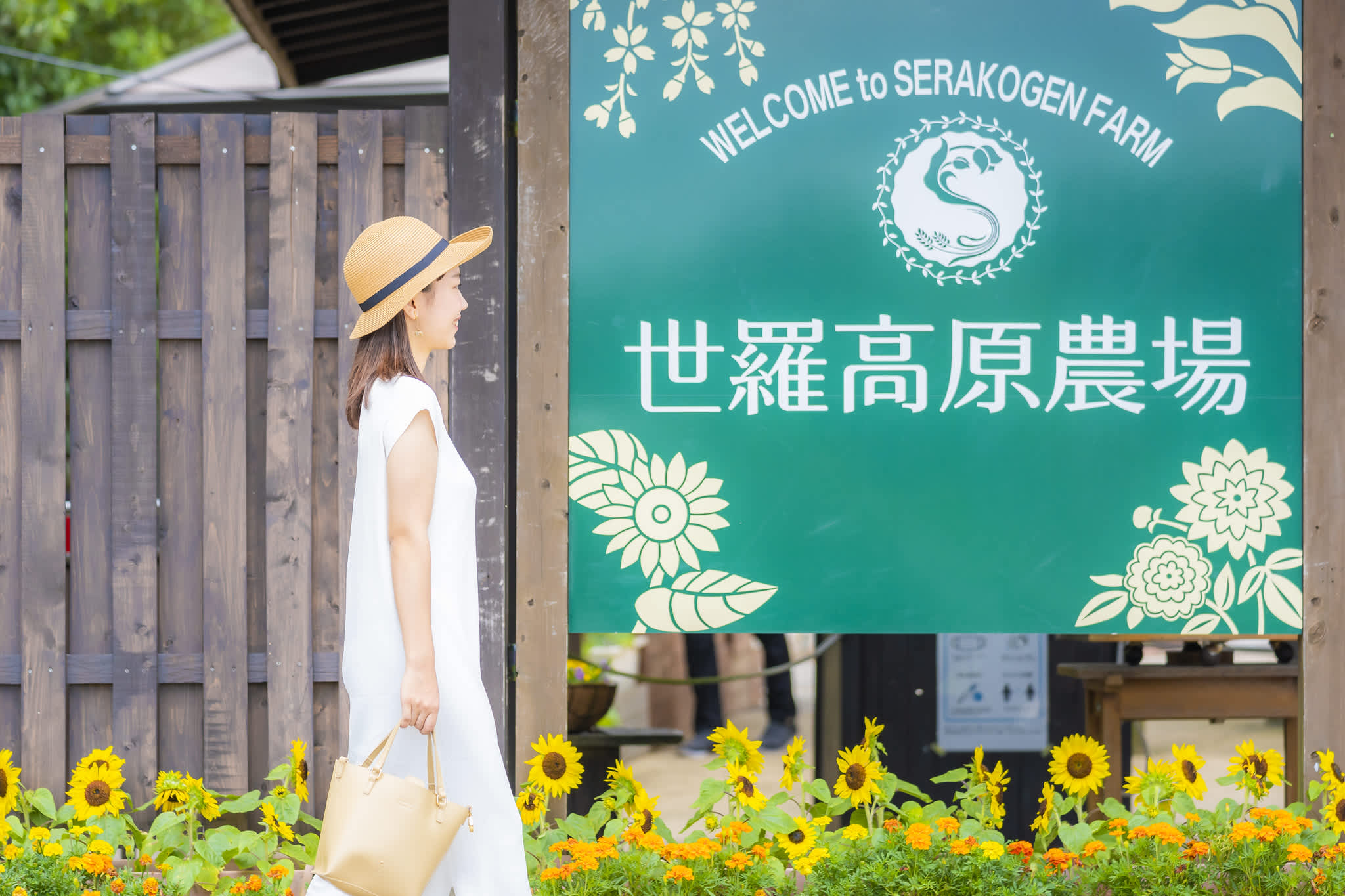
The town of Sera is found in the centre of Hiroshima Prefecture. Here, the climate is typically warmer than much of the rest of the prefecture, creating an ideal environment for the lush flower fields. From April to December, a different seasonal flower is featured at varying places like Serakogen Farm, Kamuno Sato Flower Village, and Sera Kogen Flower Forest. During the winter months, Sera Kogen Flower Forest creates a candle display at night.
Sera’s economy is largely agriculturally driven, boasting not just beautiful flowers but high quality food products. Sera Burgers have been a favorite of the area and are largely made from locally sourced ingredients. Also revered in the area is the crop of grapes which are used in wine production at the Miyoshi Winery. The most distinct of their offerings is that of “Fuki Wine,” produced with Fuki Grapes that are notable for their high sugar content. After enjoying the gorgeous scenery of the area, travellers can make their way to the winery to enjoy tastings of the locally produced wines.
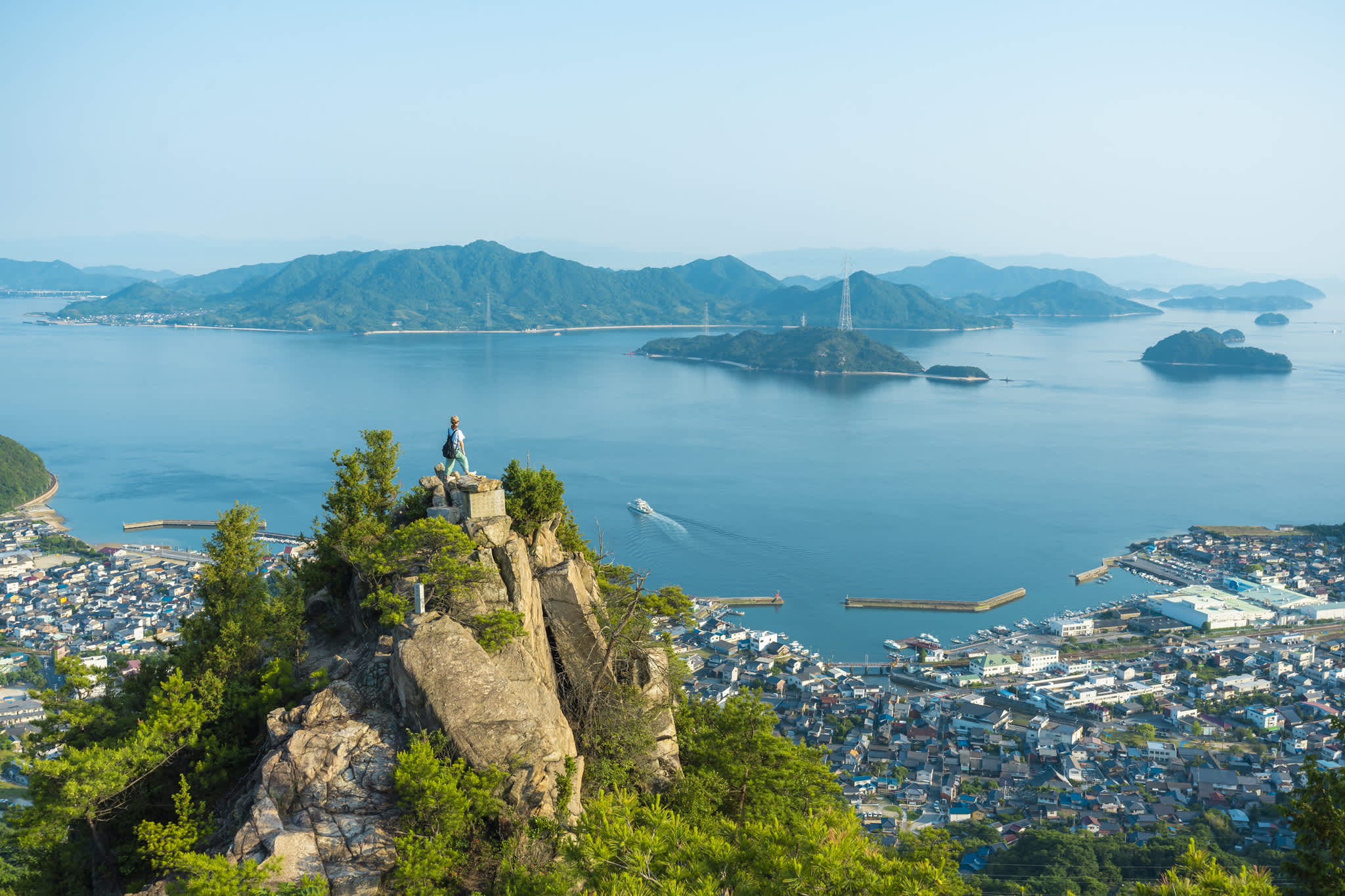
Back in the day, Takehara was a shining pearl in the Hiroshima Bay, thanks to its production of salt and sake. If the two industries are not synonymous with the area anymore - though you will still find some historic breweries left -, Takehara remains a highlight of the region. Thanks to its preserved architecture and its timeless atmosphere, the quaint seaside town offers an amazing dive into the Edo period (1603-1867), as its streets are filled with old wooden buildings.
Nearby, a 45-minute climb on foot - accompanied by Buddhist statues along your path - will bring you to the top of Mount Kurotaki, and reward you with stunning views of the Seto Inland Sea. Nicknamed “Little Kyoto” thanks to its historic and old-timey feeling, Takehara has one other similarity with the Kansai city : its bamboos. Indeed, Takehara is surrounded by bamboo forests, and they’re worth exploring to take a relaxing stroll as the wind rustles between the tall woods. The picturesque town is accessible via JR trains on the Kure line.
How to Get to Hiroshima
Access to hiroshima by train.
Hiroshima is accessible from Tokyo thanks to a direct Shinkansen ride, passing through major cities such as Nagoya, Kyoto and Osaka, if you want to hop on from there. The trip is included in the national Japan Rail Pass , along the Tokaido Shinkansen and then Sanyo Shinkansen lines and takes approximately 5 hours from Tokyo. The train stops at Hiroshima Station.
Access to Hiroshima by plane
While there are no direct flights from Europe and the Americas to Hiroshima airport, Japan has an extensive domestic flight network to get you to the City of Peace. In Japan, flights to Hiroshima depart from both Tokyo airports, Okinawa, Sapporo and Sendai airport. To get to the city, either take a limousine bus transfer, or arrive at Hiroshima Station through the regional JR Sanyo train line, included in the Japan Rail Pass.
Access to Hiroshima by car
A little more than 800 kilometers separate Hiroshima from Tokyo, which will take a little over 8h30 to complete. If you’re up for the road trip, there are many options available to rent a car in Japan .
- Life in Japan (111)
- Media (110)
- Nature (101)
- Outdoor (86)
- Tradition (85)
- Cities (44)
- Food & drink (44)
- Women in Japan (41)
- Culture (39)
- Spring (36)
- Winter (36)
- Autumn (36)
- Summer (33)
- Adventure (31)
- Things to do (28)
- Relaxation (28)
- Traditional (25)
- Japan in the UK/IRE (18)
- Family (18)
- City life (11)
- Local Guides (10)
- Cuisine (8)
- Hokuriku Shinetsu (7)
- Hokkaido (4)
- Articles (4)
- Shikoku (2)
- Outdoor (2)
- Chugoku (1)
- Hokuriku Shinetsu (1)
- Festivals (1)
- Cuisine (1)
- Postcards from Japan (1)
- Previous Article
- Back to Overview
- Next Article
- Inspiration
Please Choose Your Language
Browse the JNTO site in one of multiple languages
Hiroshima Peace Tourism
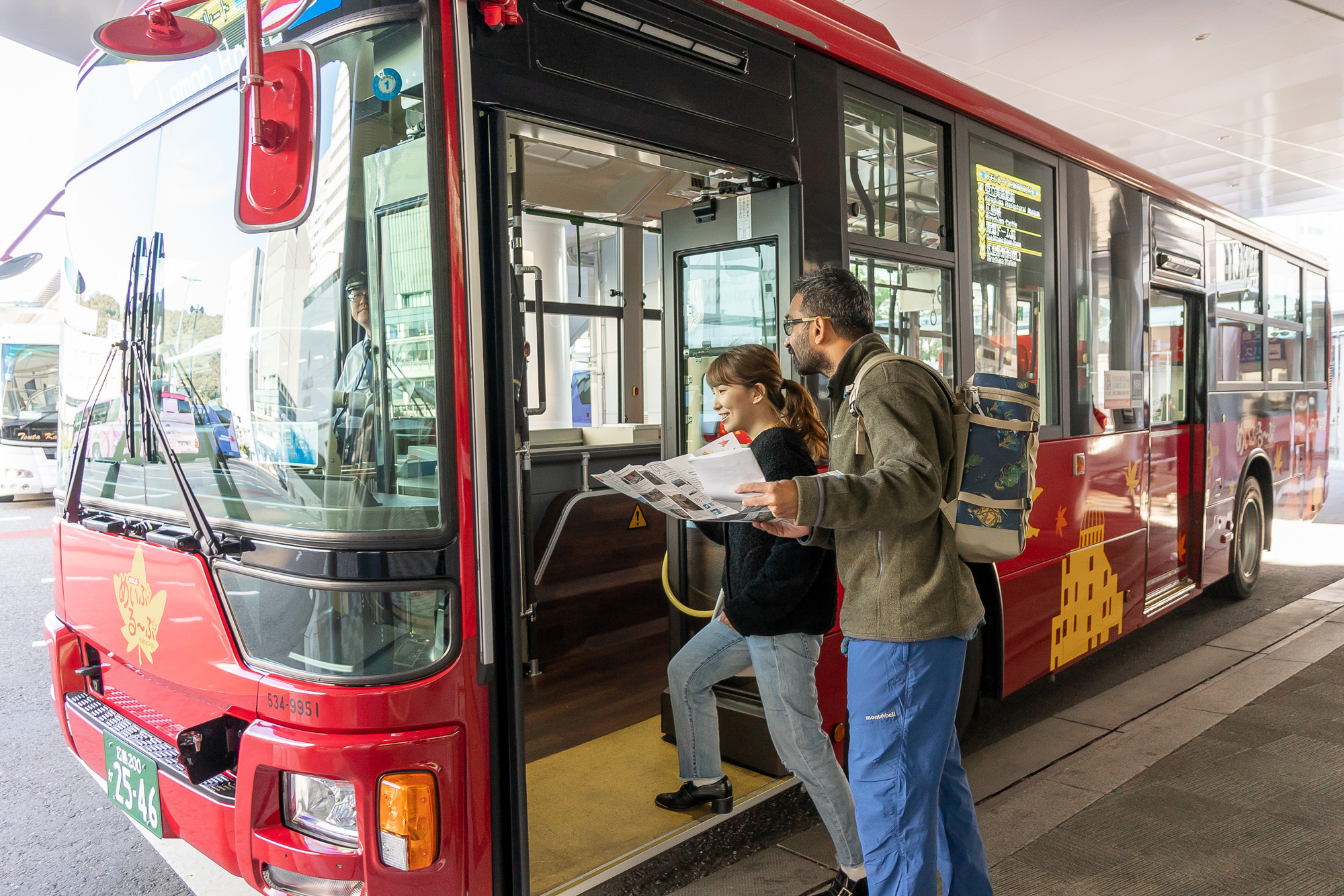
History Through the Arts: A Comprehensive View of Hiroshima Through Culture
- About 5-8 Hours
- About 12 km
Using the Hiroshima Maple Loop Sightseeing Bus, (※) this self-guided bus tour takes you to all three of Hiroshima's art museums, as well as important cultural sites like the scenic Shukkeien Garden and Hiroshima Castle, plus memorials to famous poets located in downtown Hiroshima Peace Memorial Park, and more. ※Other than pro-traffic IC card "PASPY", 10 cards including "ICOCA" are available, too. We can take bus by showing "JAPAN RAIL PASS" or "JR-WEST RAIL PASS" to driver. In addition, "JR-WEST RAIL PASS" applies only to ticket which we can use in Hiroshima.
Self-Guided Tour Overview
Hiroshima station, nigitsu shrine (from the bus window).
- Bus (about 5 minutes)
Hiroshima Prefectural Art Museum (Shukkeien Garden)
- Hiroshima Prefectural Art Museum
Shukkeien Garden
- Walk (about 5 minutes)
- Monument to Sadako Kurihara
Hiroshima Castle
- Bus (about 2 minutes)
Hiroshima Museum of Art (Shimin Byōin-mae)
Hiroshima museum of art.
- Hiroshima City Cinetamatographic and Audio-Visual Library
- Edmund Blunden Monument
- Bus (about 7 minutes)
Peace Memorial Park (Hiroshima Peace Memorial Museum)
- The West Peace Bridge
- The Peace Bridge
- Sankichi Tōge Memorial Monument
- Bus (about 15 minutes)
Hiroshima City Museum of Contemporary Art (Manga Library)
Hiroshima city museum of contemporary art.
- Hiroshima City Manga Library
- The Gobenden Open Space
- Bus (about 10 minutes)
Hiroshima Station (Shinkansen Exit)
Experiences.
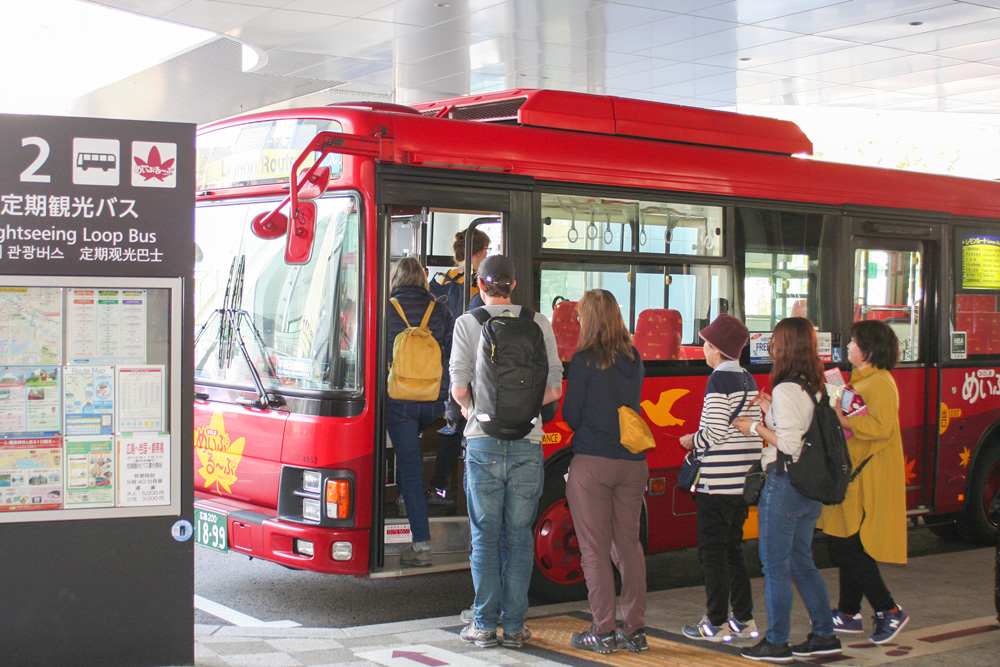

Hiroshima Maple Loop Sightseeing Bus (Meipuru~pu)
One-day tickets with unlimited rides available for only 400 yen! Hop on the best way to visit all the best sights and museums in Hiroshima City. This tour uses the Orange or Lemon Route -- for details, tap the link below!
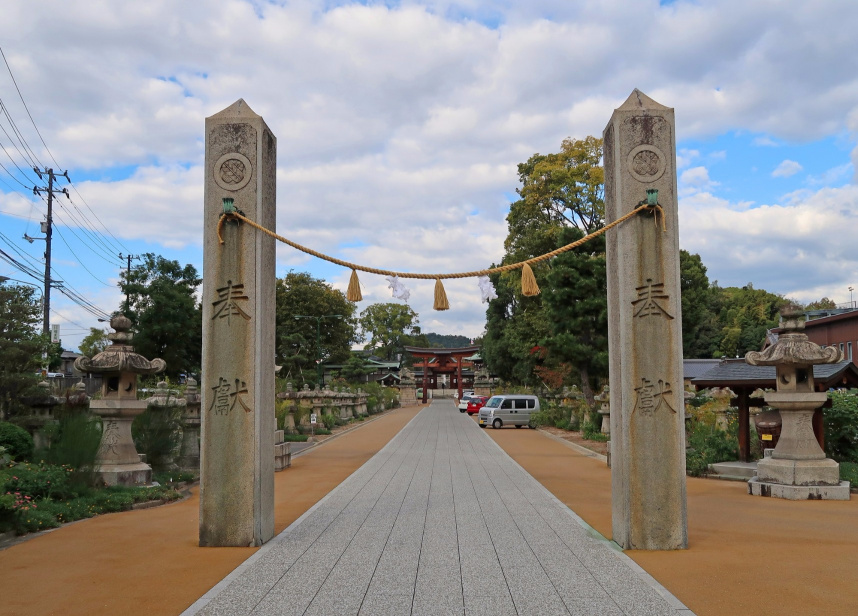
After departing from Hiroshima Station, you'll see Nigitsu Shrine on your right. The shrine sustained heavy damages in the bombing, and today, a water basin which survived the bombing is still in use inside the shrine complex. For more information, tap the link below.
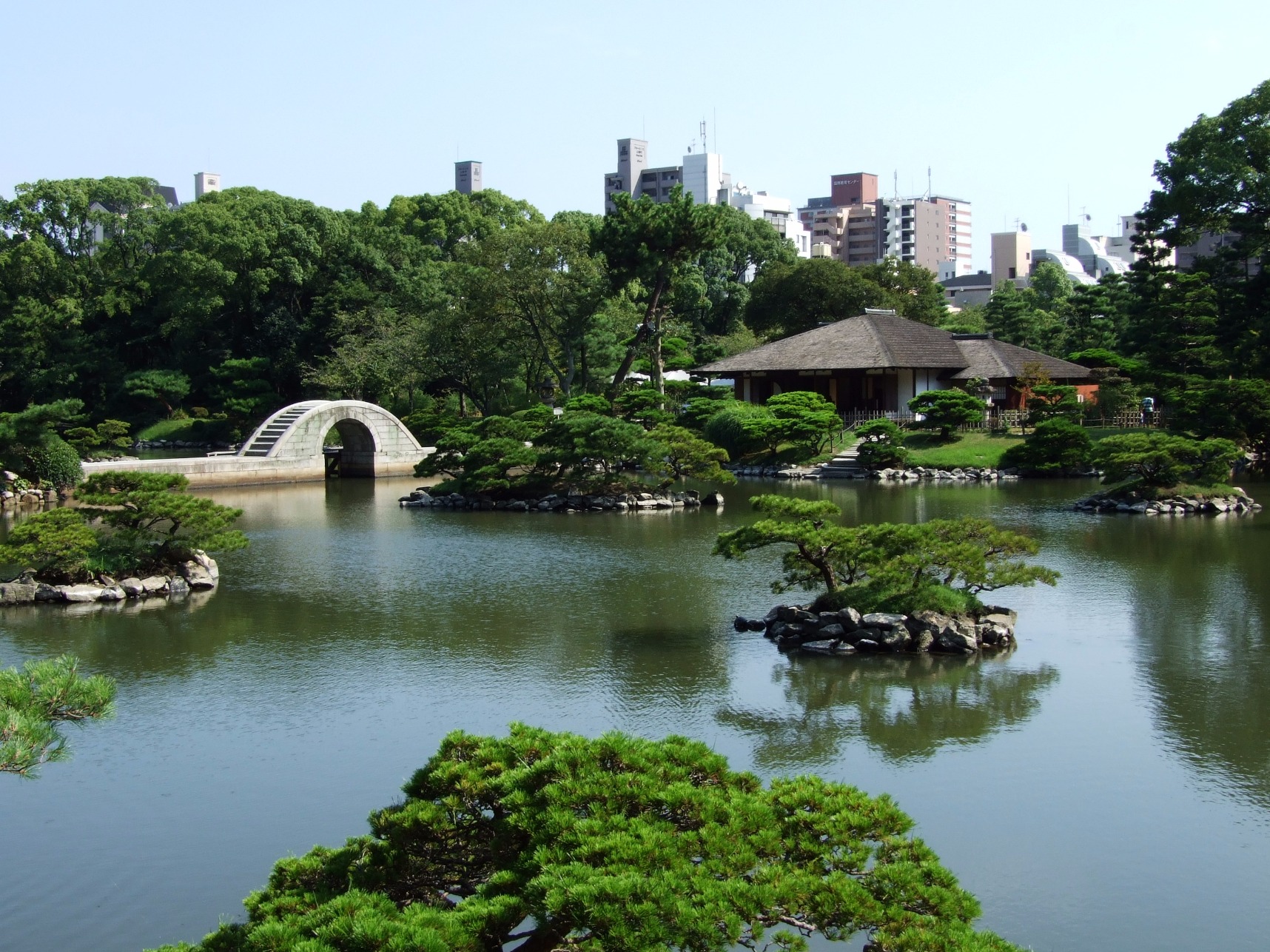
Created in 1620 as a villa for the Asano Clan by renowned tea master and high-ranking Asano clan retainer Shigeyasu Ueda, Shukkeien Garden is said to have been modeled after the iconic Xī Hú (lit. West Lake) in China. Although it suffered catastrophic damages in the August 6 bombing, Shukkeien has been restored to the beauty that you see today. Conveniently located next to the Prefectural Art Museum, and near the Sadako Kurihara Monument.
Recommended
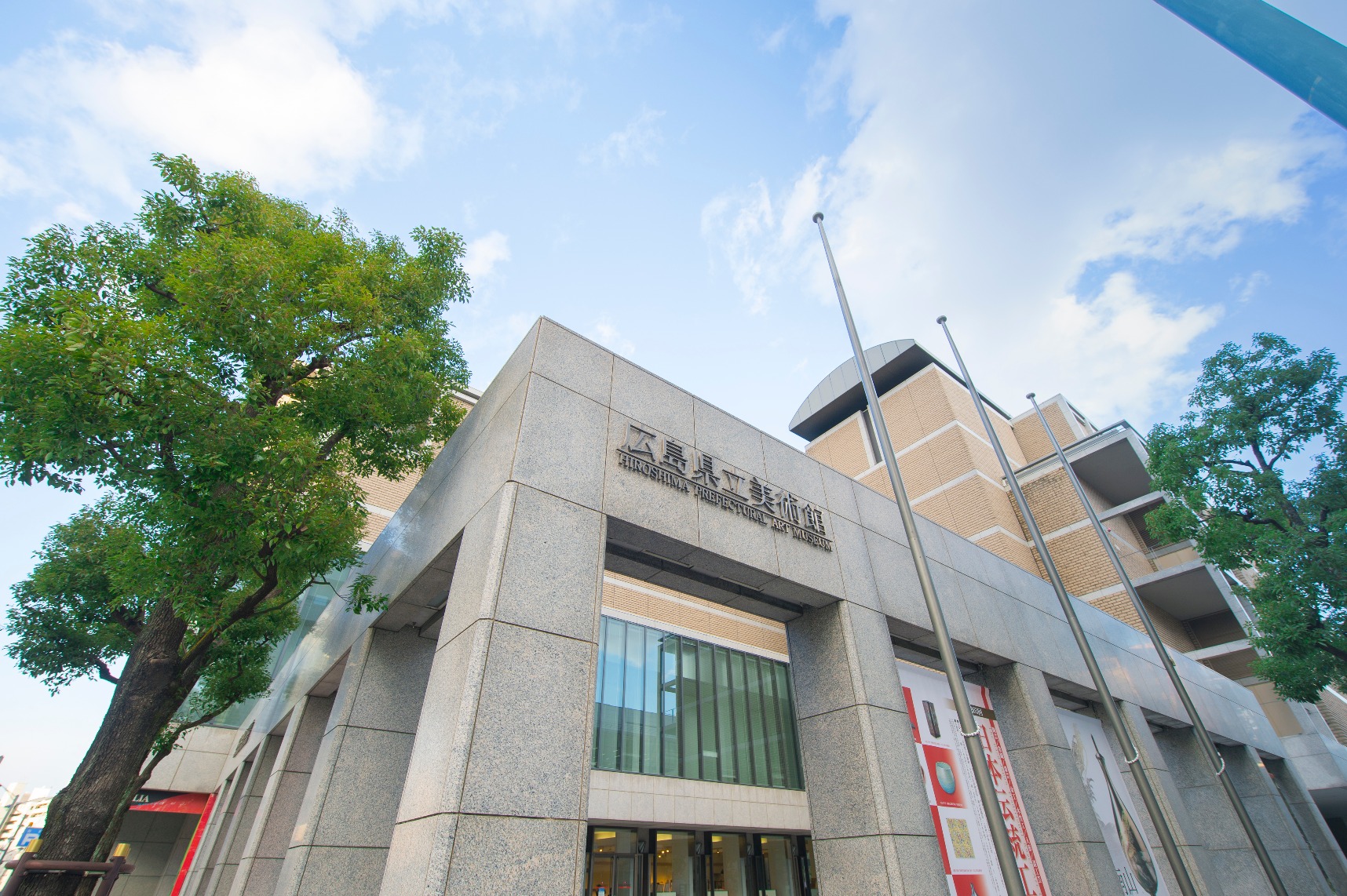
Walk through the historic grounds of Hiroshima Castle, built by Lord Mōri Terumoto in 1589. Although the original castle tower and other buildings inside the castle grounds remained into the Meiji Era, they were completely destroyed in the August 6 bombing, and were rebuilt in 1958 as a museum showcasing the history of Hiroshima. Nearby, you can also find the Former Site of the Hiroshima Imperial Military Headquarters, and the Ruins of the Chugoku Regional Military Headquarters Air Defense Room, from which the very first report of what happened in Hiroshima was dispatched by a student via military phone.
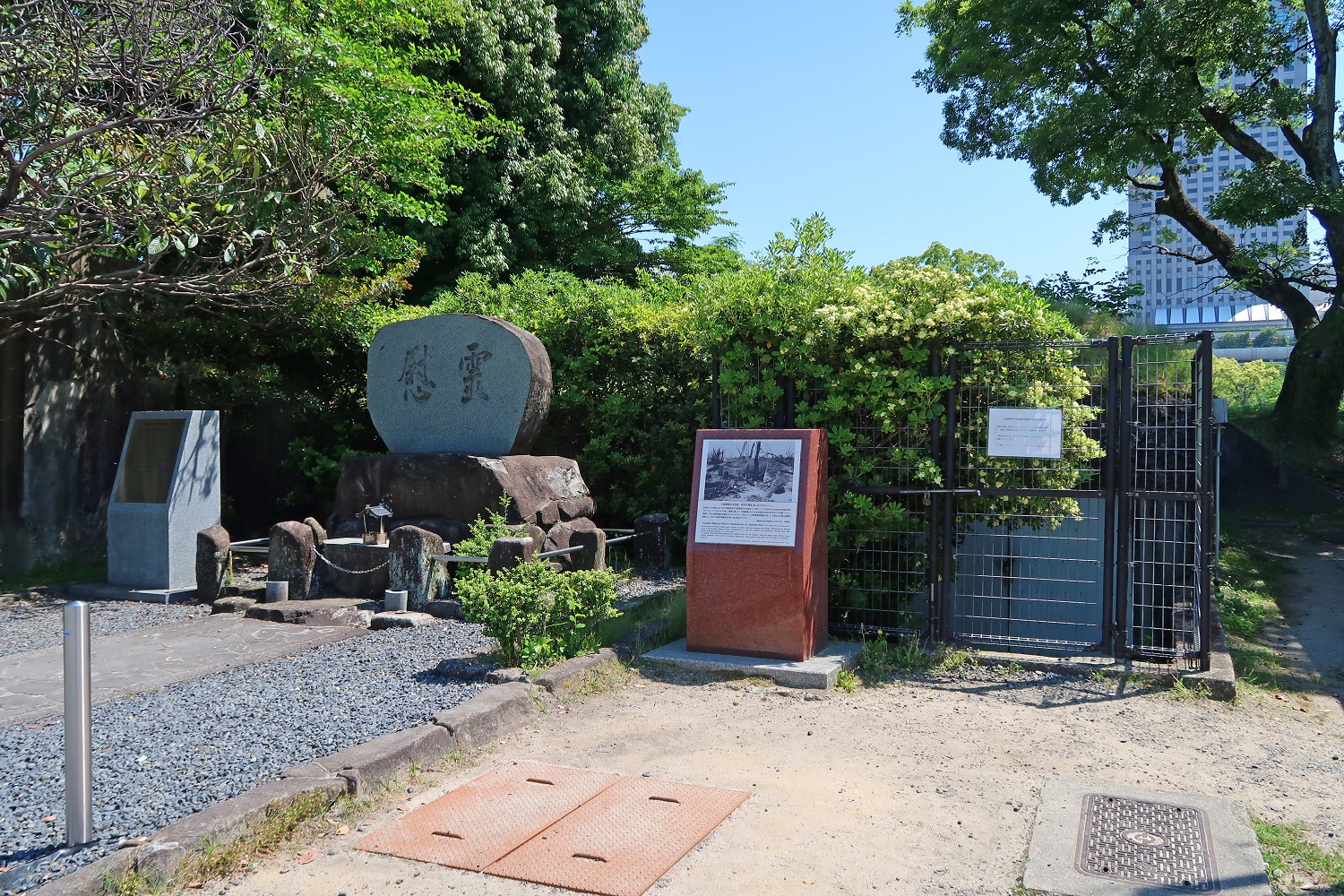
Built in November 1978 to commemorate the 100th anniversary of the founding of Hiroshima Bank, their permanent collection is home to roughly 90 pieces of European contemporary art from legendary artists like Monet, Renoir, and Van Gogh. Nearby, you'll find the Edmund Blunden Monument, dedicated to the British poet and pacifist. Blunden published the poem "A Song for August 6, 1949" and the monument is inscribed with the poem in English and Japanese.

The park was constructed under the 1948 Hiroshima Peace Memorial City Construction Law to serve as a symbol of everlasting peace and a place of recreation and leisure for the citizens of Hiroshima.
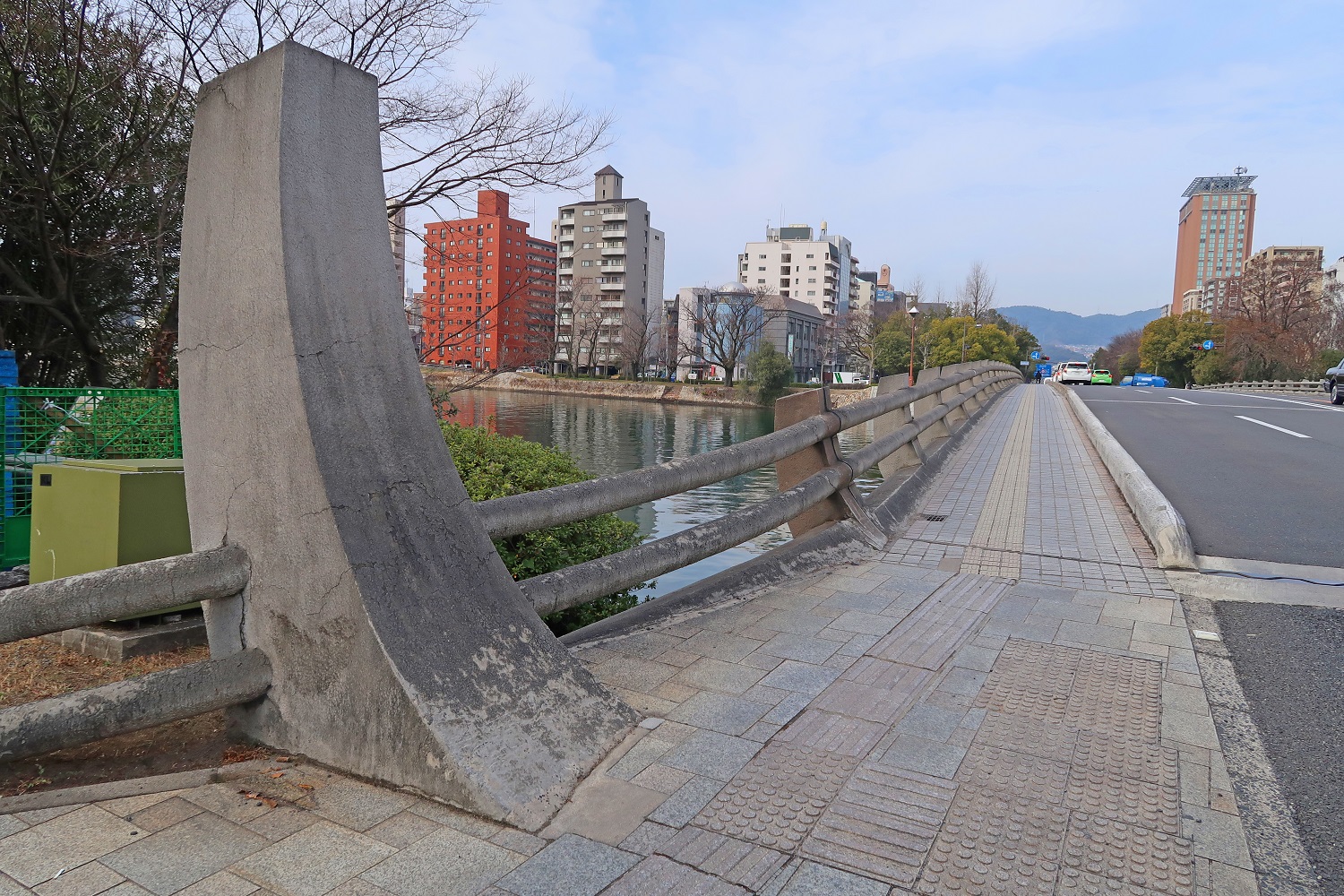
Opened in 1989, the Hiroshima City Museum of Contemporary Art was the very first public museum dedicated to contemporary art in all of Japan. Designed by renowned architect Kishō Kurokawa, the museum sits atop Hijiyama Hill, offering visitors a beautiful panoramic view of the city among the lush greenery of the hill.
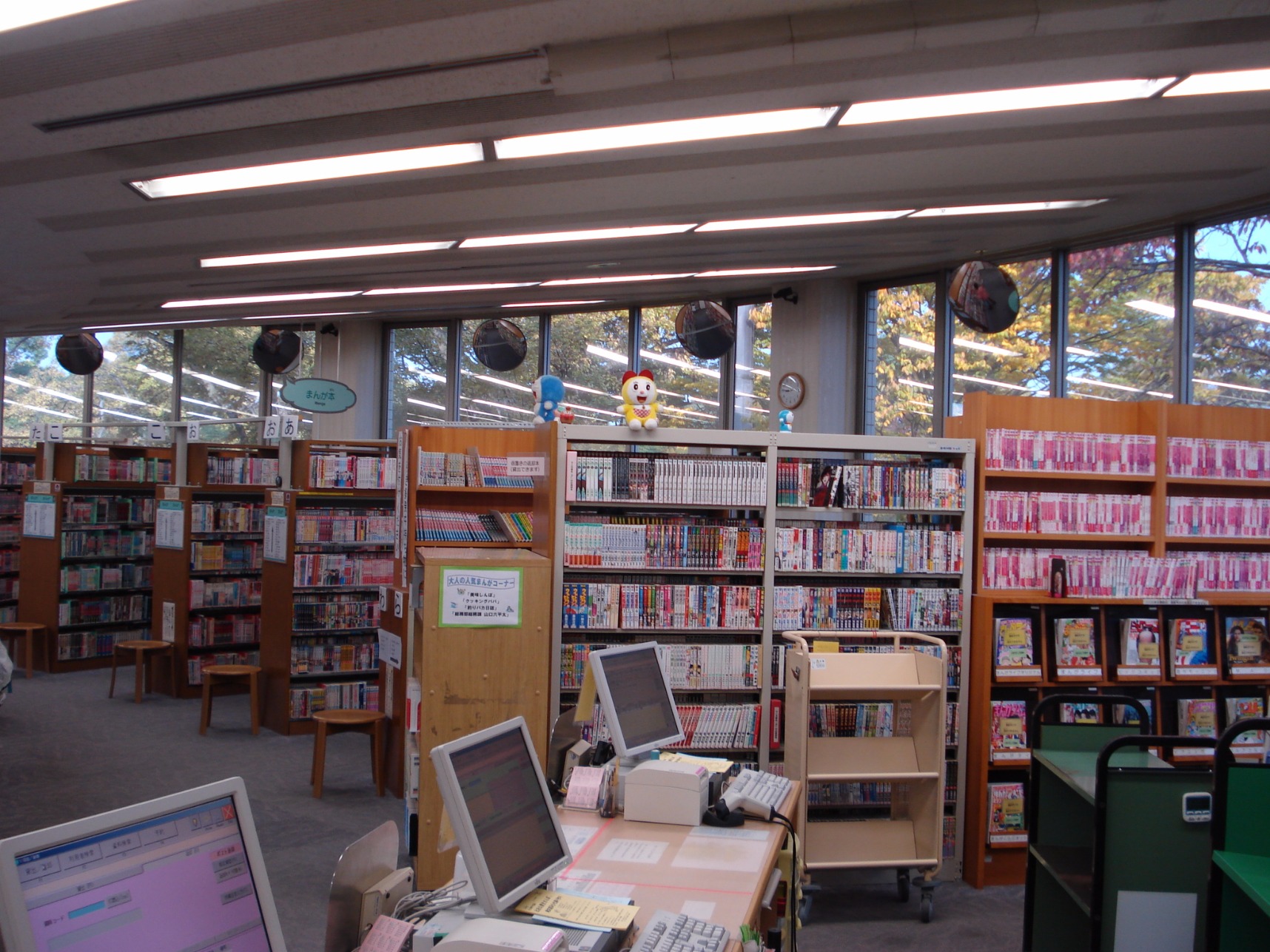
We've now reached the end of your tour back at the Shinkansen Exit of Hiroshima Station. Here you can find all kinds restaurants and Hiroshima-made craftworks and souvenirs to bring back home and share!
Hiroshima Bus Center Information

Tourist Information Center
This Tourist Information Center is located at Hiroshima Bus Terminal, at 3rd Floor of 'SOGO' department store. Quite It is easy to visit, as it is located right middle in Hiroshima city center, only 350 m away from Atomic Bomb Dome. Finding Bus stops is confusing? Don't worry, Hiroshima Bus Center covers the most of bus routes, from local bus within Hiroshima Prefecture to long distance coach for out side of Hiroshima Prefecture. Friendly staff of Tourist Information Center will advise you recommended tourist attractions and transportations. Coin Locker for Luggage and Free Wi-Fi are available here.

Food Court, 'BUS MACHI FOOD TOWN'
Located just next to Hiroshima Bus Center, ‘Bus Machi Food Hall, offers so many variety of fine food. There are sevral food shops with total 135 seats, you can pick up your favorite food from wide range of choices of such as Teppan yaki grill, Pizza & Pasta, Noodles, Light snack, Healthy salad and so on. You will also find beer, wine, sake... and more! There is FREE Wi-Fi service and charging points for USB. Enjoy rich, stylish atmosphere with fine food!

THE 10 BEST Hiroshima Tours & Excursions
Hiroshima tours.
- Historical & Heritage Tours
- Walking Tours
- Sightseeing Tours
- Up to 1 hour
- 1 to 4 hours
- 4 hours to 1 day
- 5.0 of 5 bubbles
- 4.0 of 5 bubbles & up
- 3.0 of 5 bubbles & up
- 2.0 of 5 bubbles & up
- Likely to Sell Out
- Special Offers
- The ranking of tours, activities, and experiences available on Tripadvisor is determined by several factors including the revenue generated by Tripadvisor from these bookings, the frequency of user clicks, and the volume and quality of customer reviews. Occasionally, newly listed offerings may be prioritized and appear higher in the list. The specific placement of these new listings may vary.

1. Hiroshima / Miyajima Full-day Private Tour with Government Licensed Guide

2. Full Day Bus Tour in Hiroshima and Miyajima

3. Hiroshima in a Nutshell: Morning Bike Adventure

4. Hiroshima City 4hr Private Walking Tour with Licensed Guide

5. Hiroshima Peace (Heiwa) Walking Tour at World Heritage Sites

6. Osaka Departure - 1 Day Hiroshima & Miyajima Tour

7. Hiroshima Custom Private Walking Tour with Licensed Guide (4/7h)

8. Hiroshima Departure - 1 Day Hiroshima & Miyajima Tour

9. Hiroshima and Miyajima 1 Day Walking Tour

10. Miyajima Half-day Trip Historical Walking Tour

11. Hiroshima Private Guided Day Tour from Osaka

12. Hiroshima Cycling Peace Tour with Local Guide (Long Course)

13. Miyajima Half-day Private Tour with Government Licensed Guide

14. All-inclusive Hiroshima Nighttime Food and Cultural Immersion

15. Japanese Traditional Archery Experience Hiroshima

16. Hiroshima Bar Hopping Food Tour

17. One Way Hiroshima Airport to Hiroshima

18. Hiroshima Cycling Peace Tour with Local Guide

19. Hiroshima and Miyajima Bus Tour with Indian Lunch

20. Half Day Private Guided Walking Tour in Hiroshima City

21. Hiroshima Miyajima and Bomb Dome Private Tour

22. 4 Hour Private Tour Highlight of Hiroshima with Licensed Guide

23. Hiroshima Morning Hike Tour&Open-air Tea Ceremony

24. Guided Virtual Tour of Peace Park in Hiroshima/PEACE PARK TOUR VR

25. The Peace Memorial to Miyajima : Icons of Peace and Beauty

26. Half day - Oku-yuki River Trekking!

27. Hiroshima Best Spots 6h Private Tour with Licensed Guide

28. Best of Hiroshima Food Tour

29. Miyajima Island Tour with Certified Local Guide

30. Private Half-day Hiroshima Peace Tour and River Cruise
What travelers are saying.

- Buy Tickets
- チケットを購入・使用する Buy and Use Tickets
- Buy and Use Tickets
Ticket Information
Choose from a wide range of options based on a combination of sightseeing areas and public transportation, hiroshima city and miyajima areas, use the streetcars to travel leisurely throughout the city of hiroshima, hiroden streetcar ticket (8/24 hours).

- 8 hours Adults: 600 yen Children: 300 yen
- 24 hours Adults: 700 yen Children: 350 yen
For Tourists Visiting the World Heritage Site "Miyajima" in Addition to Hiroshima City!
Hiroden streetcar and ferry ticket (24 hours).

- 24 hours Adults: 1,000 yen Children: 550 yen
- Miyajima Visitor Tax(100yen)included.
- An optional "Miyajima Ropeway Discount Ticket" is also available.
For Trips to See Everything from the World Heritage Site "Miyajima" to Other Sites Throughout Hiroshima Prefecture!
Visit hiroshima tourist pass (24/48/72 hours).

- 24 hours Adults and Children: 1,000 yen
- 48 hours Adults and Children: 1,500 yen
- 72 hours Adults and Children: 2,000 yen
- Not including the Miyajima Visitor Tax(100yen).
- A variety of optional tickets are also available.
Travel to Hiroshima City Quickly from Hiroshima Airport!
Hiroshima - hiroshima airport line (limousine bus).

- One-way Adults: 1,450 yen Children: 730 yen
- Round-trip Adults: 2,620 yen Children: 1,310 yen
Travel around Hiroshima City on an Electric Bicycle
1-day bicycle sharing pass.

- 1 day Adults and Children: 1,100 yen
Kure City Area
Visit all sightseeing spots in kure by bus, kure 24-hour pass.

- 24 hours Adults: 500 yen Children: 250 yen
Travel to Kure City Quickly from Hiroshima Airport!
Kure - hiroshima airport line, etajima area, a trip to etajima, the nearest island to hiroshima, to enjoy 'island time', etajima 24-hour pass.
- 24 hours Adults: 800 yen Children: 400 yen
North Area of Hiroshima Prefecture
Trip around sandankyo gorge, a nation's special place of scenic beauty, bus ticket to/from sandankyo.
- One-way Adults: 1,570 yen Children: 790 yen
option 各チケットにロープウェーなど オプション券を付けられる!

各チケットの詳細ページでチェック!
Types of Tourist Passes
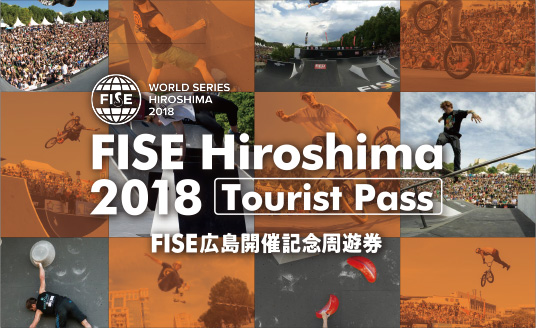
You can ride the trains, buses, and boats within the valid area as many times as you like. Show your pass to the crew or staff member when disembarking.(For the Meipuru~pu, show your pass when boarding.)
【For foreign visitors】
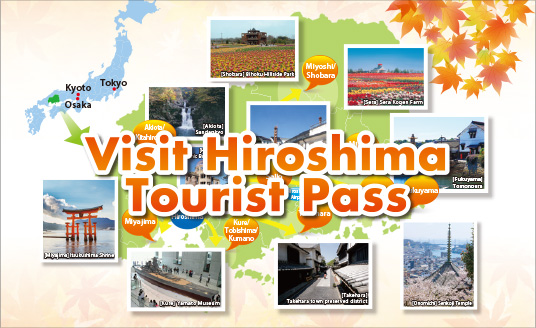
When using a streetcar or bus, show the dates stamped on this ticket to the crew or the clerk in charge when disembarking. When using ferry, show the dates stamped on this ticket to the clerk in charge at the entrance to the boarding area
Usable Areas

Available transportation


Hiroshima: 1, 2 or 3 Day Tourist Travel Card
- Hiroshima , Tour Reviews
The ‘Hiroshima: 1, 2 or 3 Day Tourist Travel Card’ is a flexible and convenient option for exploring Hiroshima and its surrounding areas. With unlimited boarding on public transportation, including streetcars , ferries , and buses , travelers can easily navigate the city.
The travel card also offers free cancellation and a pay later option, ensuring a worry-free trip. Discount coupons for attractions and positive customer reviews make this travel card a cost-effective and popular choice for visitors to Hiroshima.
Quick Takeaways
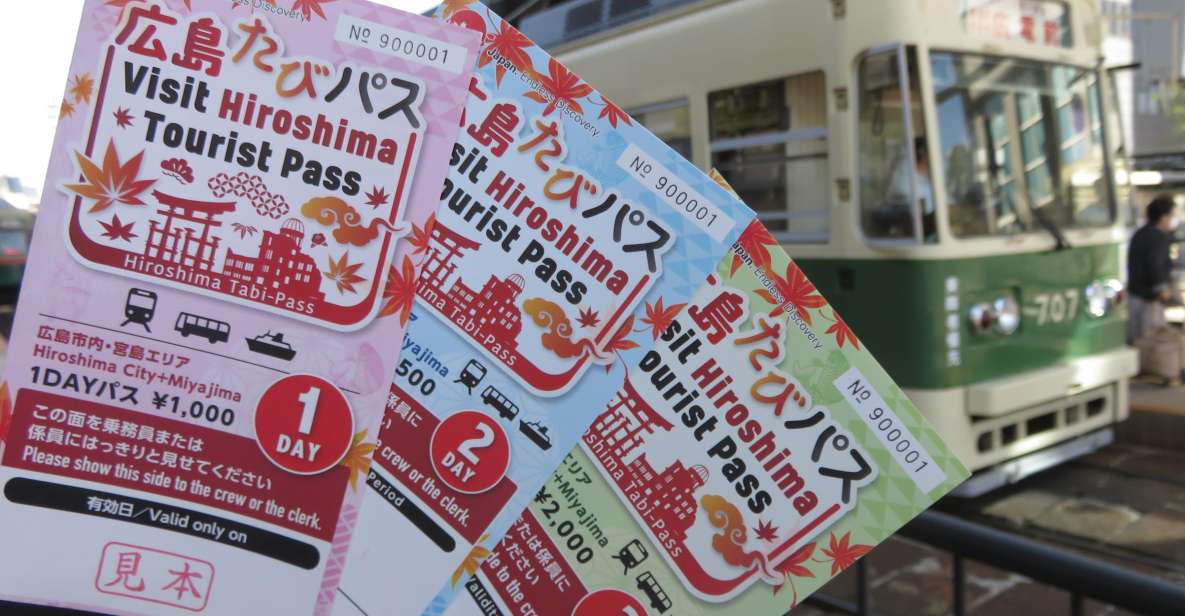
- Free cancellation available up to 24 hours in advance for a full refund
- Unlimited boarding on public transportation in Hiroshima
- Access to Miyajima, including the Floating Torii Gate and Itsukushima Shrine
- Discount coupons included in the pass for attractions in Hiroshima
Not for you? Here's a few more great tours and experiences nearby.
Private Miyajima Oyster and Sakurao Whisky Distillery Tour
- Private Sushi Making Experience & Sushi Lunch In Hiroshima
- Private Full-Day Okunoshima and Hiroshima Sake Breweries Tour
- Private Hiroshima Oyster Lunch Cruise on the Seto Inland Sea
Booking Details and Options

Booking the Hiroshima: 1, 2 or 3 Day Tourist Travel Card can be done easily and conveniently. There are various booking options available for this pass, allowing travelers to choose the duration that suits their needs.
The card is valid for 1, 2, or 3 days , depending on the option selected. Plus, the booking process offers a flexible cancellation policy , allowing free cancellation up to 24 hours in advance for a full refund. This ensures that travelers can keep their plans flexible and make changes if needed.
To book the travel card, participants can check the availability and select the desired date. Meeting points vary depending on the option booked, including Hiroshima Train Station North Exit, Hiroshima Airport , and Hiroshima Bus Center.
Activity and Benefits Included
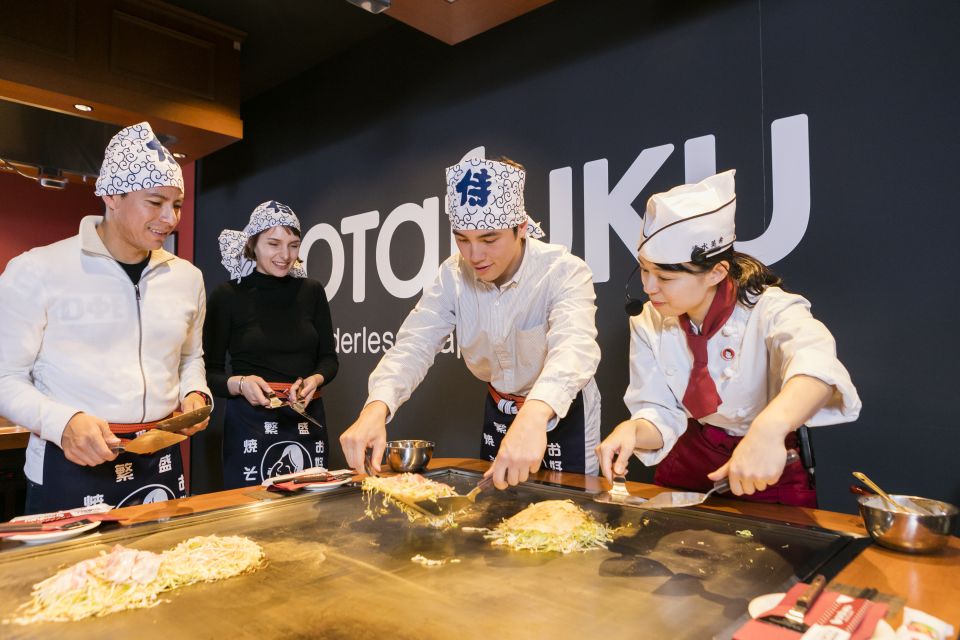
The activity and benefits included with the Hiroshima: 1, 2 or 3 Day Tourist Travel Card offer visitors unlimited boarding on public transportation in Hiroshima and access to Miyajima, where they can see the Floating Torii Gate and Itsukushima Shrine.
With this card, travelers can enjoy the convenience of unlimited travel on streetcars, ferries , buses , and JR trains throughout Hiroshima.
Along With transportation, the card provides various benefits such as discount coupons for attractions in Hiroshima. This allows visitors to save money while exploring popular sites like the Hiroshima Peace Memorial Park and Hiroshima Castle.
The highlight of the card is the access it provides to Miyajima, a UNESCO World Heritage Site famous for its iconic Floating Torii Gate and Itsukushima Shrine.
Inclusions and Route Map
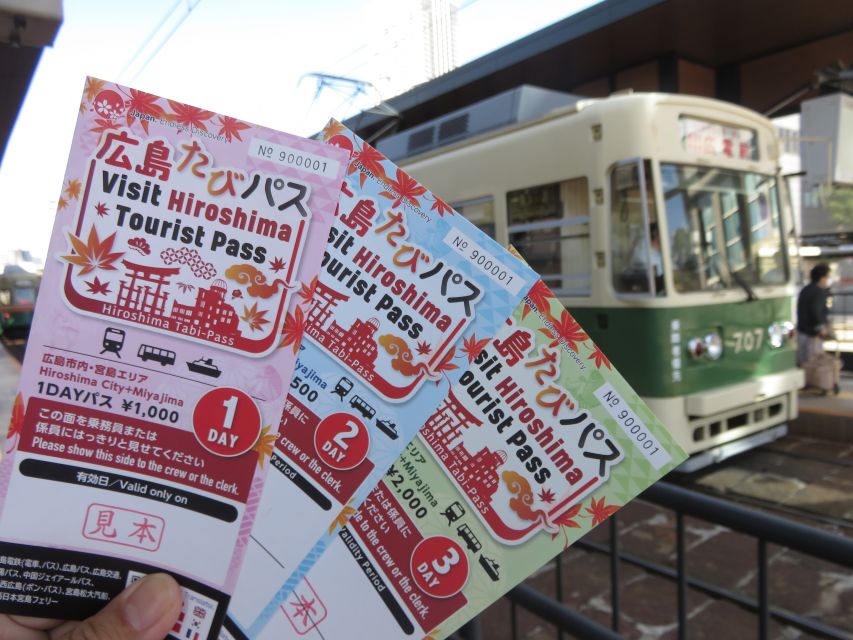
The Hiroshima: 1, 2 or 3 Day Tourist Travel Card includes various inclusions and a route map for easy navigation.
- The tourist pass is available for 1, 2, or 3 days , depending on the option selected.
- The pass includes a route map, providing travelers with a clear guide to navigate through Hiroshima.
- Discount coupons for attractions in Hiroshima are also included in the pass, allowing visitors to save money while exploring the city.
- The pass covers various modes of transportation, including streetcars , ferries, buses, and JR trains , providing unlimited boarding on public transportation in Hiroshima.
With the route map and the convenience of the tourist pass, travelers can easily plan their itinerary and explore Hiroshima’s popular attractions without any hassle. The inclusion of discount coupons further enhances the value of the pass, making it a cost-effective option for travelers.
Transportation Coverage and Modes

The tourist pass provides extensive transportation coverage and includes various modes of transportation for convenient travel throughout Hiroshima. With this pass, travelers have unlimited boarding on public transportation options , including streetcars and ferries , allowing them to easily explore the city and its surrounding areas.
Streetcars are a popular mode of transportation in Hiroshima, offering a convenient way to navigate through the city’s streets and visit popular attractions.
Plus, the pass covers ferry transportation, providing access to Miyajima, a must-visit destination famous for its Floating Torii Gate and Itsukushima Shrine, both designated as World Heritage Sites.
The inclusion of these different modes of transportation in the pass ensures that travelers can efficiently and comfortably explore Hiroshima and its surrounding areas.
Customer Reviews and Feedback
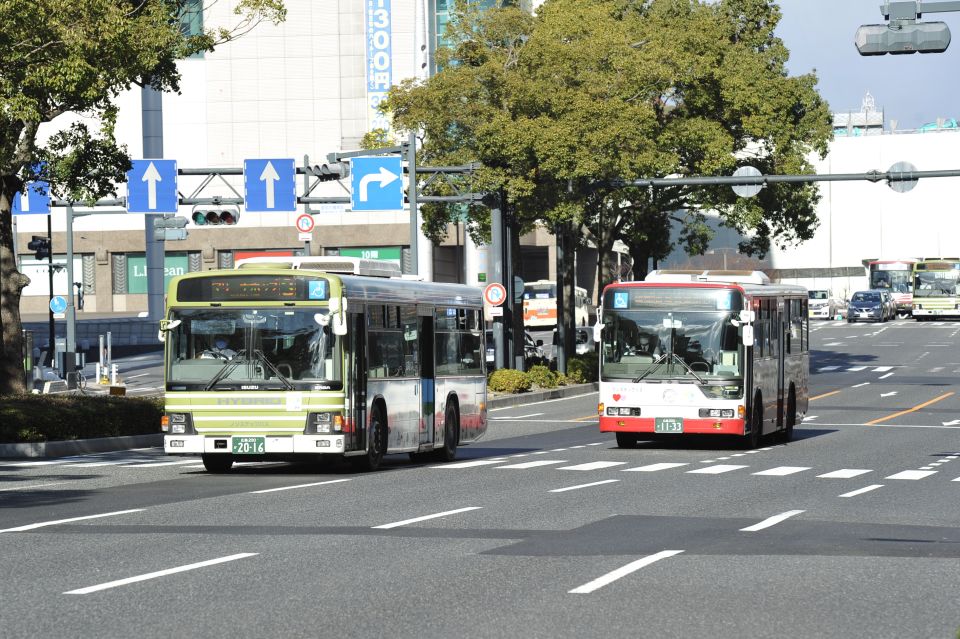
Based on 14 customer reviews, the tourist travel card for Hiroshima has received an overall rating of 4.4/5.
Here are some key points from the customer reviews:
- Positive feedback on the usefulness of the pass: Many customers found the travel card to be very convenient and helpful for exploring Hiroshima. It allowed them to travel unlimitedly on public transportation, including streetcars, ferries, buses, and JR trains.
- Transportation savings and discounts: Customers appreciated the savings they made on transportation costs by using the travel card. The pass also included discount coupons for attractions in Hiroshima, making it even more valuable.
- Confirmation of helpfulness: Several customers confirmed that the travel card enhanced their travel experiences in Hiroshima. It provided them with easy access to popular tourist destinations like Miyajima, where they could see the Floating Torii Gate and Itsukushima Shrine.
- Overall customer satisfaction : The positive customer reviews and high rating indicate that the tourist travel card for Hiroshima is well-received and meets the expectations of travelers seeking convenient and cost-effective transportation options.
Noteworthy Points and Highlights
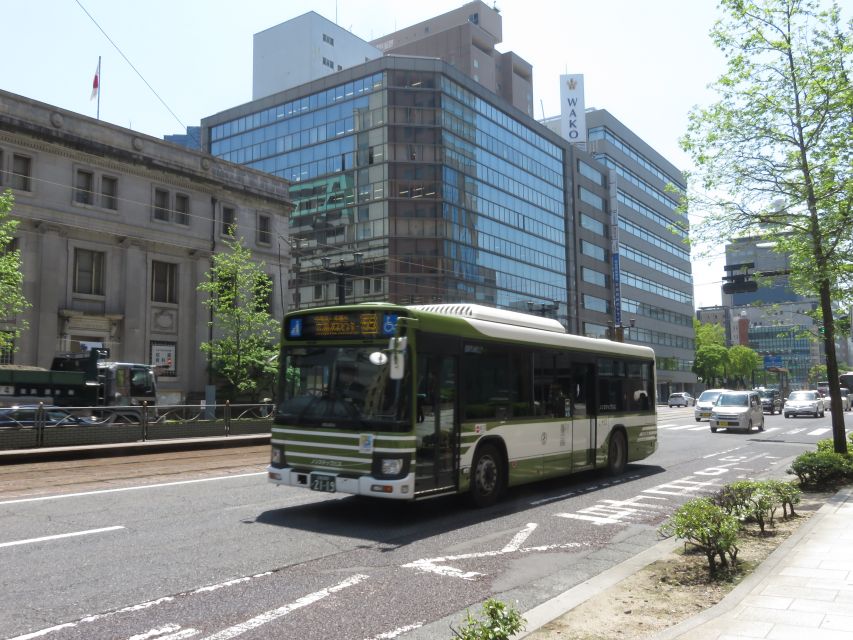
With the tourist travel card for Hiroshima, visitors can enjoy unlimited boarding on various modes of transportation and access to popular attractions.
The benefits of the tourist pass are numerous. Not only does it provide unlimited boarding on public transportation in Hiroshima, but it also grants access to Miyajima, a popular tourist destination known for its Floating Torii Gate and Itsukushima Shrine, a designated World Heritage Site.
Plus, the pass includes discount coupons for attractions in Hiroshima, allowing visitors to save money while exploring the city. The card covers various modes of transportation, including streetcars, ferries, buses, and JR trains, ensuring convenient and efficient travel throughout the region.
These noteworthy points, combined with positive customer reviews highlighting transportation savings and the usefulness of the pass, make the Hiroshima tourist travel card an excellent choice for visitors looking to explore the city and its popular attractions.
Frequently Asked Questions

How Do I Check the Availability of the Hiroshima: 1, 2 or 3 Day Tourist Travel Card?
To check the availability of the Hiroshima: 1, 2 or 3 Day Tourist Travel Card, simply visit the website or contact the activity provider, Hiroshima Electric Railway. The card offers unlimited rides and can be purchased online or in person.
Are There Any Age Restrictions for Participants of This Activity?
Age restrictions and participant requirements for the Hiroshima: 1, 2 or 3 Day Tourist Travel Card are not mentioned in the available information. It is recommended to check with the activity provider for any specific requirements.
What Are the Meeting Points for the Different Options of the Hiroshima: 1, 2 or 3 Day Tourist Travel Card?
The meeting points for the different tour options of the Hiroshima: 1, 2 or 3 Day Tourist Travel Card vary. Some options include Hiroshima Train Station North Exit, Hiroshima Airport , and Hiroshima Bus Center.
Can I Use the Tourist Pass to Visit Other Destinations Outside of Hiroshima?
Yes, the tourist pass allows visitors to explore local attractions in Hiroshima as well as visit nearby cities. It offers unlimited boarding on public transportation, including streetcars, ferries, buses, and JR trains.
How Do I Redeem the Discount Coupons Included in the Tourist Pass?
To redeem the discount coupons included in the tourist pass, simply present them at the participating attractions in Hiroshima. This is one of the best ways to maximize the benefits of the pass and explore Hiroshima.

To sum it up, the Hiroshima: 1, 2 or 3 Day Tourist Travel Card is a convenient and cost-effective option for travelers visiting Hiroshima.
With unlimited boarding on public transportation and discount coupons for attractions, visitors can easily explore the city and its surrounding areas while saving money.
The positive customer reviews highlight the transportation savings and usefulness of the travel card.
This travel card offers flexibility, convenience, and a great way to experience all that Hiroshima has to offer.
Related Posts

Private Airport Transfer Kansai Airport in Kyoto Using Hiace
- December 31, 2023

Seasonal Shuttle to Minami-Sado
- Itineraries
- Tours and Activities
- Travel Guides
- Best of Japan
JRailPass.com » Japan Travel Blog » Discover Hiroshima with the JR Pass
Discover Hiroshima with the JR Pass
August 1, 2023
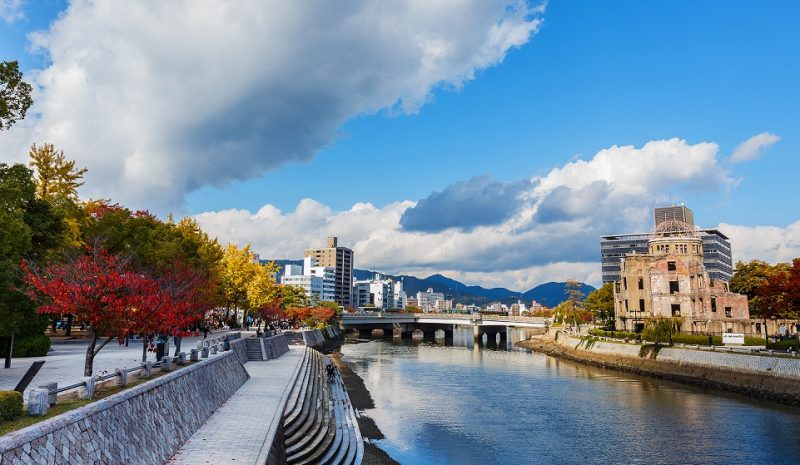
Hiroshima is a city with deep historical roots, evident in its ancient gardens and castles. During the 20h century, Hiroshima became the center of unenviable international attention after the first atomic bomb was detonated there on August 6, 1945 – destroying everything within two kilometers of impact.
Like the phoenix of legend, Hiroshima and its residents emerged from the ashes. Historical structures were restored, and the city took on aspirations of continued peace. Today, it is home to over one million people and a favorite stop for international tourists, thanks to the bullet train .
Where is Hiroshima
Hiroshima is the capital of the Hiroshima Prefecture and the largest city in the Chugoku region of western Honshu (main Japanese island).
You will find travel to the deeply meaningful city of Hiroshima a breeze when using your Japan Rail Pass . Please be aware that Nozomi and Mizuho trains are not currently included, but you can ride them by paying a supplement from October 2023.
Tokyo to Hiroshima by train
You can use your JR Pass to take the Tokaido Shinkansen line’s Hikari bullet train from Tokyo Station to Shin-Osaka Station , Shin-Kobe Station or Himeji Station.
Once in one of these stations, you can transfer to the Sanyo Shinkansen (Sakura train) and arrive in Hiroshima at Hiroshima Station.
This trip takes approximately five hours to complete. Non-shinkansen train lines are also available, as is an overnight bus. Several 90-minute flights also connect the Tokyo and Hiroshima airports each day.
Kyoto to Hiroshima
Kyoto and Hiroshima are connected by the Tokaido and Sanyo Shinkansen lines . You can use your JR Pass and the journey between Kyoto Station and Hiroshima Station takes 1 hour 40 minutes . The Nozomi Shinkansen trains only take 1 hour 15 minutes: you will be able to ride them with your pass from October 2023 if you pay a supplement.
If you catch a Hikari or Sakura Shinkansen train , you may have to make a transfer at Shin-Osaka Station or Shin-Kobe Station . Either way, it will only add 10-15 minutes to your journey. If you do not have a JR Pass, an unreserved seat costs 10,570 yen (an additional 510 yen for a reserved seat).
Osaka to Hiroshima
The quickest way to get to Hiroshima from Osaka is to catch a bullet train on the Sanyo line . The fastest train covered by the JR pass is the Sakura train which takes 1 hour 32 minutes . The Mizuho and Nozomi trains take 1 hour 25 minutes.
If you do not have a JR Pass, the cheapest way of making the journey is to catch a regular train. It takes 6 hours and you have to make several transfers but it only costs 5,620 yen (much cheaper than an individual ticket for a bullet train). However, if you plan to make just a couple of journeys in Japan, it makes sense to get the JR Pass.
Check out our article How to get from Osaka to Hiroshima for more information about this journey.
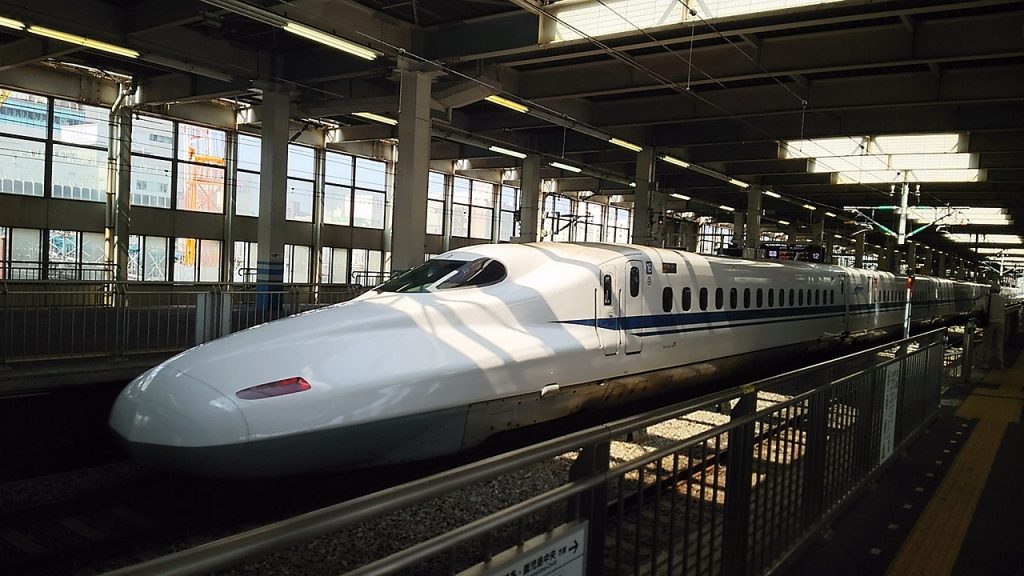
Airport transfer to Hiroshima Airport
If you are flying into Hiroshima Airport, the city center can be reached by the shuttle bus . The bus ride lasts approximately 50 minutes.
But the best option is to take the so-called Shiraichi Route (a combination of the JR Sanyo Shinkansen line and the shuttle bus). Take the shuttle bus from Hiroshima Airport and drop off after 15 minutes in JR Shiraichi Station (the closest JR station of Hiroshima Airport).
There you will be able to take the train to Hiroshima Station, where you can also exchange your Japan Rail Pass. This route is less affected by congestion on the Sanyo Expressway, and is less expensive .
Things to do in Hiroshima
Whether you come to contemplate the past, look to the future, or enjoy the beauty of nature, Hiroshima is home to several attractions that can be found nowhere else in the world .
Peace Memorial Park
Standing in contrast to the surrounding urban structures is the Heiwa Kinen Kōen , or Peace Memorial Park. This 120,000 square meter park marks the target of the atomic bomb . The area had been the center of commerce and politics in Hiroshima, but four years after the disaster it was decided that this portion of the city would not be rebuilt – it would stand forever as a symbol to honor the memory of nuclear horrors and advocate world peace .
The park is home to the Peace Memorial Museum , which details Hiroshima’s history, the advent of atomic weapons, and the human suffering that followed. This moving exhibit includes graphic elements that may be disturbing to some visitors. This, however, makes the point that peace should not be taken for granted. A nearby tomb, called the Cenotaph , holds a register of over 220,000 names of victims of the blast. This monument is aligned to frame the Peace Flame and the A-Bomb Dome, making for great, symbolic pictures.
Also on the grounds is the Hiroshima Peace Memorial, or Atomic Bomb Dome ( A-Bomb Dome). Declared a UNESCO World Heritage Site , this building was formerly known as the Prefectural Industrial Promotion Hall. The Hiroshima City Council decided in 1966 to indefinitely preserve the structure, so the shell that remains provides a tangible and undeniable connection to the events of that fateful day.
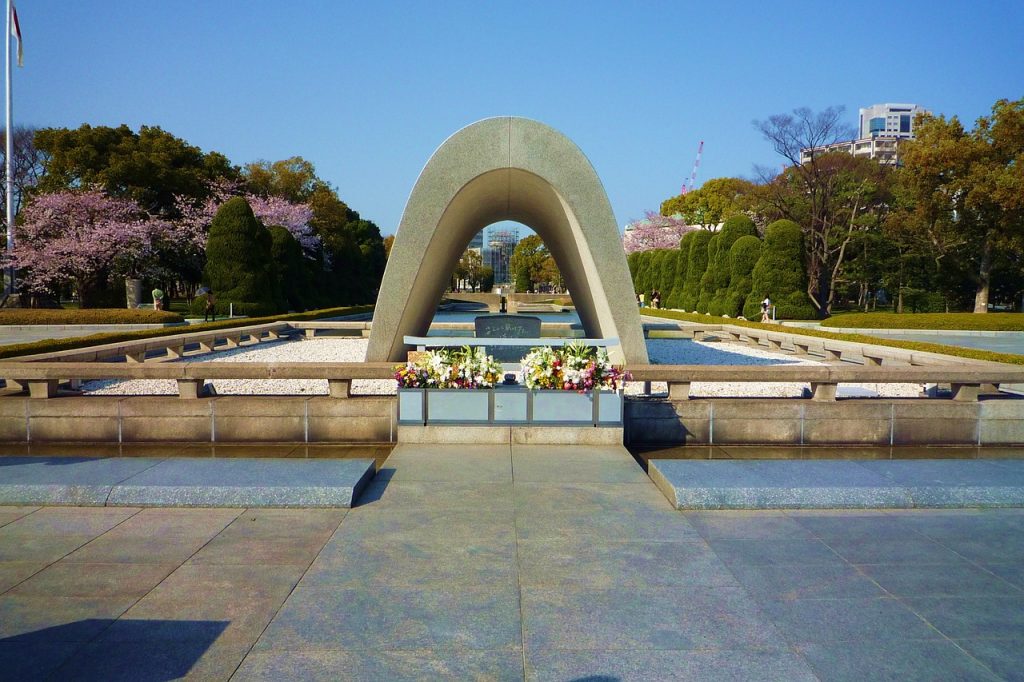
Hiroshima Castle
Also called the Carp Castle , this five-story structure was originally built in 1589. The castle served as the seat of power as well as Hiroshima’s economic center. The original castle was destroyed by the atomic bomb but has since been rebuilt in the traditional fashion . Along with the castle, its moat, shrine, and Ninomaru , or second circle of defense, were also reconstructed. The castle now houses a museum and visitors can enjoy scenic views of the city from its top floor.
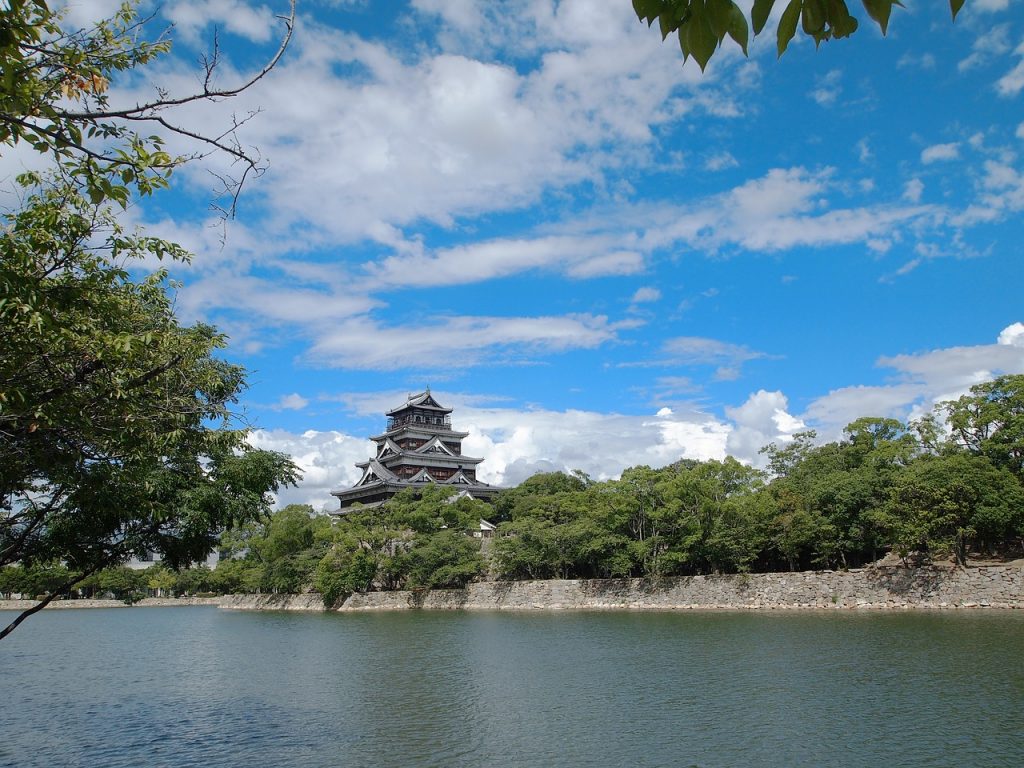
Shukkeien Garden
Constructed in 1620, this garden’s name literally means “garden of shrunken scenery.” The carefully cultivated plants and features mimic in miniature a mountainous, forested landscape. Visitors can enjoy the scenic views from the comfort of several tea houses , located around the pond.
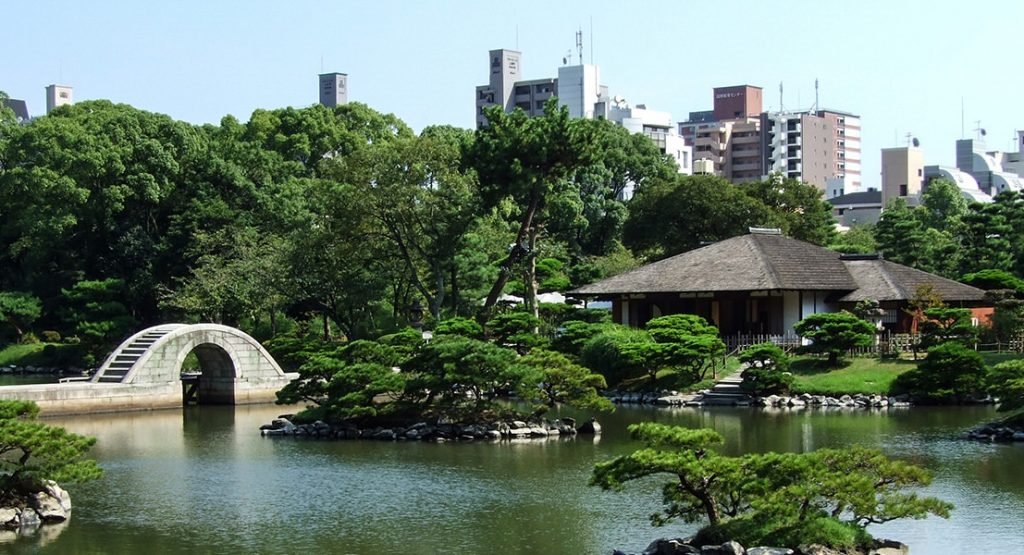
Getting around Hiroshima
While traveling in and around Hiroshima, you may take advantage of the city’s t ram network . The eight tram lines are extensive – the largest in Japan – with four of the lines passing through the main train station. Please note, however, that your JR Rail Pass is not valid on the tram lines. One-day passes for the tram lines can be purchased for ¥600.
City buses provide another good transportation option . The Maple-oop (a combination of the word “maple” with the term “loop bus”) bus provides free transportation for JR Pass holders. This bus runs twice per hour and serves the train station, the Peace Memorial Park, Hiroshima Castle, Shukkeien, and other locations.
Miyajima ferry
Did you know that your Japan Rail Pass allows free passage on the ferries to nearby Miyajima Island as well? Check out our Miyajima travel guide for more on this small island famous for its torii gate and scenic views.
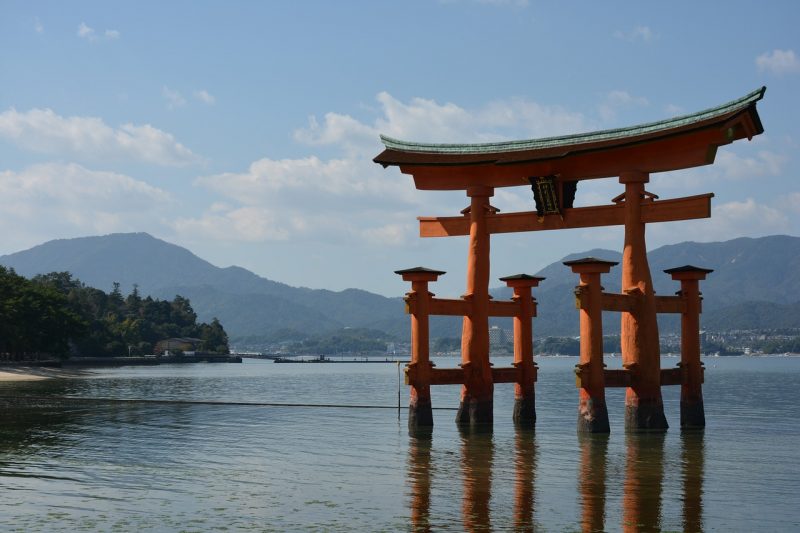
For in depth travel information on other destinations in Japan, please visit the destinations category of our article archives.
Related posts
Related tours & activities.
Hi, for my next trip to Japan, I will be using the JR Kansai-Hiroshima pass. On my last day in Hiroshima, can I use this pass as follows:
Option 1 – take bus all the way from Hiroshima station to Hiroshima airport; is it covered by the JR pass?
Option 2 – take train between Hiroshima station and Shiraichi station then transfer to bus to continue going to airport; is it covered by the JR pass?
Dear Sir/madam, we’re planning to cycle from Tokyo to Hiroshima, and back to Tokyo by public transport (train/bus) with our bicycles. it’s possible to travel with our bicycles? regards, Ruben
Hi Ruben! In Shinkansen bullet trains passengers are allowed to have their bike with them on board, for no additional fee. However, it is required that the bicycle is folded or disassembled and packed. Happy travels!
Hello, We have purchased out Japan Rail Pass and will be Arriving in Tokyo July 2. We want to travel from Tokyo to Hiroshima on the overnight train July 4. How do we make our reservations ahead of time? We are a family of four.
Hi Glenn! No seat reservations are available until the Japan Rail Pass is exchanged, which has to be done in Japan. Once this is done you’ll just need to take your Japan Rail Pass to any JR Ticket Office (Midori-no-madoguchi), spread through all Japanese train stations. Happy travels!
We are flying into Osaka on 14 April around 1:10pm, and we wanted to go to Hiroshima on the same day and then travel back to our hotel that night.
is that possible, what would be the quickest way to do this
Hi Dee! Hiroshima is one of the most popular day trips from Osaka since you can take a JR train with your Japan Rail Pass . However please make sure to check carefully the operation hours at Hyperdia since timing may be tight. Happy travels!
We are staying in Osaka and going to travel to Hiroshima and Miyajima. Would a stop in Himeji be possible on the Sanyo line?
Hi Barri! Yes, it is possible with your Japan Rail Pass . The Sanyo Shinkansen line has stops in Osaka, Himeji and Hiroshima. We would recommend you to take the Hikari train from Osaka to Himeji and then to reach Hiroshima from Himeji you will have to take the Kodama (slowest service on the Sanyo line since it makes more stops). Happy travels!
I need to travel from Hiroshima station back to Tokyo, may I know what is the best JR line I should take ?
Thank you for your advise.
Hi Jovi! You can first take the Sanyo Shinkansen (Sakura train) from Hiroshima at Hiroshima Station to Shin-Osaka Station, Shin-Kobe Station or Himeji Station. From there, you can transfer to the Tokaido Shinkansen line’s Hikari bullet train to Tokyo Station using your Japan Rail Pass . Happy travels!
Hi, I would like to visit Japan in April for the Cherry Blossom for 14 days. I will travel with my family (total of 4). We would like to explore Tokyo, Kyoto and Osaka perhaps Hiroshima as well. Please let me know what is the best itinerary for our trip? Can our JRP cover our trip from city to another city? I would be grateful if you can let us know.
Many thanks Cicilia
Hi Cicilia! We recommend you to check our Japan in 14 days: Travel itinerary for our best tips on how to make the most out of your 14-day trip with your Japan Rail Pass .
Hello! So i will go from Tokyo to Hiroshima using JR Pass and will take Hikari Shinkansen Hyperdia shows routes with several transfers (Tra.) My question is, i need to transfer only one time to be able to board the Sakura Shinkansen headed to Hiroshima Station, that is correct?
Hi Leandro,
Yes that is correct. Depending on the Hikari train, you will have to transfer at Shin-Osaka, Shin-Kobe or Himeji stations, only once.
Happy travels!
we planned to be in Tokyo on 18th.Sept.2018 for 15/16days Wish to travel from Tokyo to Hiroshima, stay 2 nights n visit Miyajima island, how long is the Shinkensan journey Then travel to Kyoto for few nights stay b4 travel journey to Hakone for 2 night n finally Tokyo for 4 nights Is this the best way to visit Japan
Hi Chor-Seng YEW!
To get to Miyajima from central Hiroshima, just take a tram to the Miyajimaguchi ferry port. The good news is thatou can use your Japan Rail Pass to access the JR ferry for free. The ferry ride takes only about ten minutes.
We hope you have an amazing time in Japan!
Dear Sir // madam,
There are many station names surfaced in my search for arrival station in Hiroshima , such as HigashiHoshima , NishiHiroshima , etc. Can you advise the correct arrival station name by Shinkansen Sakura from Fukuoka?
Hi Chee Sum Thiam!
The station to which you will arrive is Hiroshima Station.
Enjoy your trip!
Comments are closed.
- Subscribe Digital Print

- China geopolitics
- Fumio Kishida
- Japan crime
- Latest News
- Deep Dive Podcast
Today's print edition
Home Delivery
- Crime & Legal
- Science & Health
- More sports
- CLIMATE CHANGE
- SUSTAINABILITY
- EARTH SCIENCE
- Food & Drink
- Style & Design
- TV & Streaming
- Entertainment news
Overtourism-hit Kyoto launches new bus service for tourists

The city of Kyoto launched an express bus service on Saturday, connecting Kyoto Station with the area's major tourist destinations.
Kyoto's existing buses have been overcrowded with visitors. Through the new tourist-oriented bus service, the city hopes to disperse such visitors and thin the crowds presently clogging local lines that local residents rely on for daily use.
The new service will run buses that stop at popular tourist spots such as the Kiyomizu-dera and the Ginkaku-ji temples, as well as the Gion area.
The service is only available on Saturdays and Sundays, national holidays, the country's bon summer holiday period and the year-end and New Year holiday period.
Fares for the new service are ¥500 for adults and ¥250 for children, compared with the standard fare of ¥230 for other bus services operated by the city.
The Sightseeing Limited Express Bus service is also included in the existing one-day subway and bus pass, which costs ¥1,100 for adults and ¥550 for children.
A woman from Singapore who visited Kyoto with her family said that the fares for the new bus service were a bit expensive, but acceptable.
After using the new service to visit the Kyoto City Kyocera Museum of Art, she said that it was good that the bus was not so crowded.
Another visitor from Tokushima said that she was able to arrive early thanks to the new bus service, adding that the trip was "comfortable" and that she hopes to use it again.

In a time of both misinformation and too much information, quality journalism is more crucial than ever. By subscribing, you can help us get the story right.

Crash of an Antonov AN-24 in Moscow
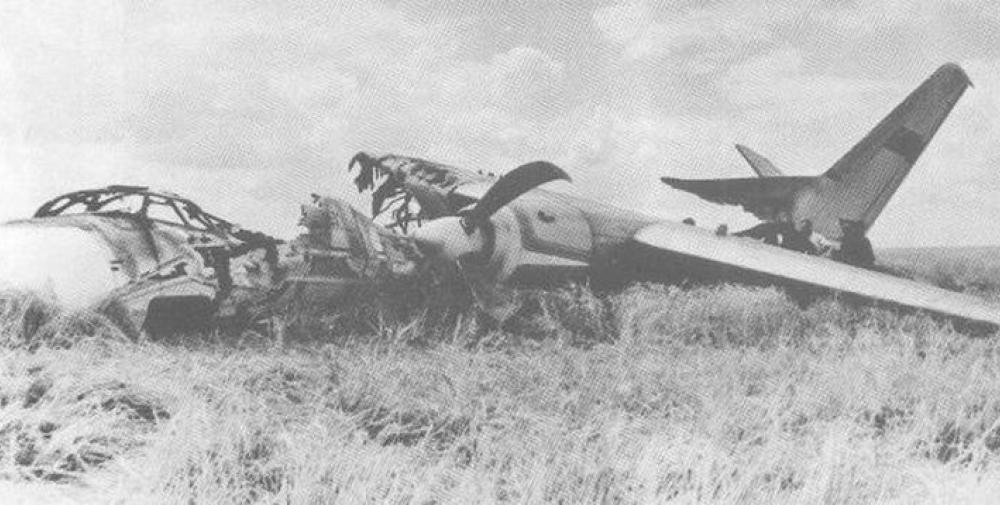
ロシア モスクワ州日の出日の入り時間
Location: ロシア >, 1900 1901 1902 1903 1904 1905 1906 1907 1908 1909 1910 1911 1912 1913 1914 1915 1916 1917 1918 1919 1920 1921 1922 1923 1924 1925 1926 1927 1928 1929 1930 1931 1932 1933 1934 1935 1936 1937 1938 1939 1940 1941 1942 1943 1944 1945 1946 1947 1948 1949 1950 1951 1952 1953 1954 1955 1956 1957 1958 1959 1960 1961 1962 1963 1964 1965 1966 1967 1968 1969 1970 1971 1972 1973 1974 1975 1976 1977 1978 1979 1980 1981 1982 1983 1984 1985 1986 1987 1988 1989 1990 1991 1992 1993 1994 1995 1996 1997 1998 1999 2000 2001 2002 2003 2004 2005 2006 2007 2008 2009 2010 2011 2012 2013 2014 2015 2016 2017 2018 2019 2020 2021 2022 2023 2024 2025 2026 2027 2028 2029 2030 すべて表示する.
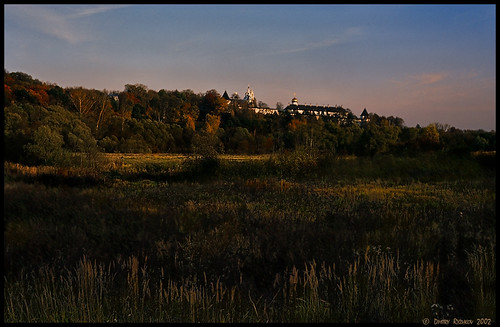
ロシア モスクワ州の地図
ロシア モスクワ州での場所
- 1-chōme-2-1 Higashimachi, Shiraoi, Shiraoi District, Hokkaido -, Japan日の出日の入り時間
- 11 Cedar Ave, Farmingdale, NY アメリカ合衆国日の出日の入り時間
- S Bannen Rd, Spokane Valley, WA, USA日の出日の入り時間
- 〒 烈嶼郷日の出日の入り時間
- アルゼンチン サルタ セクランタス日の出日の入り時間
- Waldsmith Way, Vandalia, OH アメリカ合衆国日の出日の入り時間
- Kipling Pl, Shreveport, LA アメリカ合衆国日の出日の入り時間
- Bonnie Street, Belle Vernon, PA, USA日の出日の入り時間
- Matsu Islands日の出日の入り時間
- No. 號, Minzu Rd, East District, Chiayi City, 台湾 麻古茶坊macu-嘉義民族店日の出日の入り時間
- Center of World Population
- Closest Large Cities
- Farthest Cities
- Longest Flights
- Most Isolated Cities
- Extreme Elevations
Country: Russia
Continent: Europe
Population: 11,514,300
Country Capital: Yes
For all cities with a population greater than five hundred thousand, Moscow is closest to Tula and farthest from Auckland . The closest foreign city is Gomel and the farthest domestic city is Vladivostok . See below for the top 5 closest and farthest cities (domestically, internationally and by continent) and to see which cities, if any, Moscow is the closest and farthest to. Filter to include all cities over 100k, 500k or 1 million in population.
Cities in Africa
Cities in asia, cities in australia and oceania, cities in europe, cities in north america, cities in south america.

IMAGES
VIDEO
COMMENTS
It passes eight major tourist attractions in the city including Hiroshima Castle, the Atomic Bomb Dome and the Peace Memorial Park. A one-day pass for the Hiroshima Sightseeing Loop Bus is 400 yen or use your Japan Rail Pass. One ride is 200 yen only. Buses depart every 30 minutes from the station between 9 am-5.30 pm.
The JR Pass is valid on the Hiroshima sightseeing bus lines, which is a very handy option to explore Hiroshima with. The bus service is cutely named Meipuru-pu, a reference to the many maple trees planted around the city parks. Stops include downtown, Hiroshima Castle, Atomic Done, Peace memorial park, Kamiyacho and Hiroshima station.
Hiroshima Castle is just one of the stops along the Meipuru-pu bus routes (Photo: wongwt / CC BY-SA 2.0) Even if you're visiting the area without a JR Pass, the Meipuru-pu bus fares are very reasonably priced. Single ride tickets are priced at ¥ 220 for adults (classed as anyone 12 years old or above) and ¥ 110 for children aged from 6 to 11 ...
The three most common modes of public transportation for both locals and tourists are trains, streetcars and buses. Route Maps: This map, provided by www.hiroden.co.jp, outlines the city's streetcar routes (the colorful lines) and the train routs that go through the city (checkered grey and white is JR and orange dot is Astram) This map ...
Adults and Children: 1,000 yen. 48 hours. Adults and Children: 1,500 yen. 72 hours. Adults and Children: 2,000 yen. Unlimited use of all Hiroden streetcar lines, ferries (Miyajima route), and bus routes operated by 6 bus companies in the central area of Hiroshima City. Choose a 24-hour, 48-hour, or 72-hour ticket, depending on your travel plans.
The Sum Up. To sum it up, the Full Day Bus Tour in Hiroshima and Miyajima offers an incredible experience filled with history, culture, and natural beauty. With a knowledgeable guide, wireless headsets, and a comprehensive itinerary, this tour ensures a meaningful and enriching adventure. Highly recommended by Viator travelers, don't miss out ...
Maple Sky Tour Bus. Maple Sky Tour Bus. The Maple Sky open double-decker tour bus takes 90 minutes to visit most of the major tourist attractions in Hiroshima, including Hiroshima Castle, the Atomic Bomb Dome, Peace Park, Mazda Stadium and includes views of the outlying islands and the sea.
We operate 3 types of Hiroshima sightseeing buses. "Meipuru~pu" is the hop-on/hop-off Hiroshima sightseeing loop bus. "Maple Sky" is the open-top, double-decker tour bus. "One Day Tour Bus" is the sightseeing, tour bus visiting two World Cultural Heritage Sites.
A round-trip pass to use a bus on major routes within Hiroshima prefecture, an express route bus on 7 routes, Hiroshima Electric Railway Streetcar on all lines, and Ferry (Miyajima sea lane) for 3 days. ... midnight bus, community bus, event transit bus and regular tourist bus: Place to receive the pass: Transportation Information (JR Hiroshima ...
The dramatic cliffs and rock faces of Sandankyo Gorge ©Hiroshima Tourism Association If you like waterfalls, forests and crystal clear waters, then Sandankyo Gorge is the place for you. Just an express bus hop away, the best of what the Japanese countryside has to offer is yours to experience.
Using the Hiroshima Maple Loop Sightseeing Bus,(※) this self-guided bus tour takes you to all three of Hiroshima's art museums, as well as important cultural sites like the scenic Shukkeien Garden and Hiroshima Castle, plus memorials to famous poets located in downtown Hiroshima Peace Memorial Park, and more. ※Other than pro-traffic IC card "PASPY", 10 cards including "ICOCA" are available ...
Tourist Information Center This Tourist Information Center is located at Hiroshima Bus Terminal, at 3rd Floor of 'SOGO' department store. Quite It is easy to visit, as it is located right middle in Hiroshima city center, only 350 m away from Atomic Bomb Dome.
・Explore Hiroshima city with a Tour bus and a comfortable air-conditioned. ・Special Ferry route from Hiroshima to Miyajimaguchi. ・Take pictures of Great Torii from the nearest location on the ferry Join this full-day bus tour from Hiroshima Station, as we will visit some popular attractions. The first stop will be Itsukushima Shrine at Miyajima Island, which is famous for the historic ...
Explore one of the world's most iconic cities on two wheels with a small group of travellers and a knowledgable English …. Free cancellation. Recommended by 96% of travelers. from. $65. per adult. 4. Hiroshima City 4hr Private Walking Tour with Licensed Guide. 129.
Visit Hiroshima Tourist Pass (24/48/72 hours) 24 hours Adults and Children: 1,000 yen; 48 hours Adults and Children: 1,500 yen; 72 hours ... Hiroshima Airport Line (Limousine Bus) One-way Adults: 1,450 yen Children: 730 yen; Round-trip Adults: 2,620 yen Children: 1,310 yen; Click Here for Details. Travel around Hiroshima City on an Electric ...
Information for Hiroshima Tourist Passes. 日本語. Types of Tourist Passes . You can ride the trains, buses, and boats within the valid area as many times as you like. ... show your pass when boarding.) 【For foreign visitors】 When using a streetcar or bus, show the dates stamped on this ticket to the crew or the clerk in charge when ...
The 'Hiroshima: 1, 2 or 3 Day Tourist Travel Card' is a flexible and convenient option for exploring Hiroshima and its surrounding areas. With unlimited boarding on public transportation, including streetcars, ferries, and buses, travelers can easily navigate the city. The travel card also offers free cancellation and a pay later option, ensuring a worry-free trip.
Hiroshima tram travel times. City buses provide another good transportation option. The Maple-oop (a combination of the word "maple" with the term "loop bus") bus provides free transportation for JR Pass holders. This bus runs twice per hour and serves the train station, the Peace Memorial Park, Hiroshima Castle, Shukkeien, and other ...
Embark on a 2-day tour from Osaka and explore the World Heritage Sites of Hiroshima, Okayama, and Hyogo. Visit the Itsukushima Shrine, Okayama Castle, and Himeji Castle. Shimanami Cycling - E-Bike Rental. Rent an e-bike and embark on a cycling adventure along the scenic Shimanami Kaido.
The new service will run buses that stop at popular tourist spots such as the Kiyomizu-dera and the Ginkaku-ji temples, as well as the Gion area. The service is only available on Saturdays and ...
The Bureau of Aircraft Accidents Archives (B3A) was established in Geneva in 1990 for the purpose to deal with all information related to aviation accidentology.
このページには、美しい日の出や日没の写真、現地の現在時刻、タイムゾーン、経度、緯度、ライブマップを含むロシア モスクワ州内の日の出と日没の時間を示しています。
Heat-ex is located in Elektrostal. Heat-ex is working in General contractors, Heating installation and repair activities. You can contact the company at 8 (495) 505-21-45.You can find more information about Heat-ex at heat-ex.ru.
For all cities with a population greater than five hundred thousand, Moscow is closest to Tula and farthest from Auckland.The closest foreign city is Gomel and the farthest domestic city is Vladivostok.See below for the top 5 closest and farthest cities (domestically, internationally and by continent) and to see which cities, if any, Moscow is the closest and farthest to.